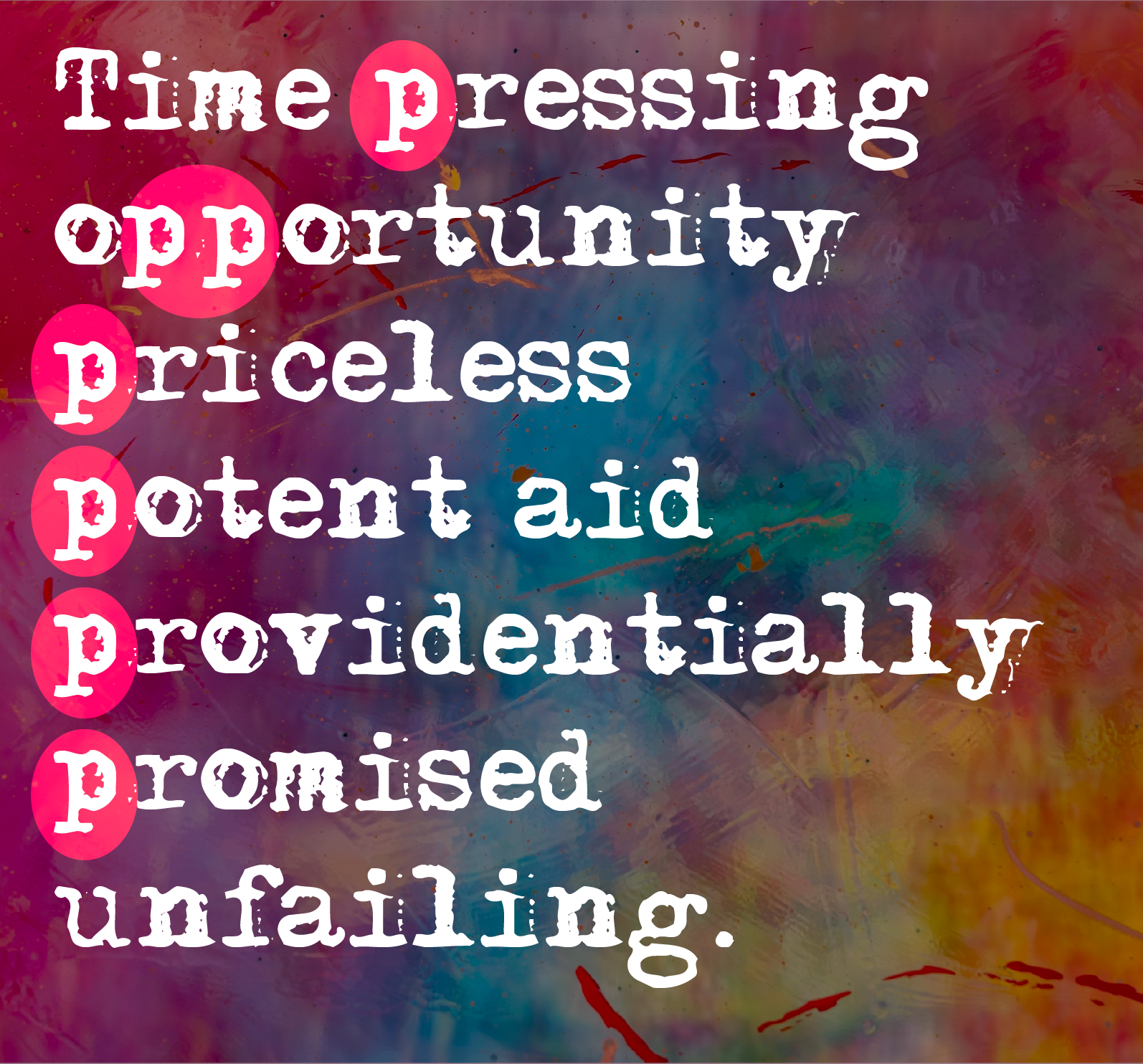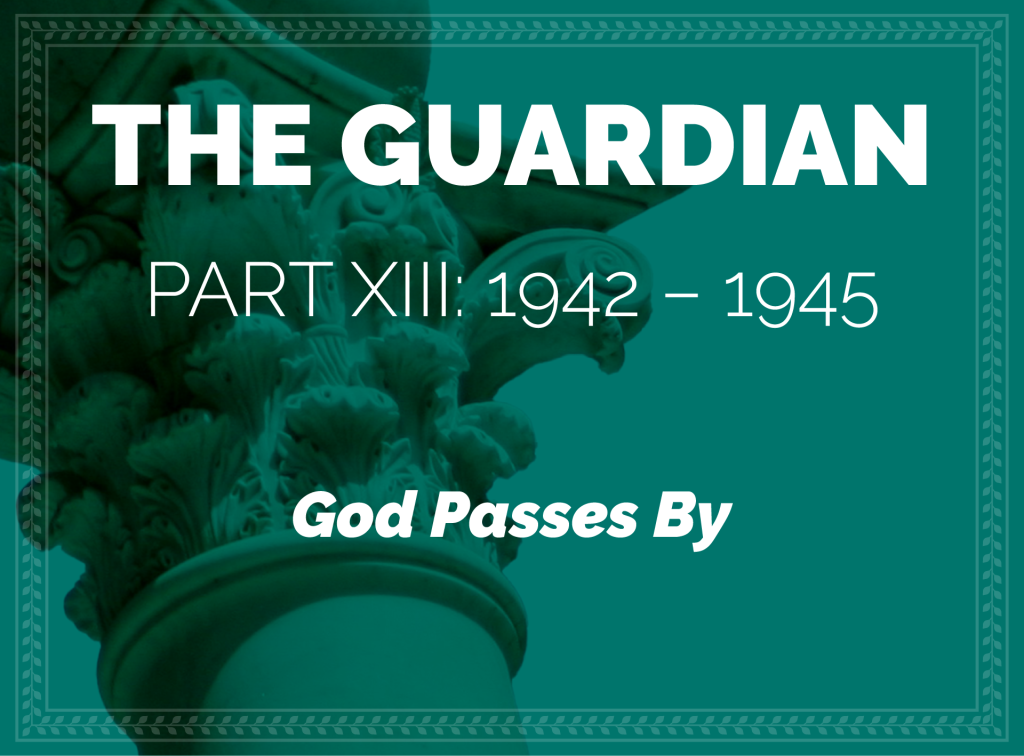
Written and illustrated by Violetta Zein
This part covers the life of Shoghi Effendi from the age of 45 in 1942 to the age of 48 in 1945.
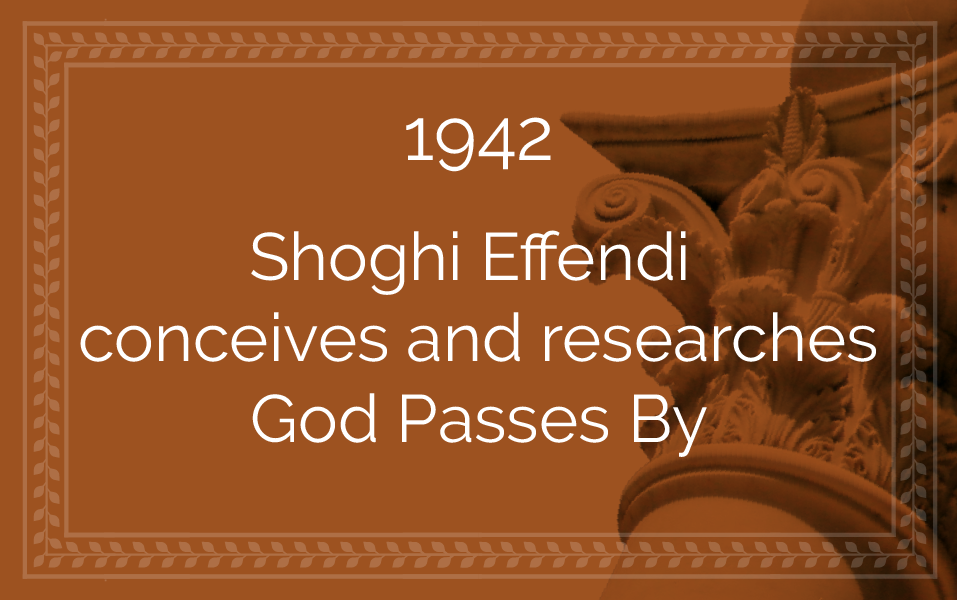

“100 years.” Most God Passes By graphics will use this custom-made background composed of every one of the 150 photographs in The Dawn-Breakers, and every black and white pre-1940 photograph on the website Bahá'í Media Bank, a total of 225 images in a 15 x 15 grid.
When Shoghi Effendi conceived the idea of what was to become God Passes By, the most befitting tribute for the Centennial—the triple centenary of the Bábí Dispensation, the first 100 years of the Bahá'í Cycle and the 100th anniversary of the birth of 'Abdu'l-Bahá—it was never his intention to write a detailed history of these awe-inspiring, thrilling first hundred years.
What the Guardian had in mind was a review.
In fact, in some of Rúḥíyyih Khánum’s diary entries for the years when Shoghi Effendi was writing God Passes By, she called the manuscript “this Centennial Review.” In his letters to his collaborator, George Townshend, Shoghi Effendi referred to the unnamed manuscript as the “survey.”
What Shoghi Effendi understood by “review,” was a sweeping panorama of the noteworthy, important features of the birth of the Bahá'í Faith and its rise, from Persia to the confines of the Ottoman Empire and Central Asia during the ministry of Bahá'u'lláh, to North America, Europe, Australia and South-east Asia during the ministry of 'Abdu'l-Bahá, and around the entire planet during the first two decades of the Formative Age—during the ministry of Shoghi Effendi, in fact, though he would never mention his name in the book.
Shoghi Effendi also intended to clearly delineate a very central theme to the entirety of God Passes By, namely the series of internal and external crises that, through the mysterious, spiritual release of Divine power within it, propelled the Faith forward from victory to victory.
The Guardian intended to cast his unerring eye on the majestic panorama of the Bahá'í Faiths’ first—dramatic, momentous, extraordinary, majestic—hundred years, and, in the way only the Expounder of the faith of Bahá'u'lláh could, interpret what had just happened.
Shoghi Effendi was planning to lift the curtain and shine the spotlight on the first four periods in the history of the Bahá'í Faith: the successive ministries of the Báb, Bahá'u'lláh, 'Abdu'l-Bahá, and the first epoch of the Formative Age. As Shoghi Effendi explains in the Foreword to God Passes By:
These four periods are closely interrelated, and constitute successive acts of one, indivisible, stupendous and sublime drama, whose mystery no intellect can fathom, whose climax no eye can even dimly perceive, whose conclusion no mind can adequately foreshadow.
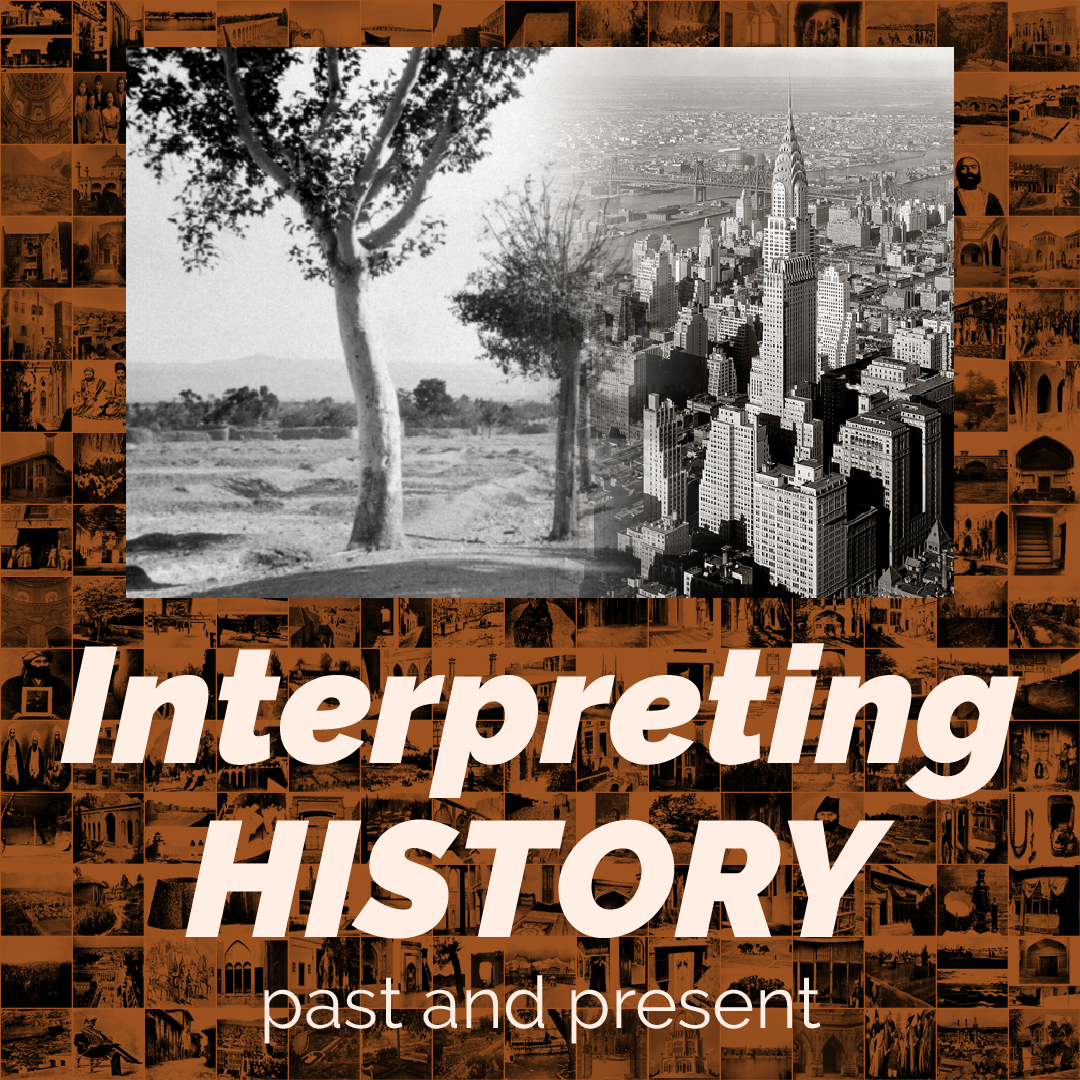
After twenty years of interpreting Bahá'u'lláh’s Holy Writings in translation, Shoghi Effendi was going to interpret the history of the Faith of Bahá'u'lláh. As the year 1944 was approaching, Shoghi Effendi, exhausted and overburdened in his 23rd year as Guardian of the Cause, found himself with an immensely daunting task ahead of him: how to befittingly mark the first century of the Bahá'í Era.
Shoghi Effendi’s self-imposed task was herculean, the conditions he would work under stressful beyond belief, the deadline he imposed on himself almost impossible, the occasion of the Centennial, never to be repeated.
The pressure on Shoghi Effendi was immense.
God Passes By would be the last major work the Guardian ever wrote. For the next thirteen years Shoghi Effendi neither translated nor wrote any more books.
God Passes By would be his grand opus, his masterpiece.

And yet despite all these pressures, for the first year of his work on the monumental project of God Passes By, Shoghi Effendi kept working.
He began to write his first and only book: God Passes By.
For the first year, Rúḥíyyih Khánum explained that Shoghi Effendi sat down and read every book.
Every book of the Bahá'í Holy Writings in Persian and English, published or unpublished, in manuscript form.
Every book written about the Faith by Bahá'ís.
Every single significant reference to the Bahá'í Faith he could find in regular books.
The Guardian read at least 200 books.
As Shoghi Effendi read, he made notes in his small notebooks, and as he made notes, he organized and structured his facts. Historical research is painstaking, it is grinding, repetitive, methodical work that requires constant attention and self-discipline, but also work that requires wisdom and discernment.
Often, the Guardian had to interpret history. He had to decide between two dates for the same event in two different sources which was the likeliest.
And then, once he had read all the sources, and taken all his notes, the real work of brining his brilliant idea to life began: the writing process.
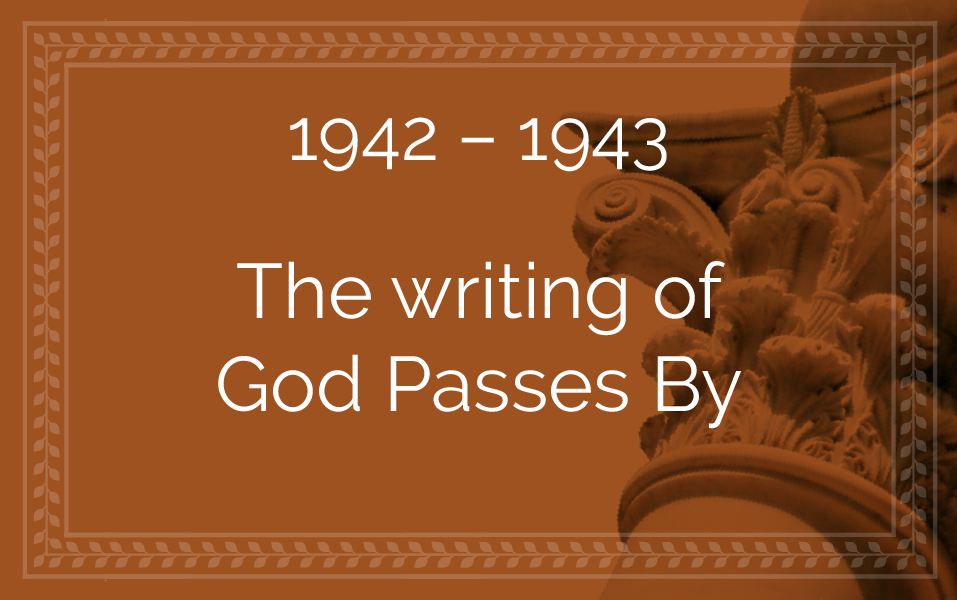
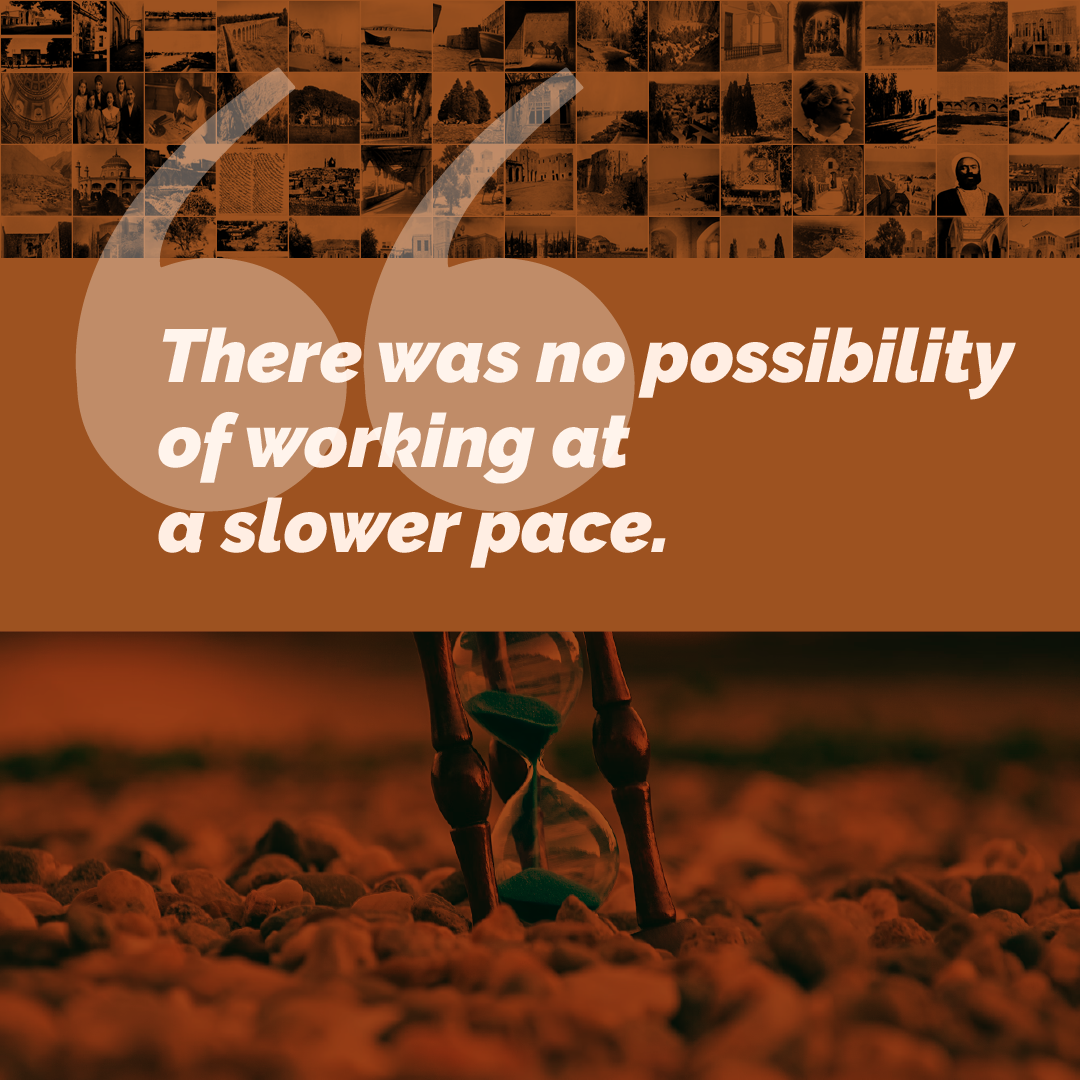
The circumstances under which Shoghi Effendi wrote God Passes By were a living nightmare.
It was the middle of World War II and danger—as we will see in the next story—sometimes directly threatened Shoghi Effendi, but beyond his personal safety, the years of the war were an almost unbearable stress for the Guardian, who worried for six years about the Bahá'í communities which were cut off from him, and he felt a great deal of anxiety about their safety, worries that would only be allayed once the war was over and communication was reestablished with the entire worldwide Bahá'í community.
Shoghi Effendi’s work environment was a pressure-cooker, as Rúḥíyyih Khánum describes the stress he was under, working to meet a hard deadline of 23 May 1944, the Centennial:
There was no possibility of working at a slower pace. he was racing against time to present the Bahá'ís of the West with this inimitable gift on the occasion of the one hundredth anniversary of the inception of their Faith.
Shoghi Effendi was exhausted after 20 years of Guardianship.
His family had all turned against him, Covenant-breakers one and all, and, in Rúḥíyyih Khánum’s words, they crushed “every ounce of spirit out of the Guardian.” Covenant-breaking was the only thing that ever made the Guardian truly physically ill.
At the same time as he was undertaking this herculean literary project, Shoghi Effendi was also planning the worldwide celebrations for the Centennial—in those countries that were able to hold celebrations—and making crucial regarding the design of the superstructure of the Shrine of the Báb.
So much pressure resting on the Guardian’s shoulders were at times unbearable, even to him. The Guardian could not delegate. He had to withstand the pressure, and do the work. No one else could, no one could help him or relieve his burden.

A Hawker Hurricane. Two of these planes crashed in the sky above Haifa and could have killed the Guardian. The debris of the plane landed 100 meters from the House of the Master. Both pilots were killed. Source: Wikimedia Commons.
On 20 March 1942, Shoghi Effendi was working on God Passes By when two Hawker Hurricane single-seat fighter planes of the 127 Squadron collided in mid-air over Haifa during training exercises. The planes lost control, crashed and burned.
One of the planes, as it was crashing, narrowly missed the Master’s house, where Rúḥíyyih Khánum and Shoghi Effendi were, and crashed at the lower end of their street, bursting into flames less than 100 meters away.
The Guardian could easily have been killed.
Both pilots, Second Lieutenant Charles Henry Gielink of the South African Air Force, 24, and Flying Officer John Lewis Ward of the British Royal Air Force Volunteer Reserve, 26, died in the crash.
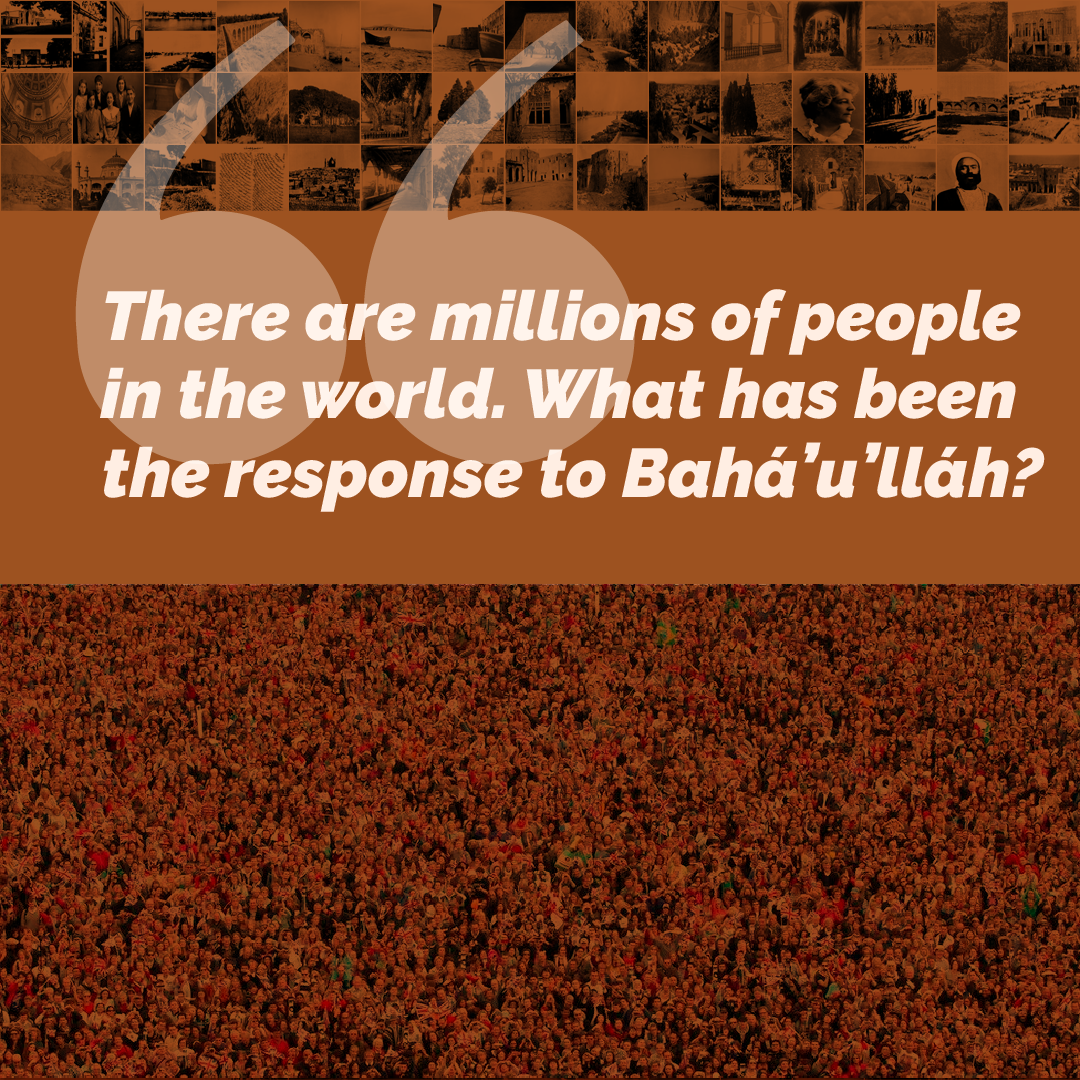
One day, Shoghi Effendi was translating out loud and Rúḥíyyih Khánum was in the room with him. It was a lifelong habit of the Guardian to always have another person in the room when he wrote or translated, it was something he loved to have. Rúḥíyyih Khánum had the bounty of being in the Guardian’s room while he wrote or translated for 20 years.
Suddenly, the Guardian read to Rúḥíyyih Khánum the words he had just stumbled upon:
If the Bahá’ís had been occupied with that which we had commanded, now the entire world would be clothed in the robe of faith
Rúḥíyyih Khánum was horrified and asked Guardian:
Shoghi Effendi, did Bahá’u’lláh mean it?
Shoghi Effendi responded:
Well, if he said it, if he wrote it, he must have meant it.
When did he write it?
In Baghdad.
This was something that was very much on the Guardian’s mind, and he despaired about it. He would often say to Rúḥíyyih Khánum, lamenting over the condition of the world:
Do you realize is over 100 years since Bahá’u’lláh appeared in this world and what has been the response to His message?
Rúḥíyyih Khánum, trying to cheer Shoghi Effendi up would quote his statistics back to him:
Oh Guardian just think of it there are 12 Spiritual Assemblies, National Assemblies, think of it, 12! ...And there are Bahá’ís in so many countries!
But the Guardian would look at Rúḥíyyih Khánum and say:
There are millions of people in the world. What has been the response to Bahá’u’lláh?
After this conversation, Rúḥíyyih Khánum stated that she never again felt comfortable. Bahá'u'lláh and the Guardian were, in essence, stating categorically that humanity had failed Bahá'u'lláh. It was a universal failure. And he stated it in Baghdad, which means, sometime between 1983 and 1863. The historical aspect of this devastating quote was what made Rúḥíyyih Khánum uncomfortable. If Bahá'u'lláh had said this during His own ministry, what would he say of humanity’s failure today?
Bahá'ís can never be complacent about their service. It is never enough.

The Guardian wove his notes and research together into a brilliantly-hued tapestry of the first 100 years of the Bahá'í Faith, a work which would become the foundation of all future Bahá'í histories and would forever be known as the crowning literary achievement of his ministry.
After the one year research process, Shoghi Effendi’s one year writing process was just as painstaking, methodical, and excruciating. He spent day after day, month after month, writing the manuscript out in longhand on his notebooks while he spoke it out loud, Rúḥíyyih Khánum in the room at all times, present for the birth of this work of genius.
Then, the Guardian wrote out a clean copy.
Almost a year later, in January 1943, Shoghi Effendi was still slaving over God Passes By. He was frustrated with his work when he entered Rúḥíyyih Khánum’s room, who tried to be helpful and suggested he read other historical books to find inspiration. Shoghi Effendi responded:
I have no time, no time. For twenty years I have had no time!
On 26 June 1943, George Townshend paid Shoghi Effendi a spiritually perceptive compliment:
I enclose the 7th instalment of the Survey. The work impresses me immensely and I foresee it will arouse great public interest and will be of the highest value in strengthening the faithful and stimulating their teaching work.

George Townshend, precious collaborator. Source: George Townshend by David Hofman, between pages 326 and 327.
The first time George Townshend heard of Shoghi Effendi’s new project was in a letter the Guardian wrote him dated 27 February 1942:
The Guardian has instructed me to write you on his behalf and to forward to you the enclosed pages for your perusal. He has been working for quite some time on a book to be published in conjunction with the Centenary Celebrations of our Religion in May 1944, and which would give, in relatively brief form, an outline of the most important phases and events in the evolution of our beloved Faith during its first hundred years.
The Guardian and George Townshend had a well-oiled literary partnership. The Guardian sent George Townshend typewritten pages, described their content and requested George Townshend focus his attention on certain issues or aspects.
George Townshend would live, breathe—and probably also dream—God Passes By for an entire and very intense year, from February 1943 to February 1944. He worked through very intense pain from arthritis in both his arms, and often could only work with his left hand. He made light of it in a lot of his letters from that time, telling his correspondents: “Not so bad with the left hand, is it?”
The Guardian wrote George Townshend 20 letters between 27 February and 11 August 1943 in which he included the typed pages of God Passes By as they became available, not in strict chronological order, and without correcting the typos. He was working alone, with no help, no typist, and no time. George Townshend offered Shoghi Effendi his editorial suggestions with his legendary tact and kindness.
The war-time delay between sending letters and batches of the manuscript back and forth were horrific, and Shoghi Effendi and George Townshend were forced to constantly send each other cables to determine which instalments had been sent and not yet received, in order to decide if they needed to send the package again. It made work very difficult.
On 26 June 1943, George Townshend paid Shoghi Effendi a spiritually perceptive compliment:
I enclose the 7th instalment of the Survey. The work impresses me immensely and I foresee it will arouse great public interest and will be of the highest value in strengthening the faithful and stimulating their teaching work.
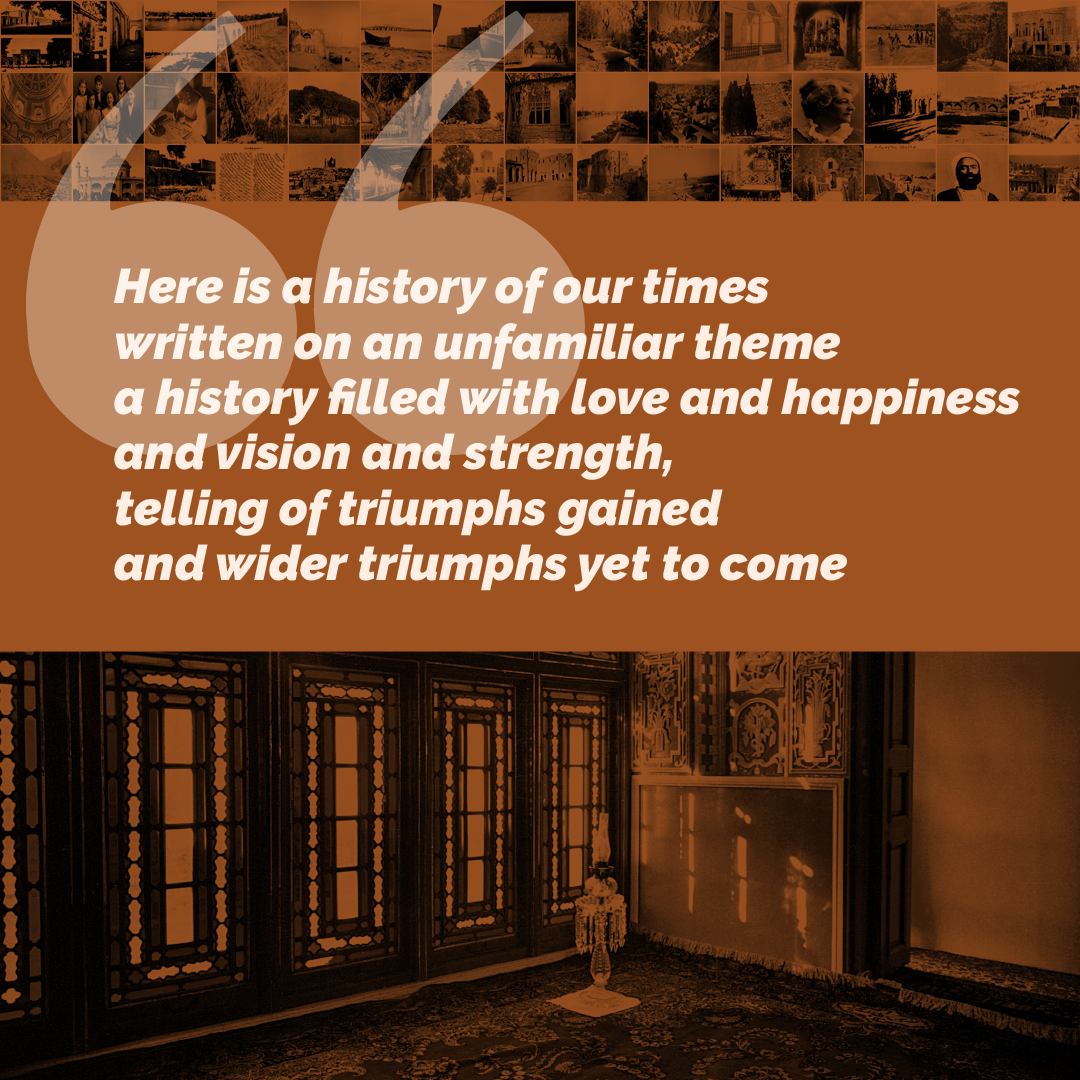
Shoghi Effendi asked George Townshend to write an Introduction to God Passes By, and George’s essay was a marvel. It is not included in current editions of God Passes By, but can be found online—here is a link. The entire introduction is beautiful, but George’s lyrical English shines in the opening sentence:
Here is a history of our times written on an unfamiliar theme a history filled with love and happiness and vision and strength, telling of triumphs gained and wider triumphs yet to come: and whatever it holds of darkest tragedy it leaves mankind at its close not facing a grim inhospitable future but marching out from the shadows on the high road of an inevitable destiny towards the opened gates of the Promised City of Eternal Peace.
NOTE: Current editions of God Passes By do not contain the introduction of George Townshend, beginning instead with the Guardian’s own Foreword. You can read George Townshend’s original introduction to the first edition of God Passes By here on Bahá'í Library Online.

A closeup of a Corona, the same kind of typewriter the Guardian typed all his letters and translations on, as well as the entire manuscript of God Passes By. Photo by Johnny Briggs on Unsplash.
Bahá'ís coming on pilgrimage often brought gifts. An Indian once brought six banana shuckers which 'Abdu'l-Bahá gave specific instructions to plant in ‘Adasiyyíh. The Bahá'ís were the first to successfully cultivate bananas in the Holy Land, and they are now a major crop in the region. Persian believers often brought priceless carpets, other Bahá'ís brought clothing, jewels or home furnishings, but 'Abdu'l-Bahá did not allow His family to keep any of these gifts.
There was one gift, however, 'Abdu'l-Bahá did accept.
On 16 November 1919, the Randall family—Harry, Ruth, and their 12-year-old daughter Bahíyyih—arrived on pilgrimage with a trunk filled with gifts for 'Abdu'l-Bahá, which included a typewriter for Shoghi Effendi, a pocket watch for 'Abdu'l-Bahá, yards of soft wool fabric for the Greatest Holy Leaf to sew into a coat for the Master.
The small, portable Corona brand typewriter would go down in Bahá'í history.
It was on this typewriter that Shoghi Effendi began typing his manuscript letters as 'Abdu'l-Bahá’s secretary in 1919-1920 using carbon paper to make multiple copies, and typing using his signature two-finger method.
The two-finger method is also called the “hunt and peck” approach. Touch-typing is the method by which you use all the fingers of your hand on allocated keys and can type up to 100 words a minute. Outwardly, of course, touch-typing seems preferable, because with the two-finger method, your attention is divided between your typed sheet and looking at your fingers. Over the long run, though, for someone who did as much typing as Shoghi Effendi, the two-finger method is less stressful on the tendons of your hand, specifically because it is much slower.
Shoghi Effendi used his Corona typewriter to type the translations of 'Abdu'l-Bahá’s Tablets to the West, and it was on this same Corona typewriter that he wrote all his letters to the Bahá'ís of the West from 1922 to 1957.
Every lengthy letter—Bahá'í Administration, Advent of Divine Justice, The Promised Day is Come—all his translations—the Kitáb-i-Íqán, Gleanings from the Writings of Bahá'u'lláh, Epistle to the Sone of the Wolf—all his books—The Dawn-Breakers and God Passes By—were typed on the Corona the Randalls offered him in 1919.
Shoghi Effendi was running out of black ribbons for his typewriter at one point in his early ministry, and he immediately cabled his brother in Beirut to send him some:
Send with sister ten Corona ribbons colour black.
When Shoghi Effendi was writing God Passes By he spent ten hours on end hammering out his masterpiece, converting it from longhand to multiple typed copies.
That Corona typewriter was the instrument that connected Shoghi Effendi to the world. Once the handwritten draft of God Passes By was completed, Shoghi Effendi began hammering away the typescript of the manuscript and his “majestic procession of chapters” with his signature two-finger method on his small, portable typewriter, sometimes 10 hours on end. When Shoghi Effendi was at full speed, Rúḥíyyih Khánum stated that he would type with four fingers. In the end, Shoghi Effendi would type up six carbon copies of God Passes By.
Shoghi Effendi burned through the summer of 1943, working so hard on the book that Rúḥíyyih Khánum felt she had never seen him work this hard during a vacation.
By November 1943, Shoghi Effendi had been working on the manuscript for almost two years, and repeatedly said to Rúḥíyyih Khánum:
This book is killing me.
Rúḥíyyih Khánum invariably answered:
Me too.
Finally, by the end of December 1943, an end was in sight.

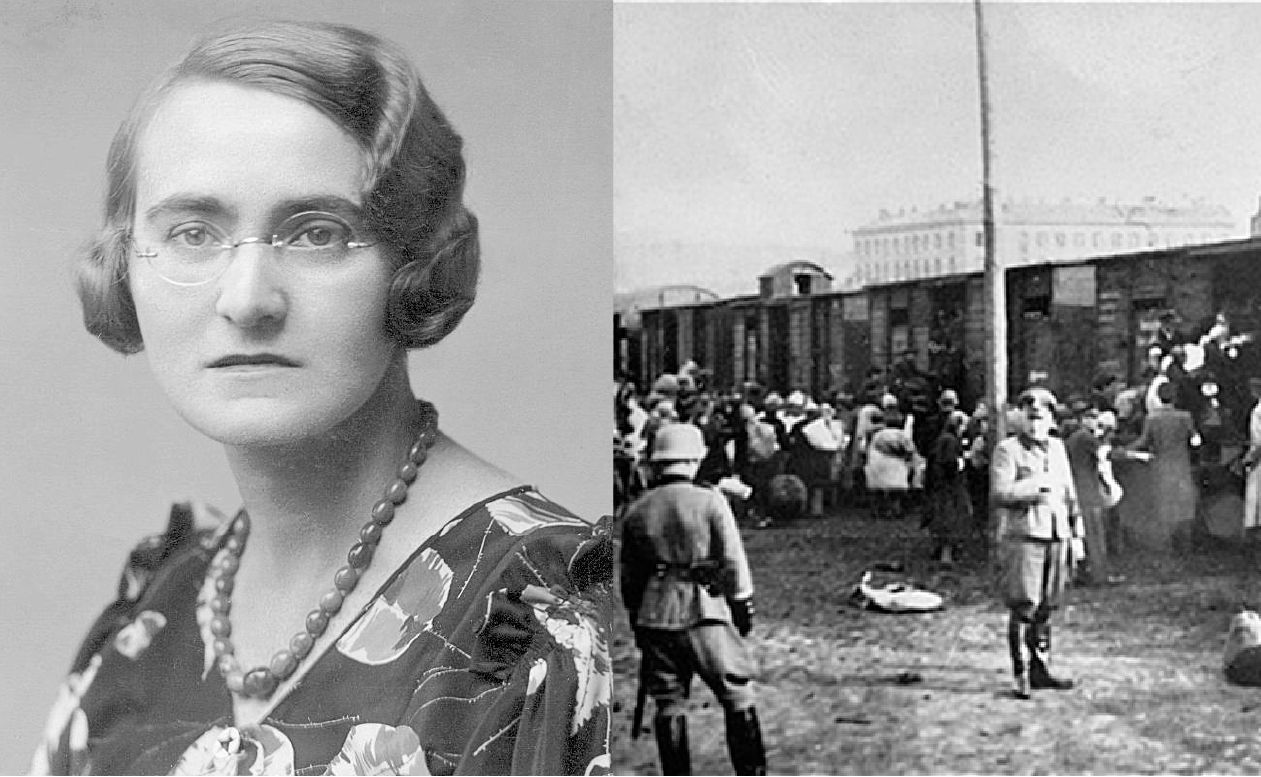
Lidia Zamenhof (1904–1942), youngest daughter of Ludwig Zamenhof, the creator of Esperanto. Source: Wikimedia Commons. Jews being loaded onto trains headed for the Treblinka extermination camp—the camp where Lidia Zamenhof was murdered—at the Umschlagplatz in Warsaw during the German occupation of Poland, sometime between 1942 and 1943. Source: Wikimedia Commons.
Lidia Zamenhof, born on January 1904, was a writer, publisher and the youngest daughter of L. L. Zamenhof, the inventor of Esperanto.
She dedicated her life to promoting Esperanto, the hope for a universal language in the world, a manmade language that was the easiest language to learn. She was a close friend of Martha Root, and became a Bahá'í in 1925 in Geneva, when Martha Root organized the Esperanto Congress in the offices of the International Bahá'í Bureau.
Lidia taught Esperanto around the world, in Europe and America until December 1938, when she returned to Poland.
Under the German occupation regime of 1939, her home in Warsaw became part of the Warsaw Ghetto. She was first arrested under the charge of having gone to the United States to spread anti-Nazi propaganda, but was released, and began providing others in the ghetto with food and medicine. She never accepted offers to help her escape, and faced her fate with great courage and remained firm in her Faith to the end.
In her last letter, she wrote to a friend:
Do not think of putting yourself in danger; I know that I must die but I feel it is my duty to stay with my people. God grant that out of our sufferings a better world may emerge. I believe in God. I am a Bahá’í and will die a Bahá’í. Everything is in His hands.
Lidia was exterminated at the Treblinka camp in the summer of 1942.
Four years after her murder, on 23 January 1946, the Guardian sent this message to the Bahá'ís in America:
Heartily approve nationwide observance for dauntless Lidia Zamenhof. Her notable services tenacity modesty unwavering devotion fully merit high tribute American believers. Do not advise however designate her martyr.

The completed monument, designed by W. S. Maxwell. The wings were Rúḥíyyih Khánum’s suggestion, for which she made the models. Source: Bahaimedia.
May Maxwell died in Buenos Aires, Argentina on 1 March 1940. After her Martyrdom, Shoghi Effendi invited William Sutherland Maxwell to come and live with him and Rúḥíyyih Khánum in Haifa. They left the Holy Land in the spring of 1940 and after a seven-month journey spanning three continents, they were back in December of that year.
One year after his return, still grieving his catastrophic loss, William Sutherland Maxwell had completed the design for her monument. The Guardian asked Amelia Collins to supervise its construction.
William Sutherland Maxwell had not designed a family monument. The memorial he had created was for a heroine of the Faith whose entire body and soul, her life from the moment she became a Bahá'í, was dedicated to Bahá'u'lláh. William Sutherland Maxwell did not create this magnificent tribute alone. It was Rúḥíyyih Khánum who designed the wings, because she always believed her mother’s grave should be adorned with wings, and it was Shoghi Effendi’s contribution to add vases on the sides of the memorial because he felt it was too bare.
Four years after May Maxwell’s martyrdom, Shoghi Effendi remembered her in his 1944 masterpiece on the first century of the Bahá'í Faith, God Passes By:
Nor was this gigantic enterprise destined to be deprived, in its initial stage, of a blessing that was to cement the spiritual union of the Americas – a blessing flowing from the sacrifice of one who, at the very dawn of the Day of the Covenant, had been responsible for the establishment of the first Bahá’í centers in both Europe and the Dominion of Canada, and who, though seventy years of age and suffering from ill-health, undertook a six thousand mile voyage to the capital of Argentina, where, while still on the threshold of her pioneer service, she suddenly passed away, imparting through such a death to the work initiated in that Republic an impetus which has already enabled it, through the establishment of a distributing center of Bahá’í literature for Latin America and through other activities, to assume the foremost position among its sister Republics.

The House of ‘Abbúd, which the Guardian allowed the city of Haifa to use as a temporary location for a school in 'Akká during the War, free of charge. Source: Bahaimedia.
Throughout his Guardianship, Shoghi Effendi followed in the footsteps of Bahá'u'lláh and 'Abdu'l-Bahá, who were both known as “The Father of the Poor,” Bahá'u'lláh in Ṭihrán in the first nine years of his marriage to Ásíyih Khánum, and 'Abdu'l-Bahá in for his 40 years of service to the residents of 'Akká.
Whenever the district commissioner under the British mandate, or the municipalities of 'Akká and Haifa, in the time of the State of Israel, needed either cooperation or financial assistance, the Guardian offered it generously.
In the early days of his ministry, on 7 February 1923, the Guardian spontaneously offered a contribution of £20—£1,500 today—for the poor in Haifa.
Two years later on 16 February 1925, the Guardian offered the same generous amount to Colonel Symes for the establishment of the Haifa Charitable Fund.
In April 1926, Shoghi Effendi offered £30 as his contribution for the poor and homeless of the Northern District of Palestine.
On 7 May 1929, Shoghi Effendi contributed £50 for the prevention of begging in Haifa, with an explanation that begging was prohibited in the Bahá'í Faith.
In 1934, the District Commissioner for the northern District thanked Shoghi Effendi for his "most generous contribution towards the relief of distress in Tiberias" and for his kind message of sympathy.
In 1950, the Guardian offered £500—the value of £21,000 in today’s currency—for the relief of the poor and needy in Haifa.
Between 1940 and 1952, the Guardian donated over $10,000—$116,000 in today’s currency—to charitable causes, and to alleviate the hardships and living conditions of the poor, even contributing money to a charity connected to a mosque in Haifa, the government psychiatric hospital in 'Akká, located in the former barracks of the Most Great Prison, or a spontaneous contribution towards the construction of the Institute of Physics.
In 1952, Aba Khoushy, the Mayor of Haifa, wrote the Guardian that a country-wide symposium on Problems of Illuminations was going to take place at the Technical College in Haifa, and, because it coincided with Hanukkah, the Jewish Feast of Lights, he asked if Shoghi Effendi would consider illuminating the Shrine of the Báb on Mount Carmel between 12 and 19 December 1952.
The Guardian replied he would be “happy to co-operate in making the city of Haifa luminous and beautiful, in connection with the Symposium to be held at the Hebrew Technical College,” and gave instructions for the period of illumination of the Shrine to be extended during the days of the conference. He also invited the participants to visit the Shrine of the Báb and its gardens.
Perhaps the most significant charitable contribution was not a financial one, but a gesture of deep empathy on the Guardian’s behalf, connected to a cherished Holy Place of our Faith.
In 1943, the 'Akká District Commissioner wrote to Shoghi Effendi that he could not find a place to house a school, and was willing to pay rent and lease eight rooms in the House of ‘Abbúd, in the heart of 'Akká, a home where Bahá'u'lláh had lived and revealed the Kitáb-i-Aqdas, where 'Abdu'l-Bahá had lived for decades, and where Ásíyih Khánum had passed away.
The Guardian allowed the school to use the rooms.
He refused to take payment.
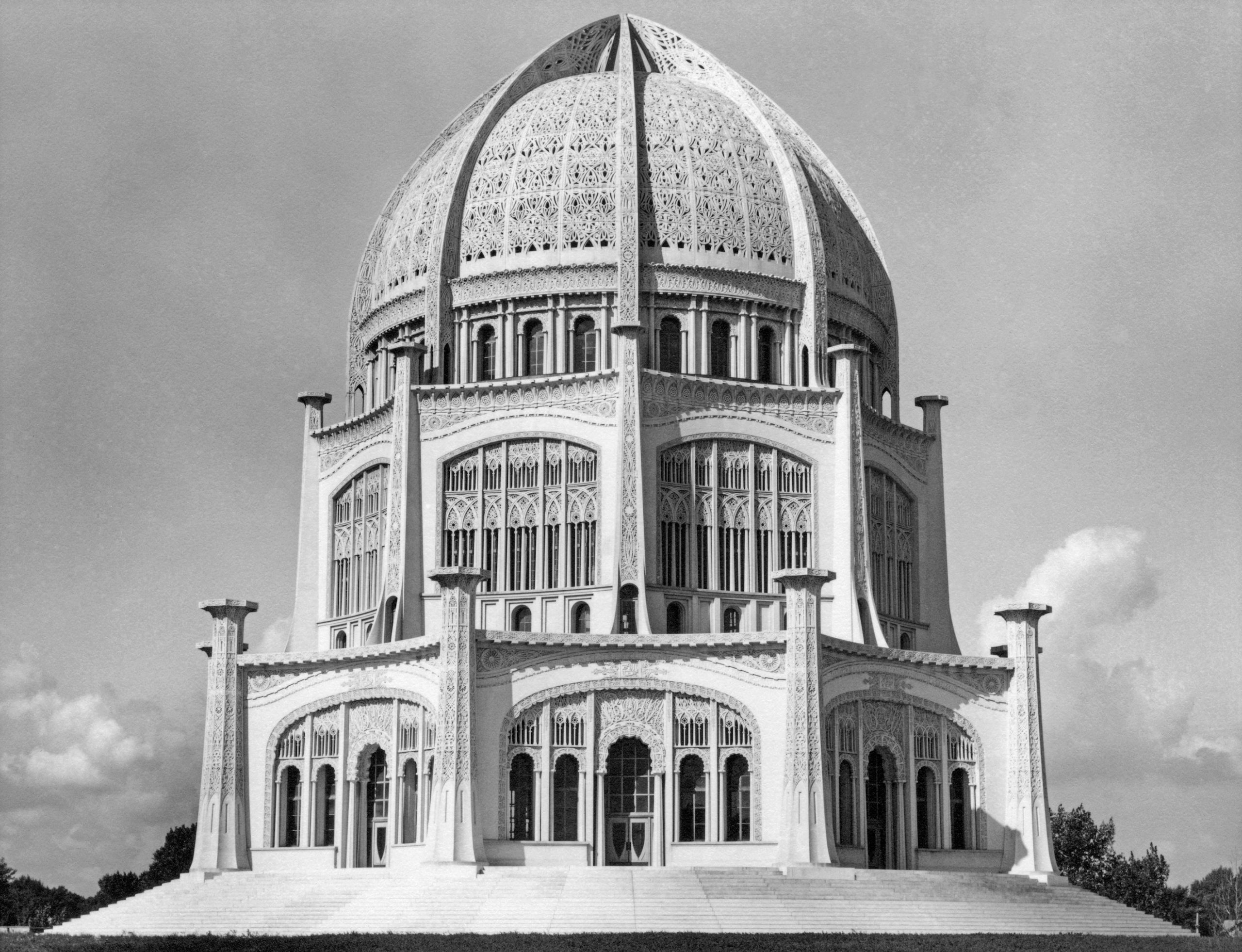
The extraordinarily delicate, lace-like exterior ornamentation of the House of Worship of North America, completed as one of the main goals of the First Seven Year Plan. Source: Bahá'í Media Bank, © Bahá'í International Community 2023.
During World War II, more than 50 countries deployed over 100 million soldiers and laid waste to entire swaths of the planet, massacring millions of innocent civilians.
During the same time, Shoghi Effendi, aided by a handful of devoted Bahá'ís won everlasting spiritual victories on an entire continent, bringing happiness to thousands, and achieving all three of the Guardian’s goals for the first Seven Year Plan, all in a time of world conflict.
American Bahá'ís doubled the number of Local Spiritual Assemblies in North America, established at least one Local Spiritual Assembly in each of the states of the United States, and each province of Canada, and completed the very expensive exterior ornamentation of the North American House of Worship.
And they reached these two goals 16 months ahead of time.
In terms of the third goal, they established a strong Bahá'í group in each of the 20 countries in Central and South America, as well as 15 Local Spiritual Assemblies in the region.
Shoghi Effendi generously showered his pride, admiration, and gratitude on the Bahá'ís of the United States and Canada in a letter called “Unconquerable Power,” dated 12 August 1941.
In this letter, the Guardian expresses his gratitude at three accomplishments, the completion of the North American House of Worship, the steady expansion and consolidation of the Faith, and the spirit with which the Bahá'í community has faced and resisted its enemies.
The letter begins with this majestic sentence:
As I survey the activities and accomplishments of the American believers in recent months, and recall their reaction to the urgent call for service, embodied in the Seven Year Plan, I feel overwhelmed by a threefold sense of gratitude and admiration which I feel prompted to place on record, but which I cannot adequately express. Future generations can alone appraise correctly the value of their present services, and the Beloved, Whose mandate they are so valiantly obeying, can alone befittingly reward them for the manner in which they are discharging their duties.

Leroy Ioas standing next to some of the exquisite panels for the ornamentation of the Baha'i House of Worship in Wilmette, Illinois during its construction. Source: Brilliant Star Magazine.
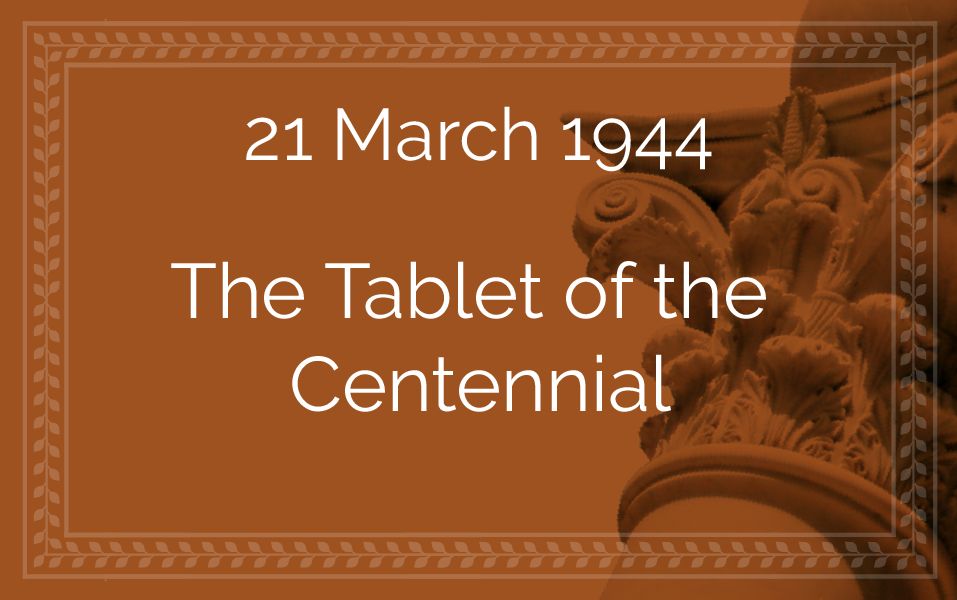
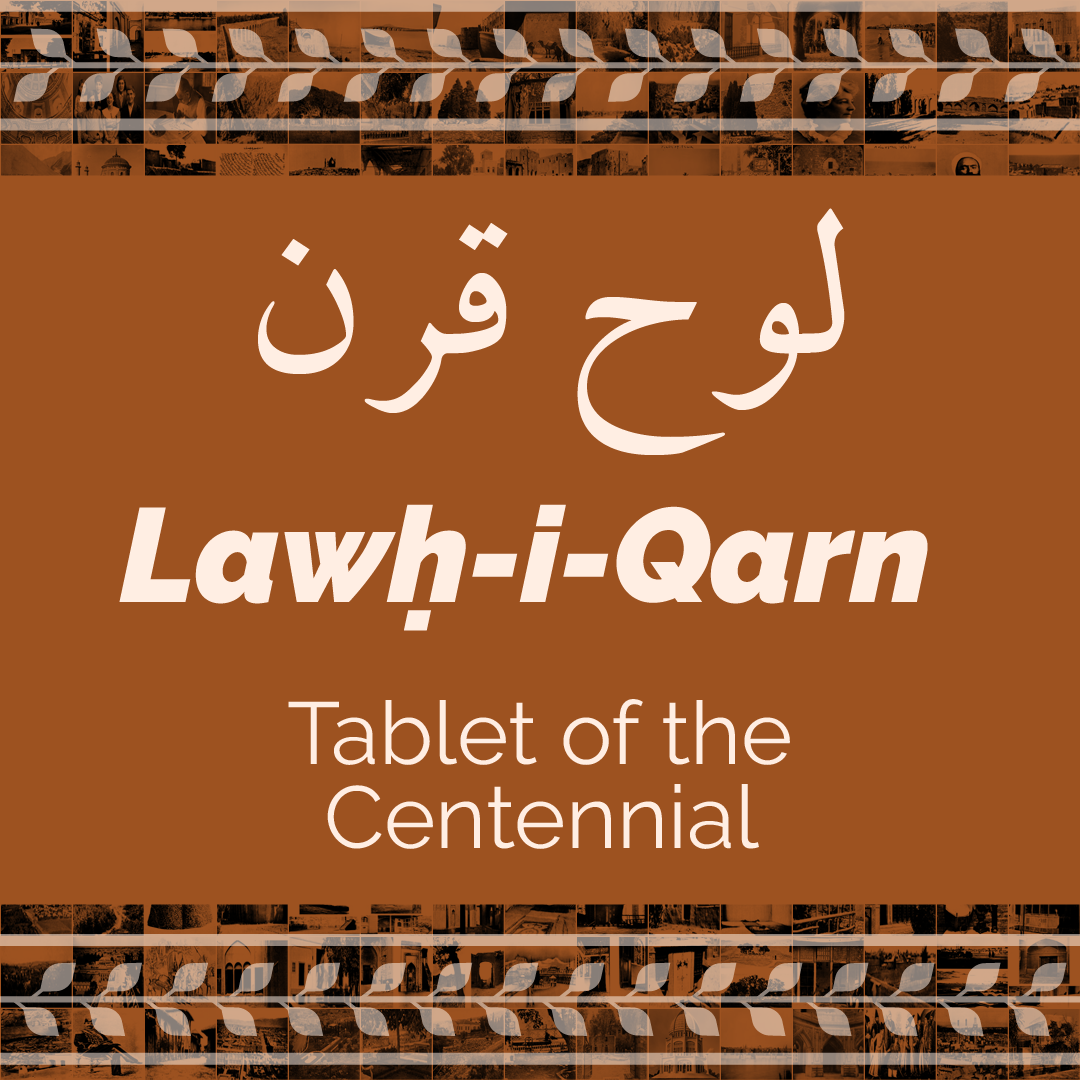
As soon as the Guardian completed his monumental achievement of God Passes By, his very first thought was for the Bahá'ís in Iran, Bahá'u'lláh’s long-suffering and persecuted followers in His native land.
Shoghi Effendi began composing a one-hundred-year survey of the history and achievements of the Bahá'í Faith in Iran, the cradle of the Faith in the form of a lengthy and momentous letter to the Iranian Bahá'í community on the occasion of Naw-Rúz 101 B.E. (1944). The Tablet, however was not sent to the Bahá'ís in Iran on Naw-Rúz, but rather solemnly read at Riḍván, in a solemn pilgrimage ceremony at the House of the Báb in Shíráz. That story can be found in the section on the Centennial commemoration in Shíráz, on 23 May 1944
This letter has become known by Bahá'ís as Lawḥ-i-Qarn (لوح قرن), which means "Tablet of the Centennial,” which is how we will refer to it, but it is important to know that this was not a title Shoghi Effendi gave to his Naw-Rúz letter. The Guardian’s written Persian was high, classical, and sprinkled with Arabic and as different to spoken Persian as spoken English is to Shakespeare.
Shoghi Effendi would chant passages of Tablet of the Centennial to Rúḥíyyih Khánum, in his plaintive, painfully beautiful voice, and, like in English, his words flowed majestically, and their perfection and power was obvious to her, even if she only understood three words of out ten.
Sometimes, Shoghi Effendi hit a block, a word he couldn’t gracefully fit into the sentence, for example, and he would stop chanting. Then, he would start chanting that sentence from the start, and would continue, repeat, chant and chant again until he found a way to fit the word or express the end of the thought, and then he would continue.
This is Rúḥíyyih Khánum describes this beautiful process of the Guardian chanting while composing:
It was like some wonderful bird trying out its melodies to itself, lost in its own world.

Two of the greatest contemporary scholars of Persian literature, Badiozzaman Forouzanfar (Wikimedia Commons) and Saeed Nafisi (Wikimedia Commons) who considered Shoghi Effendi’s Tablet of the Centennial an achievement in Persian literature.
The Tablet of the Centennial, like God Passes By, addresses the stunning 100 years of the history of the Bahá'í Faith, a history that defied persecution and oppression with tales of victory after victory, a history of spiritual joy, love and the growth of the Faith from a small band of Persian believers to a world-embracing four-continent-spanning vibrant community with worldwide Administrative Order.
Like its English counterpart, God Passes By, the Tablet of the Centennial was a vehicle showcasing the Guardian’s extraordinary interpretive capacity applied to the history of the Faith of Bahá'u'lláh, and to its Mission and apogee: the establishment of the Kingdom of God on earth.
The differences between God Passes By and the Tablet of the Centennial lie in their presentation. First, of course, the language. God Passes By was in English, and the Tablet of the Centennial was written in mixed Persian and Arabic. Second, the length. The Tablet of the Centennial ran nearly 28,000 words, one sixth of the word count of God Passes By. Third, the form. God Passes By was a published book, and the Tablet of the Centennial was a letter written to the Bahá'ís of Iran on the occasion of Naw-Rúz 1944, the first Naw-Rúz immediately following the 100 years of the Bahá'í Faith, the Bahá'í Year 101.
The Tablet of the Centennial is a masterpiece, acclaimed by two of the greatest contemporary scholars of Persian literature, Badiozzaman Forouzanfar and Saeed Nafisi, who considered Shoghi Effendi’s Tablet of the Centennial an achievement in Persian literature.
The Tablet of the Centennial is to Persian literature what God Passes By is to English literature. The eminent Bahá'í scholar ʻAbdu'l-Ḥamíd Ishráq-Khávari devoted two volumes of commentary on the Lawḥ-i-Qarn (Tablet of the Centennial).
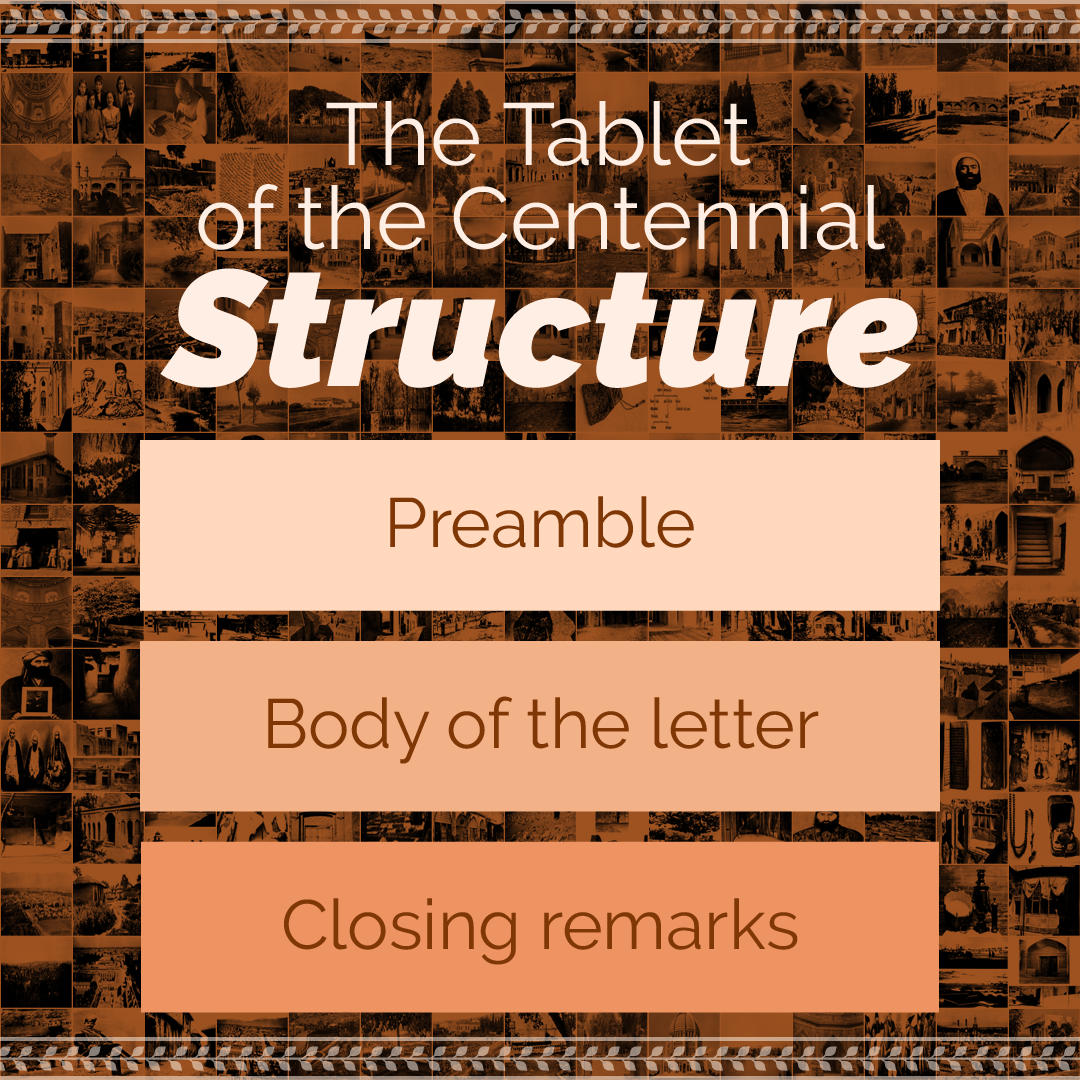
The Tablet of the Centennial is composed of a preamble, the body of the letter, and closing remarks.
The Guardian wrote the preamble to the Tablet of the Centennial entirely in Arabic, three pages of rare and exceptional beauty and poetic eloquence, in which Shoghi Effendi—in an homage to traditionally eastern etiquette of deep respect—first begins expressing salutation and praise to the names and attributes of God.
Shoghi Effendi’s preamble in Arabic is rhythmic, and, when read aloud, emits what Hand of the Cause Muḥammad Varqá describes as “a musical vibration,” beckoning the reader not to peruse the passage silently, but rather to chant it, and when chanted, the musicality of Shoghi Effendi’s Arabic, in Mr. Varqá’s words, becomes “a symphony that fills heart and soul, and when one begins to read them, one relishes, one savours every word..”
After this initial section, Shoghi Effendi lists not only The Báb’s, Bahá'u'lláh’s and 'Abdu'l-Bahá’s titles in the Bahá'í tradition, but also the titles and characterizations that apply to them from the prophecies of past religious Dispensations. These characterizations are short, and most of them are only two or three words long. In total, the Guardian characterizes Bahá'u'lláh with 36 titles and attributes, the Báb with 29, and 'Abdu'l-Bahá with 16.
Shoghi Effendi concludes the preamble by offering his wishes to the Iranian Bahá'í community and all those who arise to serve and assist the Faith of Bahá'u'lláh.
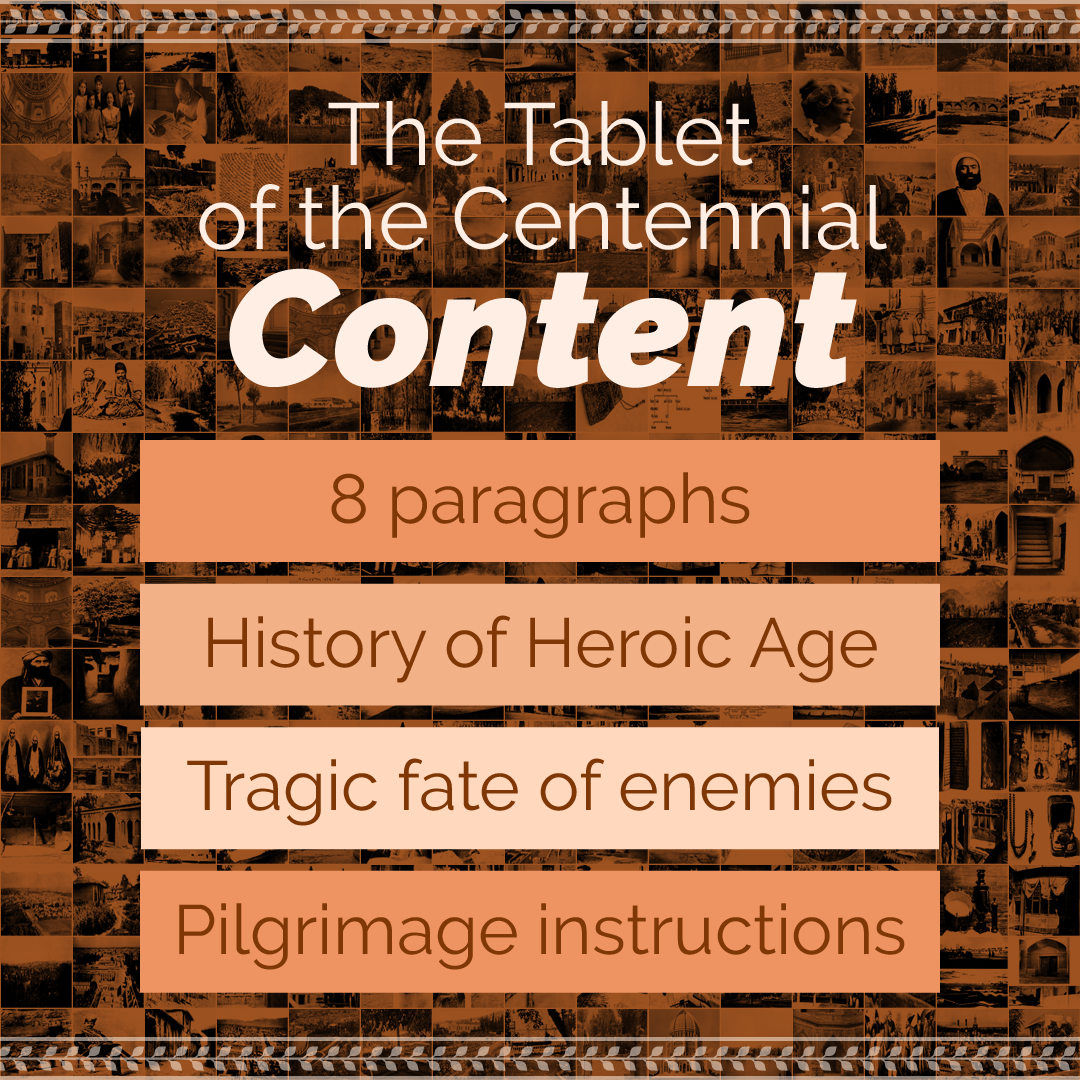
The content of the body of the letter is six pages in which the Guardian describes the importance of the first century of the Bahá'í Dispensation, including 8 paragraphs which begin with the same blessing:
How great the blessedness that pertains to this wondrous, this most marvellous century.
The next section of the Tablet of the Centennial recalls Shoghi Effendi’s writing in God Passes By: he draws a skillful and magisterial panorama of the history and development of the faith of Bahá'u'lláh, a magnificent procession of the events unfolding over the period of a hundred years.
The Guardian briefly draws a sketch of the key events of the ministries of the Báb, Bahá'u'lláh, and 'Abdu'l-Bahá.
Some of the events the Guardian mentions in the Báb’s Ministry are His Declaration, the Letters of the Living, their missions, the Báb’s pilgrimage to Mecca and Medina, his return and subsequent persecutions, His imprisonment in Máh-Kú and Chihríq, and finally His martyrdom.
The Guardian then describes Bahá’u’lláh’s ministry and His persecutions, His efforts to reunite and guide the disciples of the Báb, His imprisonment, His Revelation in the Siyáh-Chál, His exile to Baghdad, His self-imposed seclusion in Sulaymáníyyih, His return to Baghdad and His Declaration in the Garden of Riḍván, the inauguration of the Bahá'í Dispensation, and His last three exiles to Istanbul, Edirne and 'Akká, the intrigues of the Covenant-breakers, and His Revelation of the Kitáb-i-Aqdas.
When describing the ministry of 'Abdu'l-Bahá, the Guardian speaks about His Station as the Centre of the Covenant and His superhuman efforts in the expansion of the Faith of his Father throughout the globe, as well as His legacy-defining Journeys to the West.
Shoghi Effendi also details the tragic fate which all the enemies of the Bahá'í Faith suffered in the end.
At the end of this message, the beloved Guardian gave instructions for the pilgrimage of the Bahá'í friends in Iran, which took place at the exact time of the centennial, and in the exact room the Declaration took place.
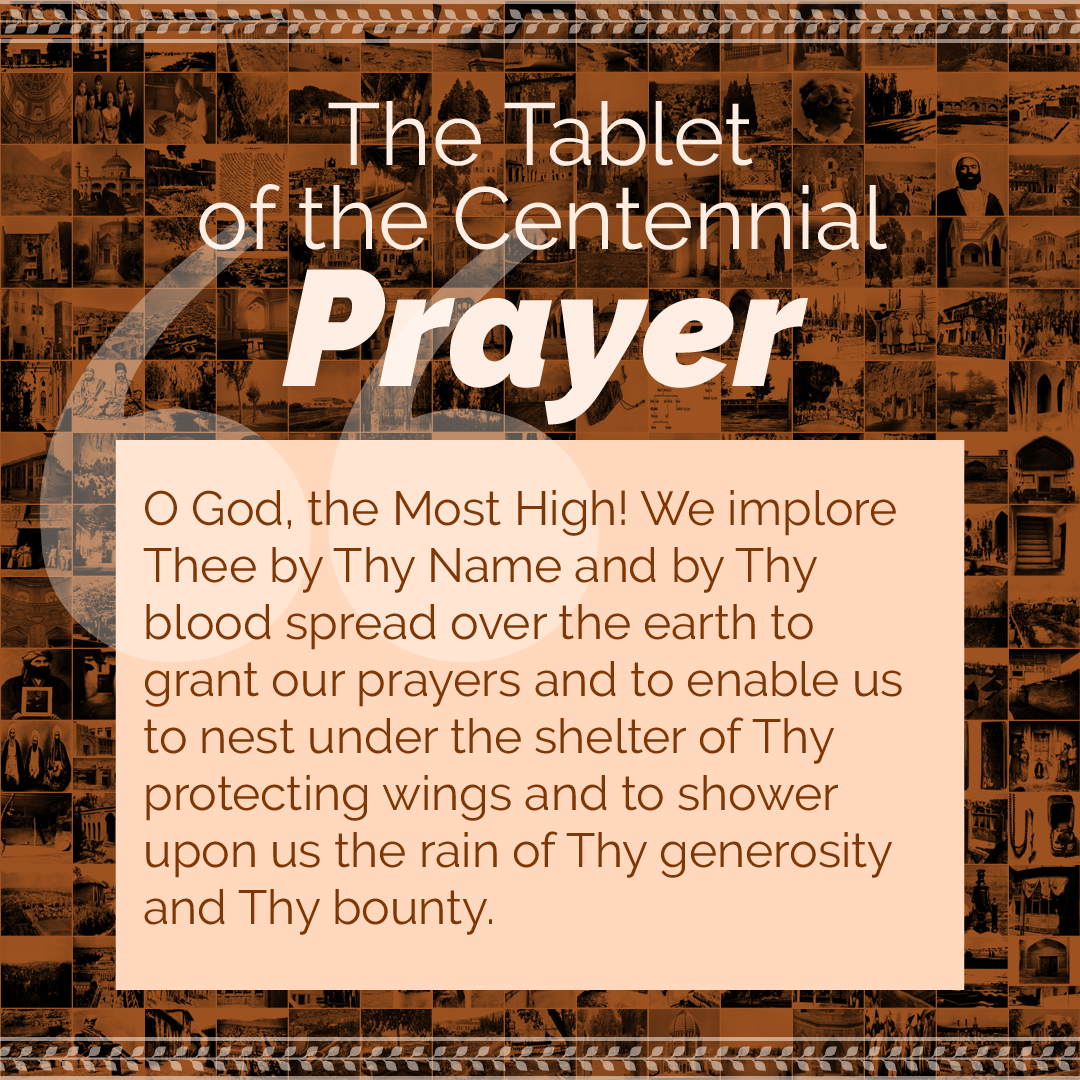
The Guardian closes the Tablet of the Centennial with a beautiful prayer he revealed addressed to the Báb, Here is a provisional translation of this prayer by Dr. Khazeh Fananapazir:
O God, the Most High! We implore Thee by Thy Name and by Thy blood spread over the earth to grant our prayers and to enable us to nest under the shelter of Thy protecting wings and to shower upon us the rain of Thy generosity and Thy bounty. Assist and aid us to follow Thy path for love of Thee and draw us nigh unto the chord of Thy faithfulness and confirm us in Thy love and in the promulgation of Thy Message.
Preserve us from the darts of them that have denied Thee. Aid us to follow the pathway of Thy Will and to proclaim the Faith of Thy Best-Beloved, the Most Glorious, He in Whose path thou hast sacrificed Thyself, and for the sake of Whose love Thou hast wished for martyrdom.
Deliver us, O our Best Beloved, the Exalted, the Most High. Encourage us and make firm our steps. Forgive us our sins and expiate our trespasses, unloose our tongues, so that we may lift our voices and from our lips may flow Thy praise. Crown our deeds and our labours with the diadem of Thy grace. Make the end of our lives like unto that which Thou didst bestow on the faithful among Thy servants. We supplicate unto Thee to count us among them who have turned their faces unto Thee and have arisen in Thy service.
Intoxicate us with the glory of Thy presence, and render us immortal in the gardens of Thy holiness. Grant us the grace and bountiful favours of Thy heavenly Kingdom, O Thou Saviour of the world.
The servant at His threshold,
Shoghi

This is a perfect example of the difference between Shoghi Effendi’s eastern and western literary style. Please note this is a provisional translation by Dr. Khazeh Fananapazir.
In the following two paragraphs, the Guardian addresses himself to the night of the Báb’s Declaration herself in the most eloquent, love-filled invocations, expressions of mystical joy and communion, unlike anything the Guardian ever wrote in English:
O sacred and holy Night! Upon thee be the most perfect and most glorious greetings! Upon thee be the purest and most radiant salutations!
O solace of the Eye of Creation! O joyous Commencement of the Days of God! O Dawn of the most glorious and honoured Age and inception of the sacred and majestic Century!
Because of thy revelation, O Night, the most great portals were opened unto the face of creation, the most concealed Mystery did reveal Itself, the Most Pre-existent Light did shine forth. Through Thee the Straight Path was outstretched, and the breezes of life-giving Spirit were wafted forth unto all the nations.
Because of remembering Thee, Abraham, the Friend of God would rejoice in His inmost heart, and Moses the Interlocutor would be glad in His inmost being, and Jesus Christ the Spirit of God would be enthralled with His entire being, and Muḥammad the loved One would bestir Himself.
Because of Thy Advent the Concourse on High were joyous, and hallelujah’s of joy were raised from the cherubim, the saints, and the angels nigh unto God. Through Thee all earth and all the heavens were illumined, and in Thee all nights were resurrected, and from Thee all days sought light. The Night of Power circumambulated Thee. Because of thy advent, O Night, the Countenance of Existence wreathed into a smile!

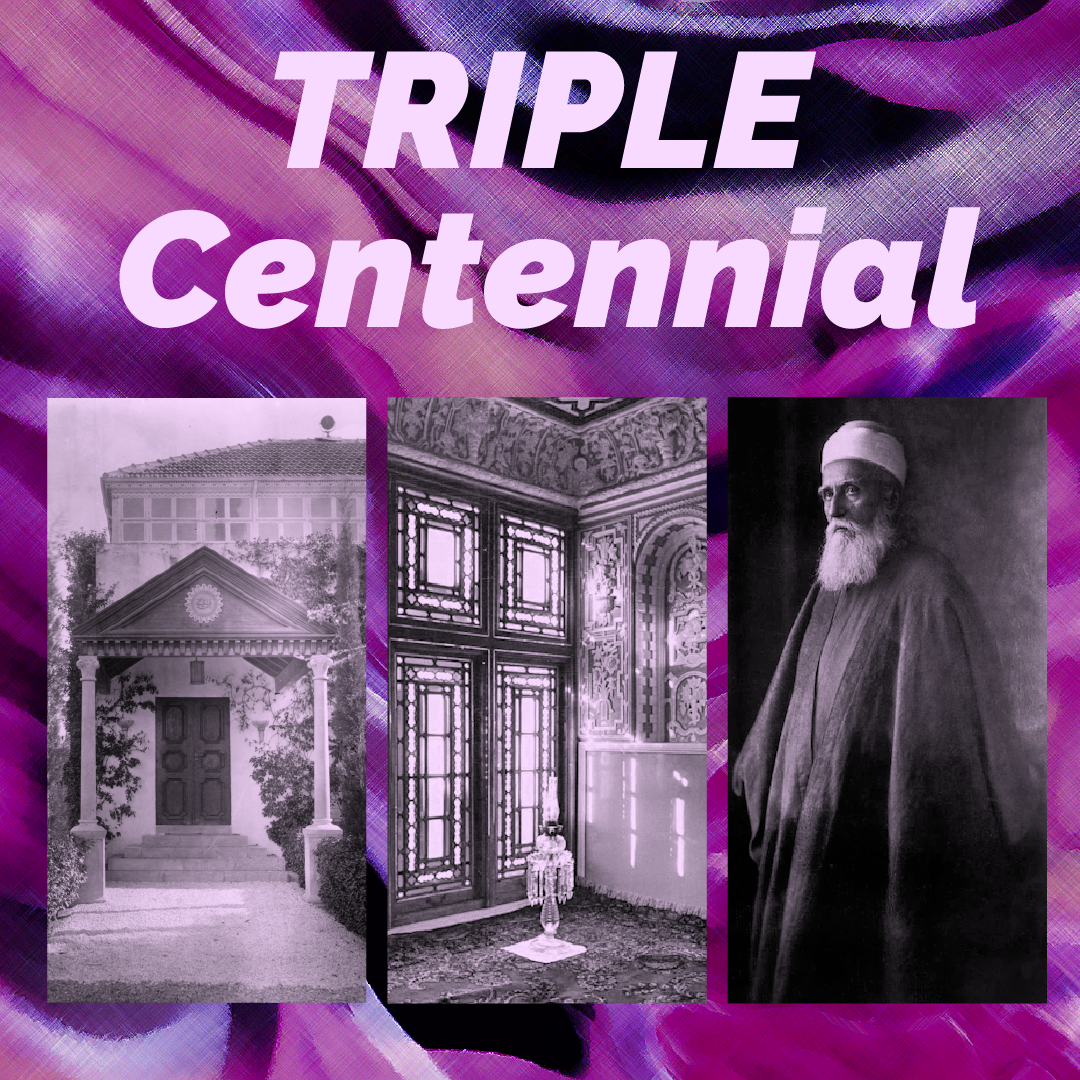
During Shoghi Effendi’s ministry, there were three major centenaries which were celebrated throughout the world: the triple centenary of the Declaration of the Báb in 1944, the centenary of the Martyrdom of the Báb in 1950, and the centennial of Bahá'u'lláh’s Revelation in 1952.
The first centenary, was celebrated on 23 May 1844 and it was a triple centennial:
- It was the one-hundredth anniversary of the Declaration of the Báb.
- It was also the centenary of the birth of 'Abdu'l-Bahá.
- And lastly, it was the 100 years of the inception of the Bahá'í Cycle.
In the next few sections, we will honor the Bahá'í communities that were able to celebrate the Centennial:
First, of course at the Bahá'í World Centre, in the Holy Land.
Second, in Iran, in the cradle of the Faith, where the Guardian planned elaborate commemorations for the Centennial and the previous evening. Large and small communities in Iran organized marvelous celebrations, and we will also be looking briefly at those.
The seven other stalwart Bahá'í communities that had the privilege of organizing Centennial celebrations were of course first the two oldest Bahá'í communities in the West, the United States and Canada and the United Kingdom, and in alphabetical order: Australia, Egypt, India, Iraq, and Latin America.
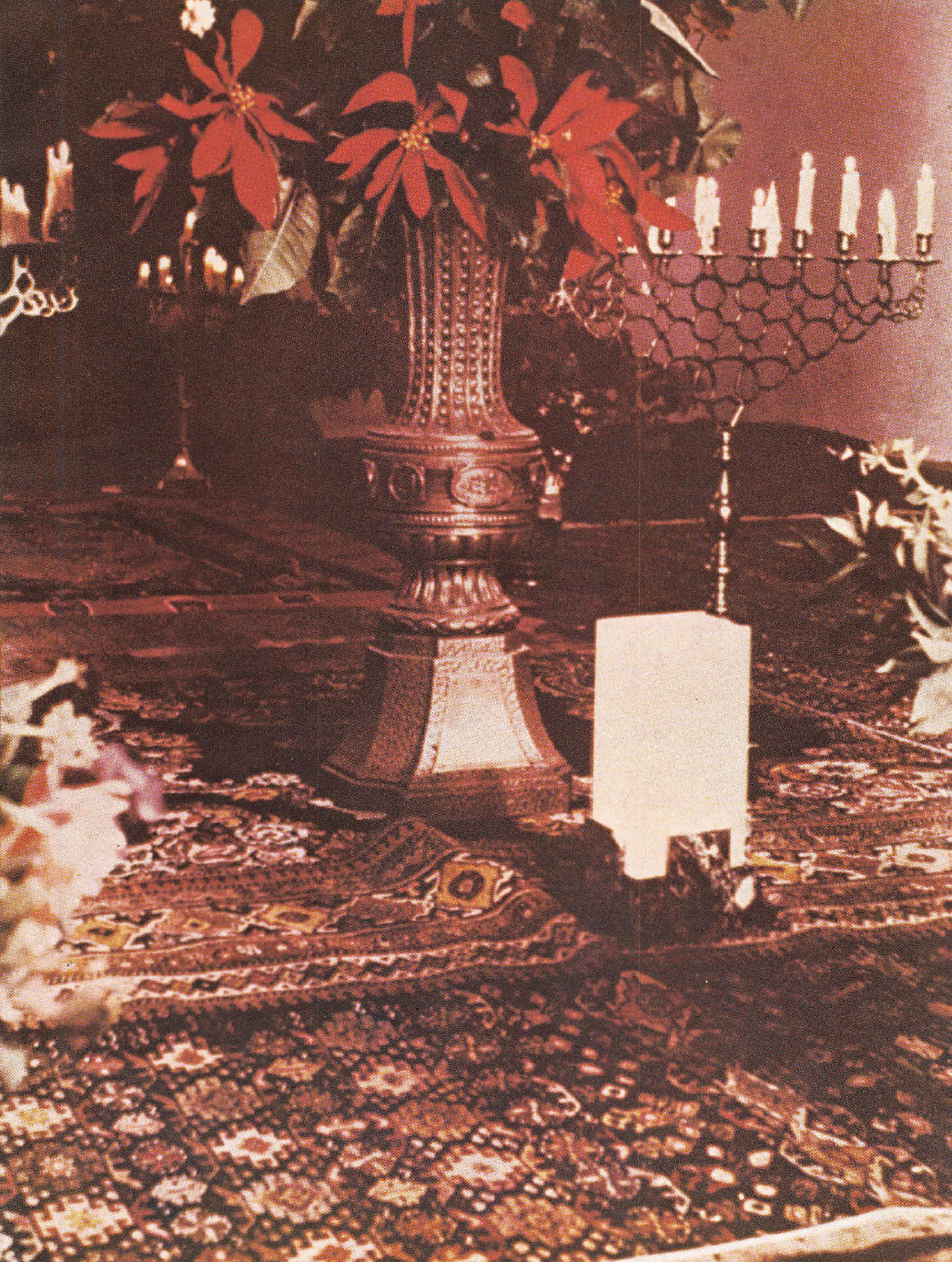
A rare and sacred photograph of the inner sanctum at the heart of the Shrine of the Báb. Source: The Bahá'í World, Volume 10, frontispiece.
The Guardian had personally overseen all of the details of the celebration of the Centennial in the Holy Land, particularly the arrangement, design, decoration and arrangement of the interior of the Shrine of the Báb.
On 23 May 1944, over 150 Bahá'ís visited the International Bahá'í Archives. The commemoration began shortly after dusk, and the pilgrims visited the Shrines of the Báb in Haifa and of Bahá'u'lláh in Bahjí. They then gathered in the Eastern Pilgrim House and listened to the recording of 'Abdu'l-Bahá chanting a prayer, and watched the short film of the Master shot in 1912 in New York, which was followed by a spectacular color slide show of the completed House of Worship in Wilmette—the Mother Temple of North America—and activities around it.
During the Centennial, the Guardian announced for the first time that he had approved the design for the superstructure of the Shrine of the Báb.
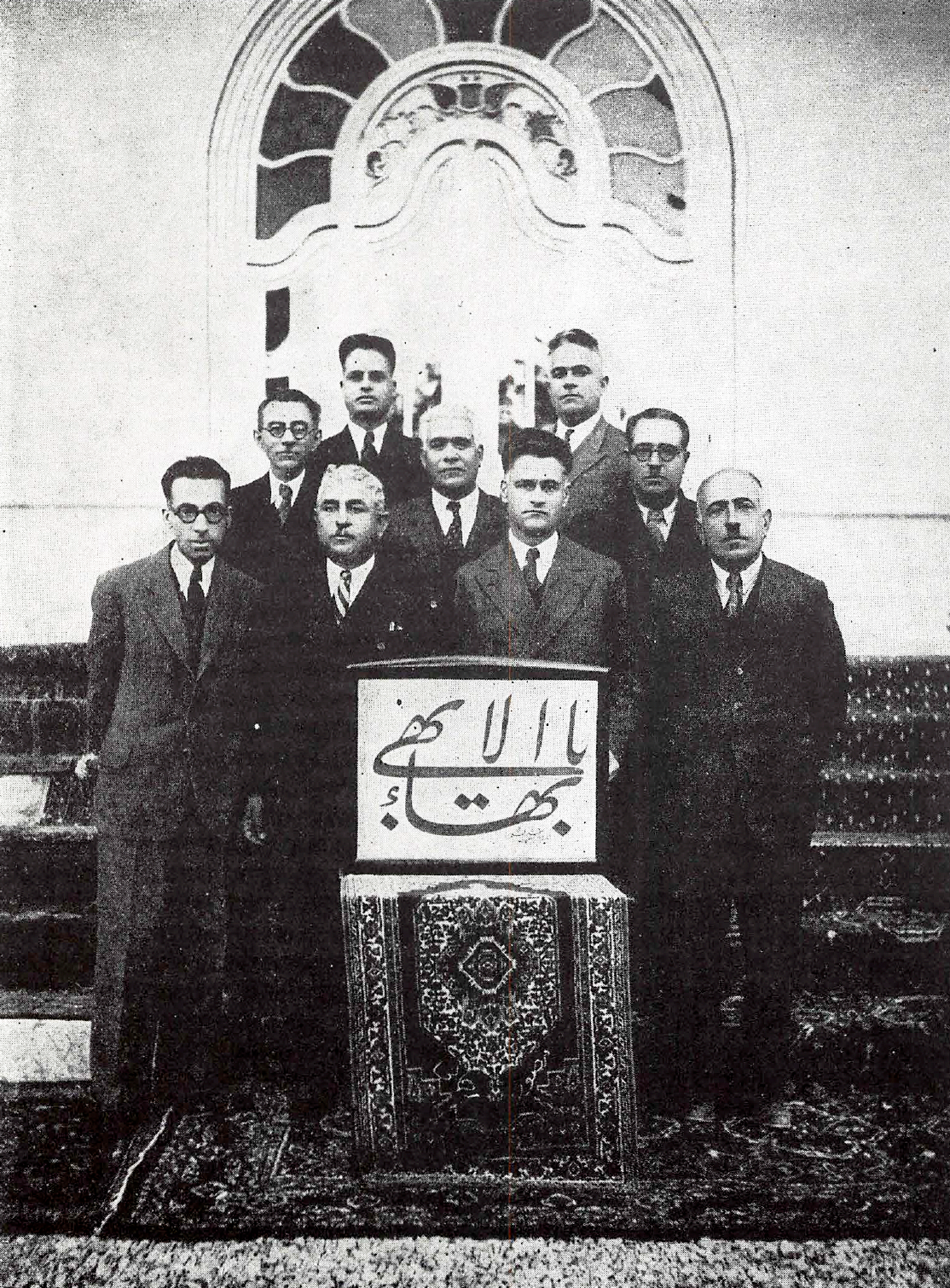
Members of the National Spiritual Assembly of the Bahá'ís of Iran, elected during the Centennial Annual Convention. Source: The Bahá'í World Volume 1o, page 250.
‘Alí-Akbar Furútan read the Tablet of the Centennial to the Bahá'ís, Convention delegates, and National Spiritual Assembly gathered in the House of the Báb in Shíráz on the evening before the commemoration.
Dr. Adel Shafipour’s grandfather was present at this historic event, and stated that many of the delegates loudly responded with “amr javán shud!” [The Cause has been rejuvenated!]. This comment about the rejuvenation of the Faith is directly related to the event commemorating the Faith’s first 100 years.
The next evening, they gathered again and all those present performed the rites of pilgrimage around the House of the Báb as prescribed by Bahá'u'lláh.
At exactly two hours and eleven minutes after sunset, the precise moment of the Báb’s Declaration one hundred years ago, the opening chapter of the Qayyúmu'l-Asmá', the commentary of the Súrih of Joseph was chanted, in the same room and at the same time as the Báb had first chanted it as He revealed it to Mullá Ḥusayn, at the time the only Bábí in the entire world.
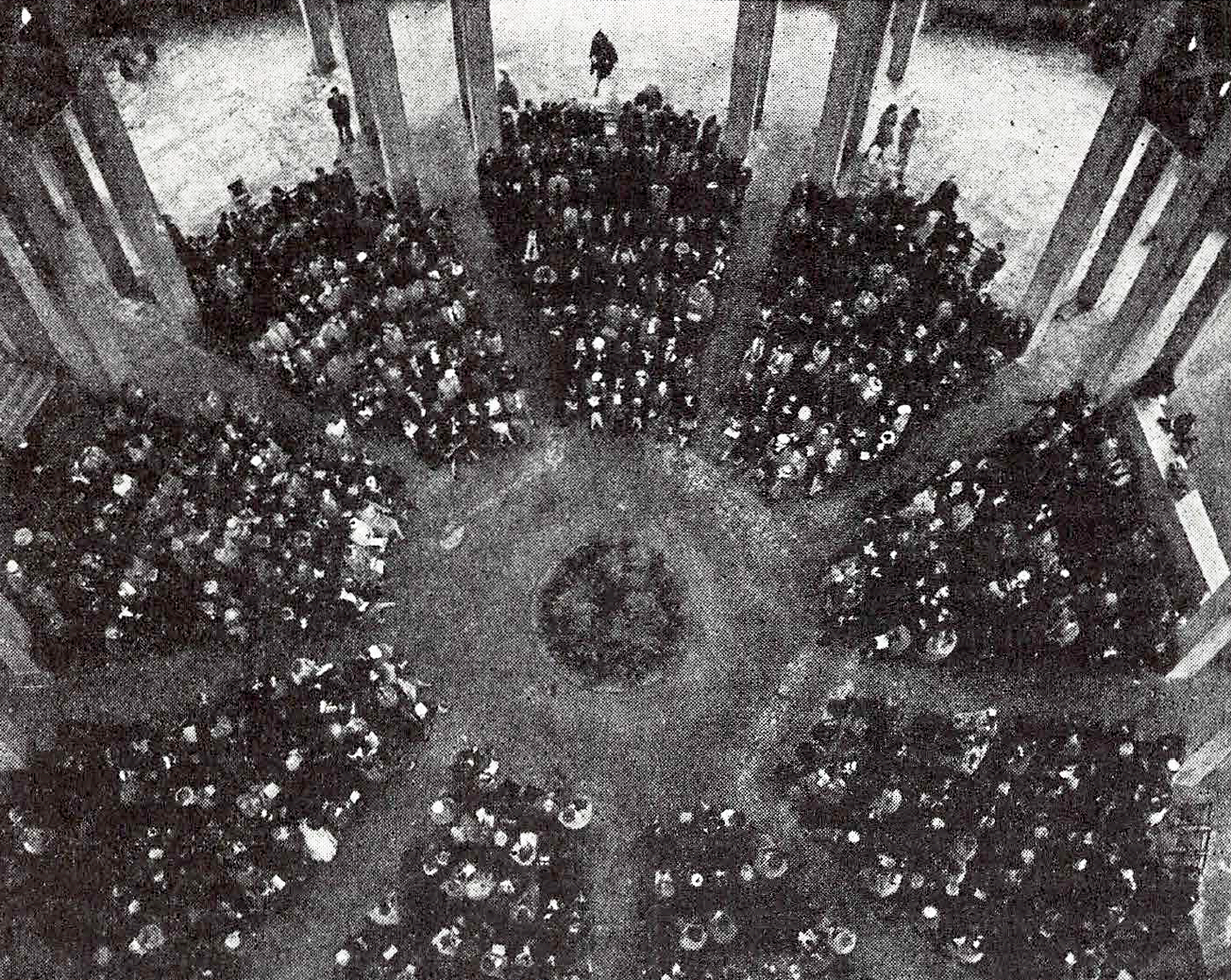
The All-American commemoration of the Centenary of the Bahá'í Faith: a view of Bahá'ís gathered in the auditorium at 8:00 PM on 22 May 1944, after the seats in the Foundation Hall were completely filled. A public address system reproduced the program for the overflow audience. The Bahá'í World Volume 10, page 180.
The Central and South American countries which were able to send a representative to the All-American Centennial were: Argentina, Bolivia, Brazil, Chile, Colombia, Costa Rica, Cuba, Ecuador, El Salvador, Guatemala, Haiti, Honduras, Jamaica, Mexico, Nicaragua, Panama, Paraguay, Peru, San Domingo, Uruguay, Venezuela.
The program was a week long and included many public events and conferences. The Bahá'í program for the evening of the Centennial on Monday 22 May 1944 began with four talks at 8:00 PM. Then came the Dedication of the Bahá'í House of Worship, with prayers and readings and an excerpt from 'Abdu'l-Bahá on the importance of the Mashriqu’l-Adhkár.
The Commemoration of the Declaration itself took place 20 minutes after the Dedication of the Temple, at 10:00 PM, and began with prayers from the Báb, the words of f Jesus Christ, and one from the Prophet Muḥammad.
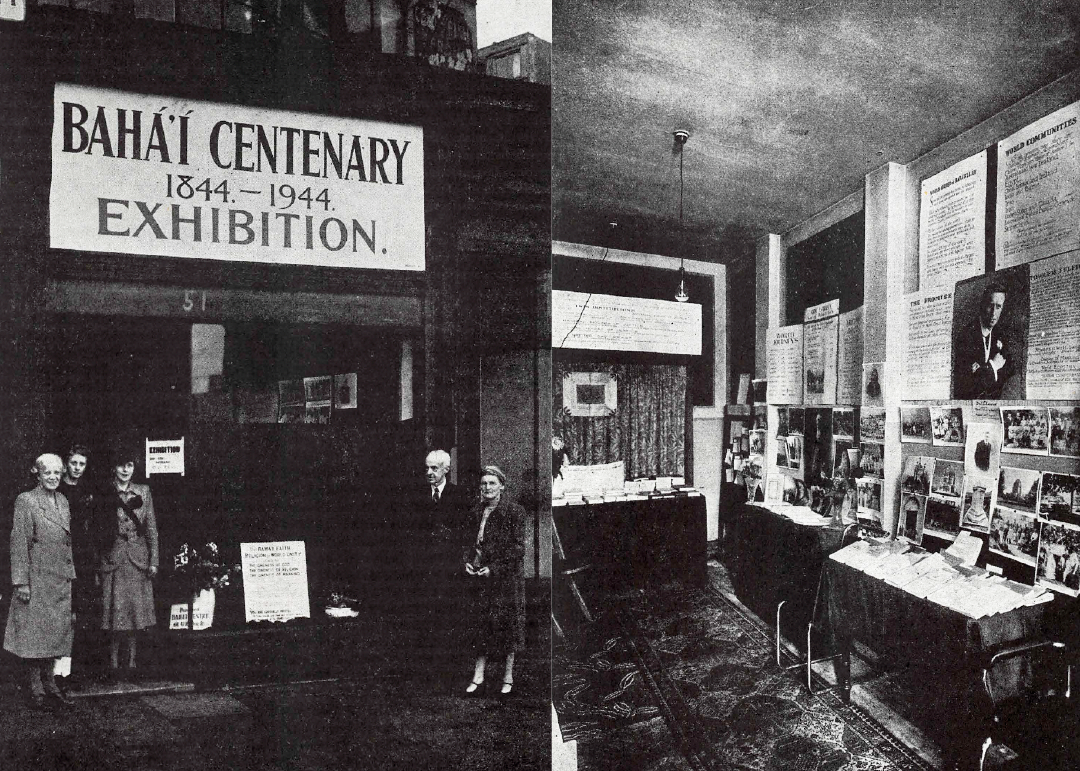
Left: Centenary Exhibition held in Bradford, Yorkshire, England in May 1944, showing the exterior view of the shop window on one of the main streets. Right: Interior view of the Bahá'í Centenary Exhibition held in Bradford England in May 1944. Dr. John E. Esslemont’s photograph can be see on the wall display on the right side of the image. Source: The Bahá'í World Volume 10, pages 191 and 193.
The Guardian himself stated that the commemoration of the Centennial in London was the second most outstanding event in the history of the Bahá'í Faith in the United Kingdom since the visits of 'Abdu'l-Bahá in 1911 and 1913.
Sir Ronald Storrs—former Military Governor of Jerusalem and current member of the London County Council—had known 'Abdu'l-Bahá personally and agreed to give the opening address of the Centennial celebration, an act the Guardian applauded as noble and courageous.
The festivities lasted a week and included several public meetings. There was an exhibition hall was decorated with large photographs of 'Abdu'l-Bahá, an exquisite specimen of calligraphy by Mishkín-Qalam—the renowned Bahá'í calligrapher—and other photographs of the Bahá'í House of Worship in North America, Dr. Esslemont, and 'Abdu'l-Bahá’s visits to England as well as an impressive display of Bahá'í literature, most notably the translation of Dr. Esslemont’s Bahá'u'lláh and the New Era in 33 languages.
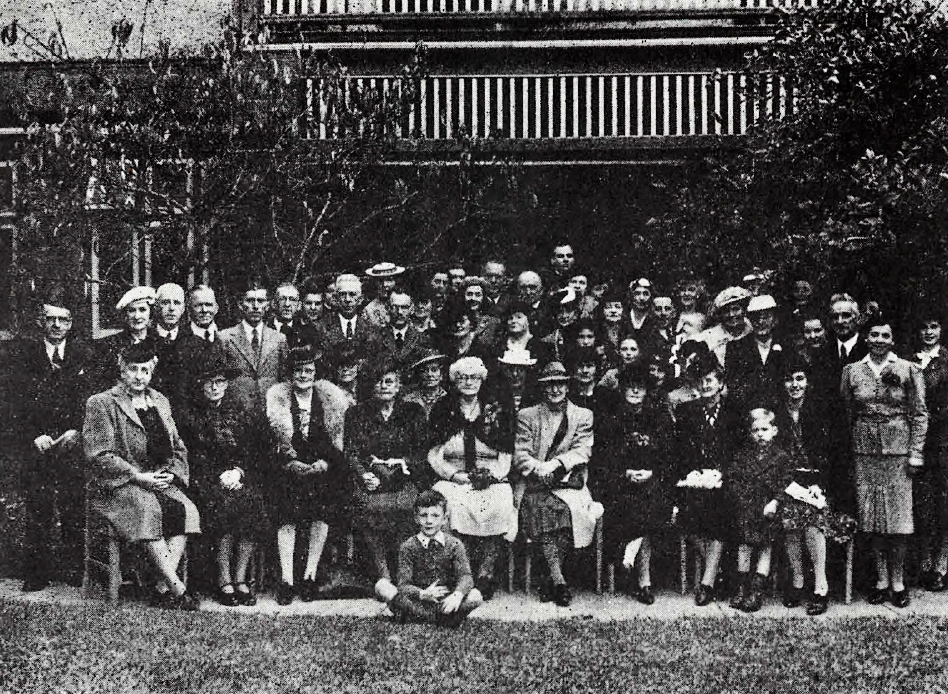
The dedication of the Bahá'í National Center for Australia and New Zealand marking the opening of the Centenary Convention in Sydney, Australia on 20 may 1944. Source: The Bahá'í World Volume 10, page 227.
The National Bahá'í Center of Australia was dedicated on 21 May 1944, during National Convention, which took place from 19 to 24 May 1944. Wartime travel restrictions notwithstanding, all the Bahá'í delegates were present at Convention.
Clara Dunn spoke about her meeting ‘Abdu’l-Bahá and pioneering to Australia with her husband, Hyde Dunn—who passed away three years prior in 1941. Clara and Hyde Dunn were the first two people to bring the Bahá'í Faith to Australia in 1919, in response to 'Abdu'l-Bahá’s momentous Tablets of the Divine Plan.
On Tuesday 23 May 1944, the Convention delegates and Bahá'í friends were the guests of the Guardian at a buffet dinner at the Pickwick Club in Sydney. After dinner, photographers took pictures and there were several eloquent addresses.
The Local Spiritual Assembly of Auckland, New Zealand organized a Bahá'í Centenary Banquet attended by 300 people.
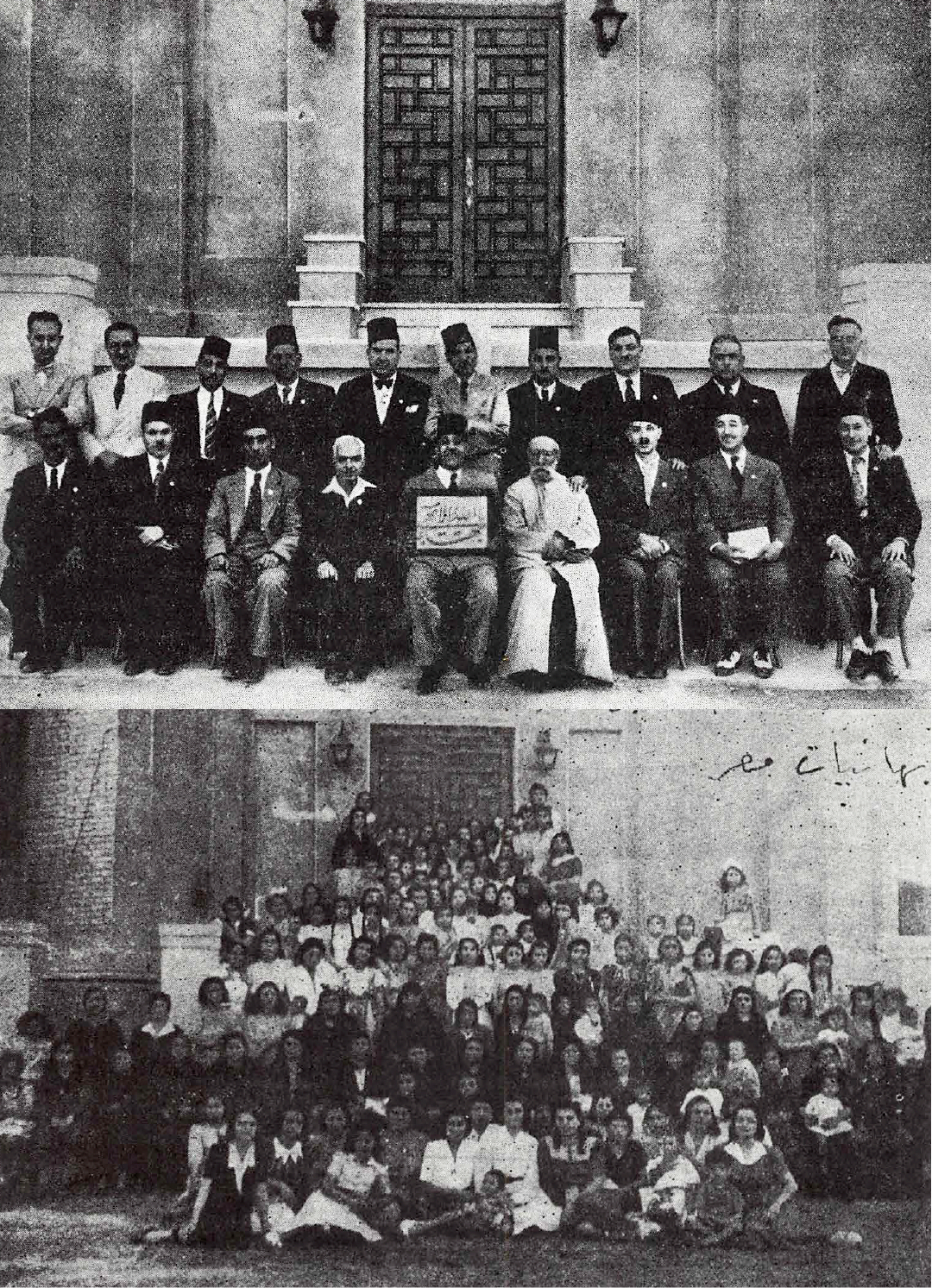
Top: Delegates attending the 21st Annual Convention of the Bahá'ís of Egypt and the Sudan held in Cairo, 20 – 21 May 1944. Bottom: Women attending the Centenary event in Cairo. Source: The Bahá'í World Volume 10, pages 209 and 210.
The National Spiritual Assembly of Egypt organized four programs of celebration for the Centennial on evening on the early and late evenings of Monday 22 May, and on the morning and evening of Tuesday 23 May 1944. The programs included prayers, messages from the Guardian including an excerpt from God Passes By on the first century of the Faith, an account of the life of Ṭáhirih, and several speeches.
Five hundred people, Bahá'ís and non-Bahá'ís, men, women, and children, rich and poor attended the wonderful celebrations. People came from all over Egypt and were housed in hotels, and in Bahá'í homes. Because so many people attended, the National Spiritual Assembly had large tents pitched on the grounds of the National Center where refreshments and banquets were served during the days of the celebrations.
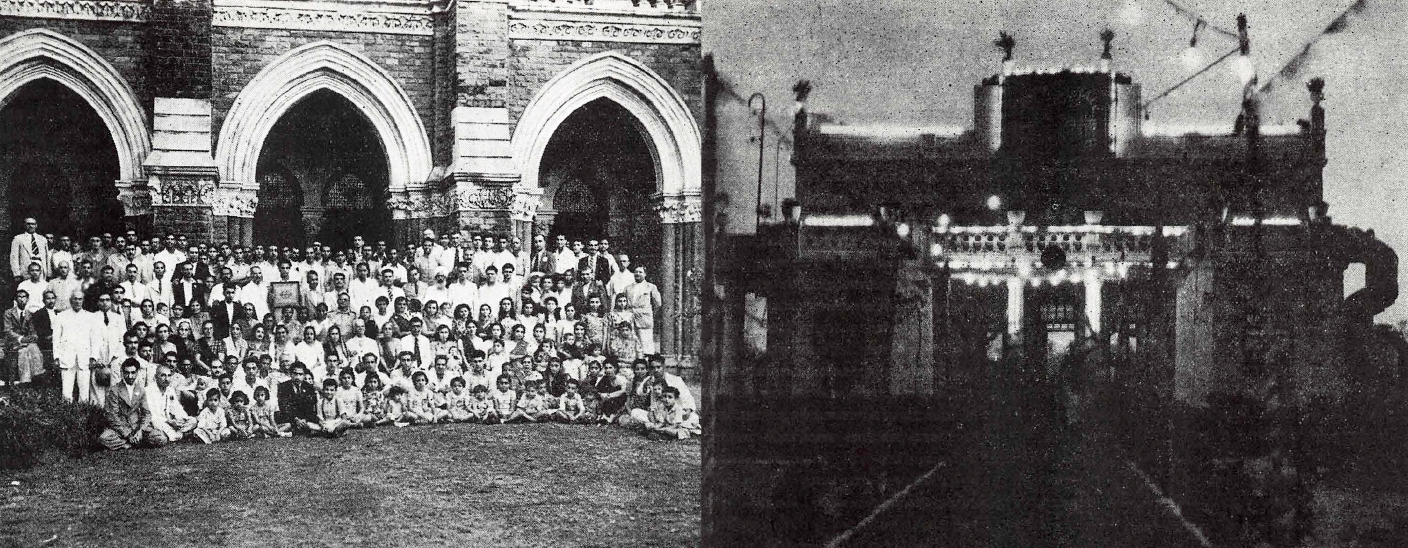
Left: Delegates and Friends attending the Annual Convention of the Baha'is of India and Burma held at Bombay, May 28, 1944, following the Centenary Celebrations. Right: The Bahá'í Center of Karachi (now in Pakistan), illuminated for the Centenary between 24 – 26 May 1944. Source: The Bahá'í World Volume 10, pages 205 and 203.
The national Centennial celebrations in India took place in Bombay—today’s Mumbai— and were widely advertised in the media.
The National Spiritual Assembly sent out 5,000 invitations, posted 1,000 posters in the city of Bombay, and nine leading cinemas displayed a slide for the upcoming Centennial every day for the week preceding the event. They also printed 15,000 copies of the Guardian’s work The World Religion—this could be Shoghi Effendi’s 1933 essay “The World Religion,” an 8-paragraph introduction to the Bahá'í Faith’s aims, teachings and history—500 pamphlets about Martha Root’s services to India, 500 copies of the first 50 years of the Bahá'í Faith in India, and 5,000 copies of K.T. Shad’s Religion of the Future, which were all given away.
The Bahá'ís drummed up so much publicity for the event that a News Film of the Government of India, the India News Parade, filmed the events. On the night of the Centennial—23 May—the Bahá'ís gathered together. The National Spiritual Assembly, National Convention Delegates and Bahá'ís met at the beautifully decorated and brilliantly lit Bombay Bahá’í hall.
At 2 hours and 11 minutes after sunset, the packed hall fell silent, and the program began: a prayer by the Báb, Bahá'u'lláh’s Summons to the Lord of Hosts, the Súriy-i-Mulúk, an excerpt from the Persian Bayán, a Tablet revealed by Bahá'u'lláh on the Declaration of the Báb, and a talk on the significance of that day.
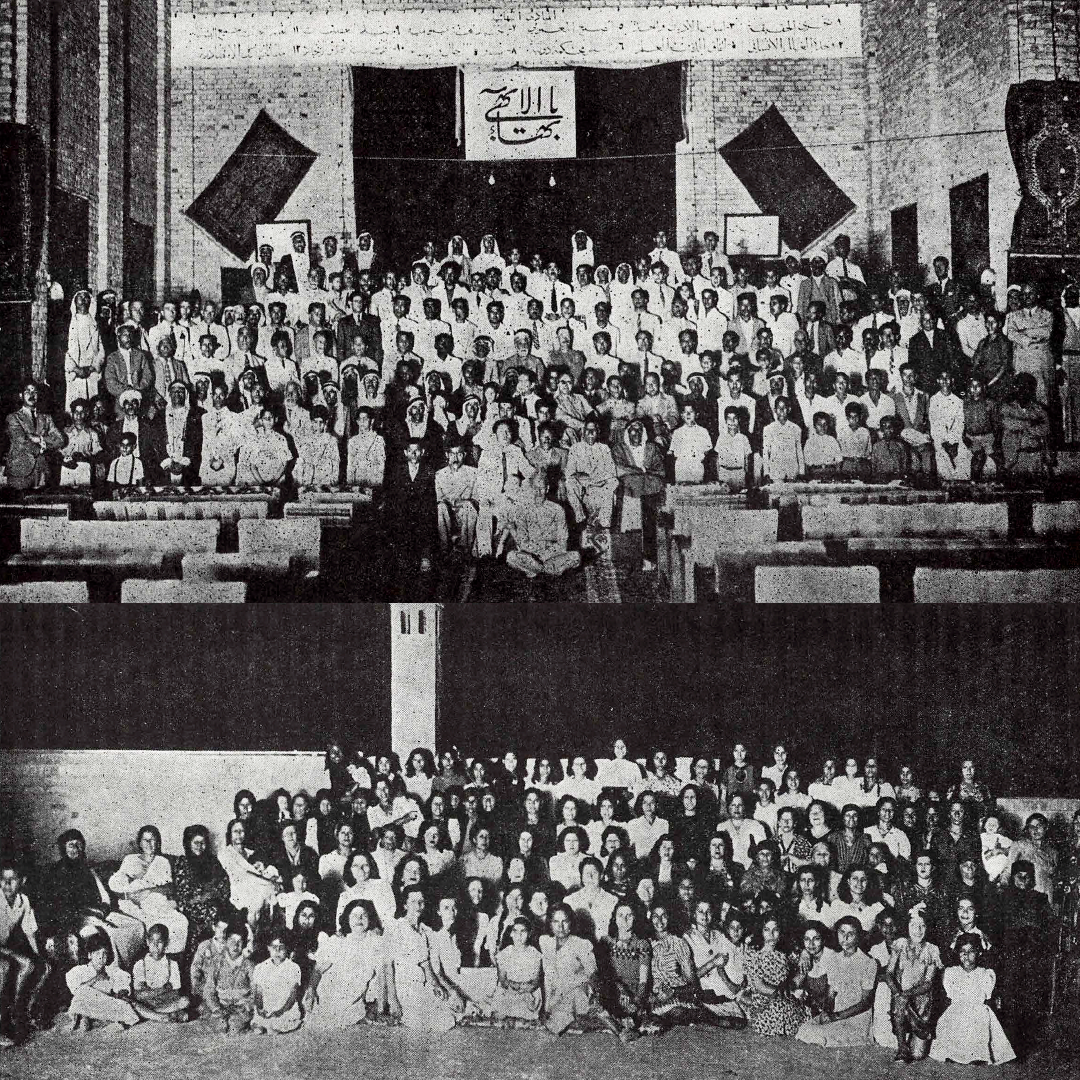
Top: The Bahá'ís of Baghdad and representatives of other centers in Iraq celebrating the Centenary of the Declaration of the Báb on 22 May 1944, held in conjunction with the Annual Convention. Bottom: The Bahá'í women of Baghdad, Iraq, celebrating the Centenary. Source: The Bahá'í World Volume 10, pages 219 and 221.
The National Bahá'í Center was a sight to behold. Its walls were decorated with priceless Persian rugs, the twelve major principles of the Faith, written in very large script on white linen sheets hung on the front walls of the guest house, welcoming the visitors. The Foundation hall was filled with sofas and chairs, and the entire center was flooded with light.
30 minutes after sunset, the opening prayer was said.
35 minutes after sunset, someone read verses from the Qur’án.
50 minutes after sunset, there was a reading from the New and Old Testament.
1 hour and 20 minutes after sunset, the Guardian’s message to the Centennial in Iraq was read in which he stated that he appreciated “their sincerity and fidelity,” took “pride in their endeavors and activities,” shared with them “in their pleasures and exhilaration,” and supplicated “unto God the Almighty to keep them in the stronghold of His protection and watchfulness and to confirm them in the diffusion of His fragrances and make their feet firm in His path, and enable them to elevate and glorify His Faith and render them victorious over their enemies and to realize their wishes in the service of His most glorious and wonderful, most holy, and most inaccessible Faith.”
1 hour and 40 minutes after sunset, Chapter III in Nabíl’s Narrative’s concerning the Declaration of the Báb was read.
2 hours and 10 minutes after sunset, everyone rose to their feet, silently, solemnly, and reverently, and these words from Nabíl’s Narrative were read:
This night, this very hour will, in the days to come, be celebrated as one of the greatest and most significant of all festivals. Render thanks 62 to God for having graciously assisted you to attain your heart’s desire, and for having quaffed from the sealed wine of His utterance.
At exactly 2 hours and 11 minutes after sunset, the Bahá'ís were solemnly seated, and utterly quiet. All the Bahá'ís of Baghdad were present, as well as all the delegates of the Fourteenth Annual Convention, and representatives from as many cities as possible: Mosul, Sulaymáníyyih, Karkfik, Khaniqayn, Ba’aqubih, Huvaydar, ‘Avéshiq, Idliybih, Laraban, Khirnabat, Abu-Saydih, ‘Aziziyyih, ‘Amarih, Mutavva’ah and Basrah.
At that exact moment, when 100 years ago that day the Báb declared His mission to Mullá Ḥusayn by beginning the revelation of the Commentary on the Súrih of Joseph of the Qur’án—the Qayyúmu'l-Asmá'—an excerpt of that same book was read to mark the occasion.
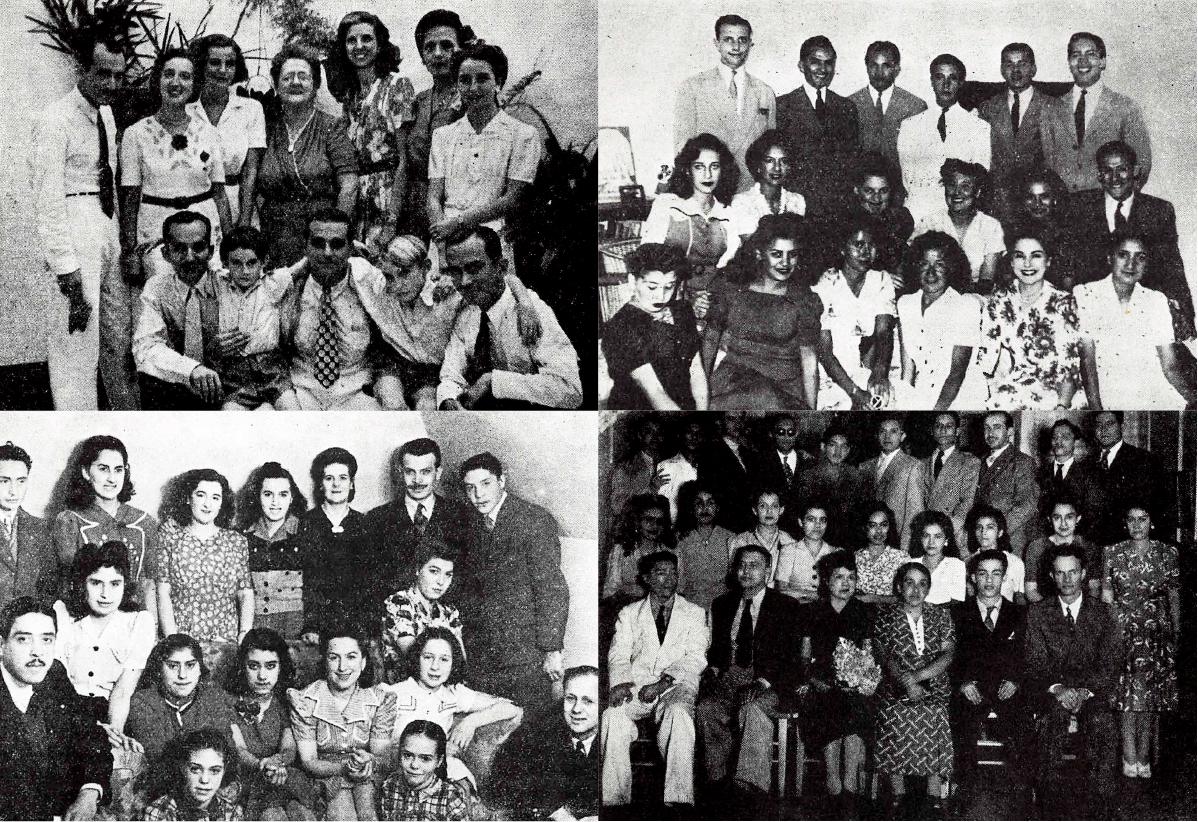
No photographs of Centennial Celebrations in Latin America were found. Here are four photographs of four communities in Central and South America. Top left: Youth of Lima, Peru. Top left: The first public meeting for youth held under the auspices of the Spiritual Assembly of Punta Arenas, Magallanes, Chile in July 1945. Bottom left: The first Bahá'í Youth Day meeting held in Guayaqui, Ecuador, 17 March 1943. Bottom right: Bahá'ís and friends of the Faith in San Salvador, El Salvador. Source: The Bahá'í World Volume 10, pages 439, 461, 465, and 553.
The Bahá’ís of Haiti organized many festivities for the Centennial from 19 to 25 May, the same span of time as the All-American Centennial. Their meetings in French included prayer, one included the singing of the Haitian National Anthem, there were talks and lectures on the life of the Báb, readings from Bahá'u'lláh and the New Era, and refreshments were served at every occasion.
The Local Spiritual Assembly of Havana did a wonderful job publicizing their events, and they organized a highly successful meeting at their Bahá'í Center.
The Local Spiritual Assembly of Buenos Aires, Argentina—the site of May Maxwell’s memorial shrined—arranged a well-publicized, beautiful program of several days of festivity. The program for the Centennial consisted of an opening address on the Báb, readings from the Báb’s writing, three further addresses on the Bahá'u'lláh, 'Abdu'l-Bahá, and the Guardian.
In Chile, Marcia Steward, an isolated pioneer in the southernmost city on earth, Punta Arenas, held a prayer vigil to mark the solemn occasion.
The Bahá’ís of La Paz, Bolivia centered their attention upon a tribute that would be both of immediate interest and of permanent contribution to the teaching work. They prepared widely distributed a commemorative booklet of prayers in Spanish carefully selected to bring comfort to young and old, to people of culture and education, and to those whose education had been limited. An article about the Centennial was published in the local newspaper. At two hours and eleven minutes after sunset, a talented Bahá'í spoke on the radio. The Bahá'ís commemorated in a reverent event that included prayers and readings from the Bahá'í Writings in honor of the Declaration of the Báb and the birthday of 'Abdu'l-Bahá, and an address titled “The Great Announcement.”

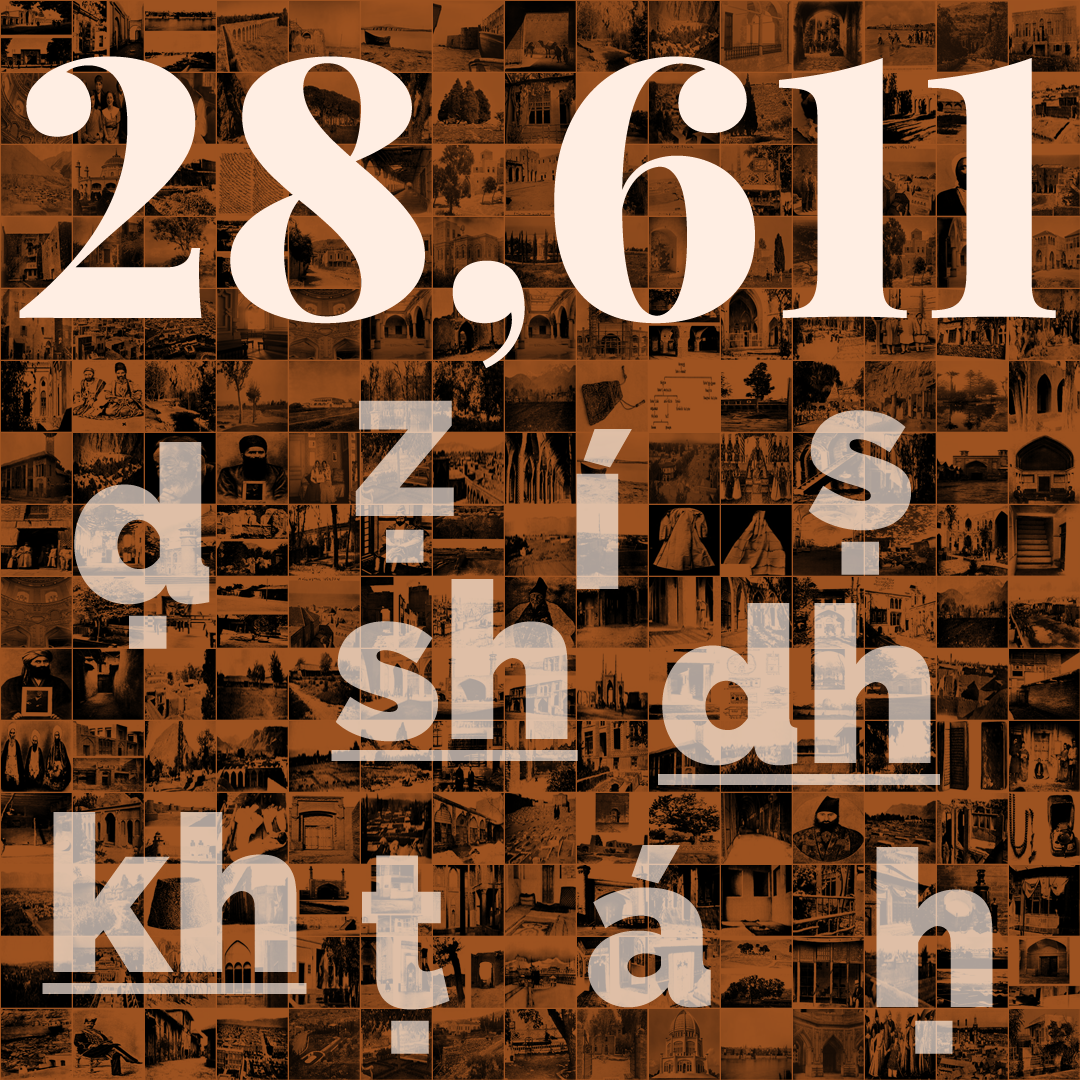
Shoghi Effendi typed three carbon copies of each page, and at night, he and Rúḥíyyih Khánum sat side by side at his large bog wood table in his bedroom, each with their own triplicate copies of manuscript pages, adding by hand all the transliterated accents: the underlined dh, kh, sh, the uderdots of ḍ, ḥ, ṣ, ṭ, and ẓ, the acute accents á and í.
Do you know how many diacritics there are in God Passes By?
There are 9,537.
The Guardian of the Faith, and the Hand of the Cause Amatu’l-Bahá Rúḥíyyih Khánum personally, manually added three times that many accents on the triplicate typed manuscripts of God Passes By, which means they added 28,611 accents by hand, late into the night, while Shoghi Effendi was reading the words out loud in Persian, so they both knew how to transliterate each one.
They added 28,611 accents until their eyes were bloodshot, until their vision was blurry, until Shoghi Effendi’s back and arms were stiff with exhaustion.
But it had to be done, and they were the only two people on the planet who could do it, so they did, and they persevered and suffered through the 173,681 words of God Passes By, until they were done.
Batch by batch, that was how the manuscript of God Passes By was typed, edited, corrected, and sent piecemeal to Horace Holley, the secretary of the National Spiritual Assembly of the United States and Canada.
Shoghi Effendi worked continuously on God Passes By for two years, from 1942 to 22 January 1944, when the last remaining pages—corrections for the section “Prospect and Retrospect”—were mailed to Horace Holley in the United States for publication.
By this point, both Shoghi Effendi and Rúḥíyyih Khánum were spent, utterly exhausted.
For two years, they had referred to Shoghi Effendi’s manuscript as “the book,” sometimes Rúḥíyyih Khánum referred to it as Shoghi Effendi’s “manuscript” or even “the Centennial Review,” Shoghi Effendi himself at times called it a “review” or a “survey,” but it did not yet have a name.
This is the story of how God Passes By got its name.
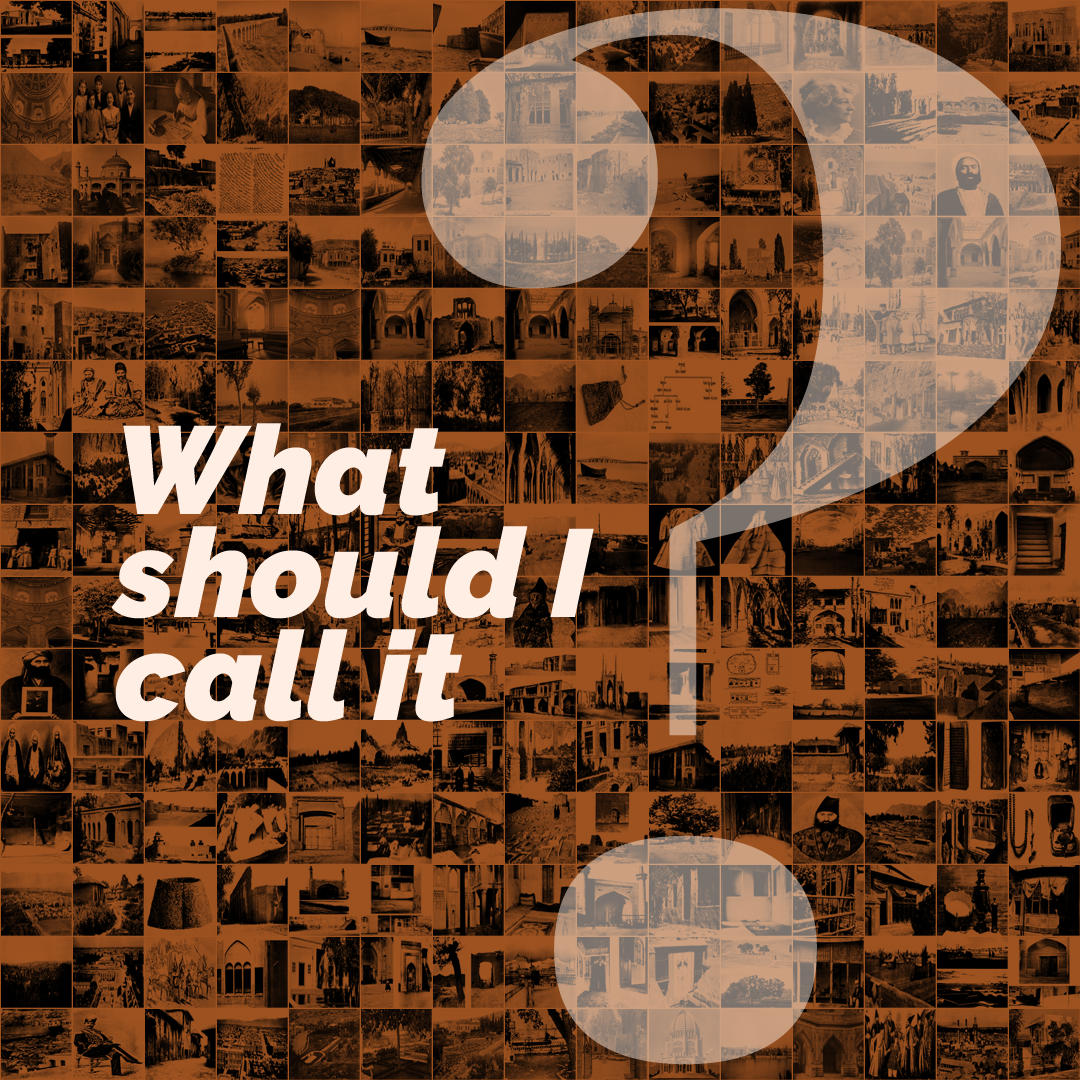
The Guardian asked George Townshend to come up with a title for his manuscript.
The rest of this story comes from former member of the Universal House of Justice and eminent Bahá'í historian Adib Taherzadeh who was a member of the Irish Bahá'í community, who had a long-standing friendship Irish Hand of the Cause George Townshend, where they would discuss spiritual matters.
George Townshend told Adib Taherzadeh:
I did not know what to do.
And so, George Townshend didn’t do anything.
Shoghi Effendi sent George Townshend cables, pressuring him to title the manuscript, asking him to give it a name, asking him to expedite.
But nothing came to George Townshend. He was not inspired.
Message after message, cable after cable came from Shoghi Effendi, and finally, George thought to himself, “Well, I must send a telegram to Shoghi Effendi, give a name to this book. What shall I call it?”
George got on his bike, and started riding in Ahascragh, towards the only reliable post office, in the center of Dublin—about 16 kilometers away from his home—still with no idea what he was going to write to Shoghi Effendi. He still did not have a title for the book.
As he was biking towards the telegram he needed to send his Guardian, the Irish landscape passing him by, and inspiration finally came to him in the form of three simple words, three simple syllables.
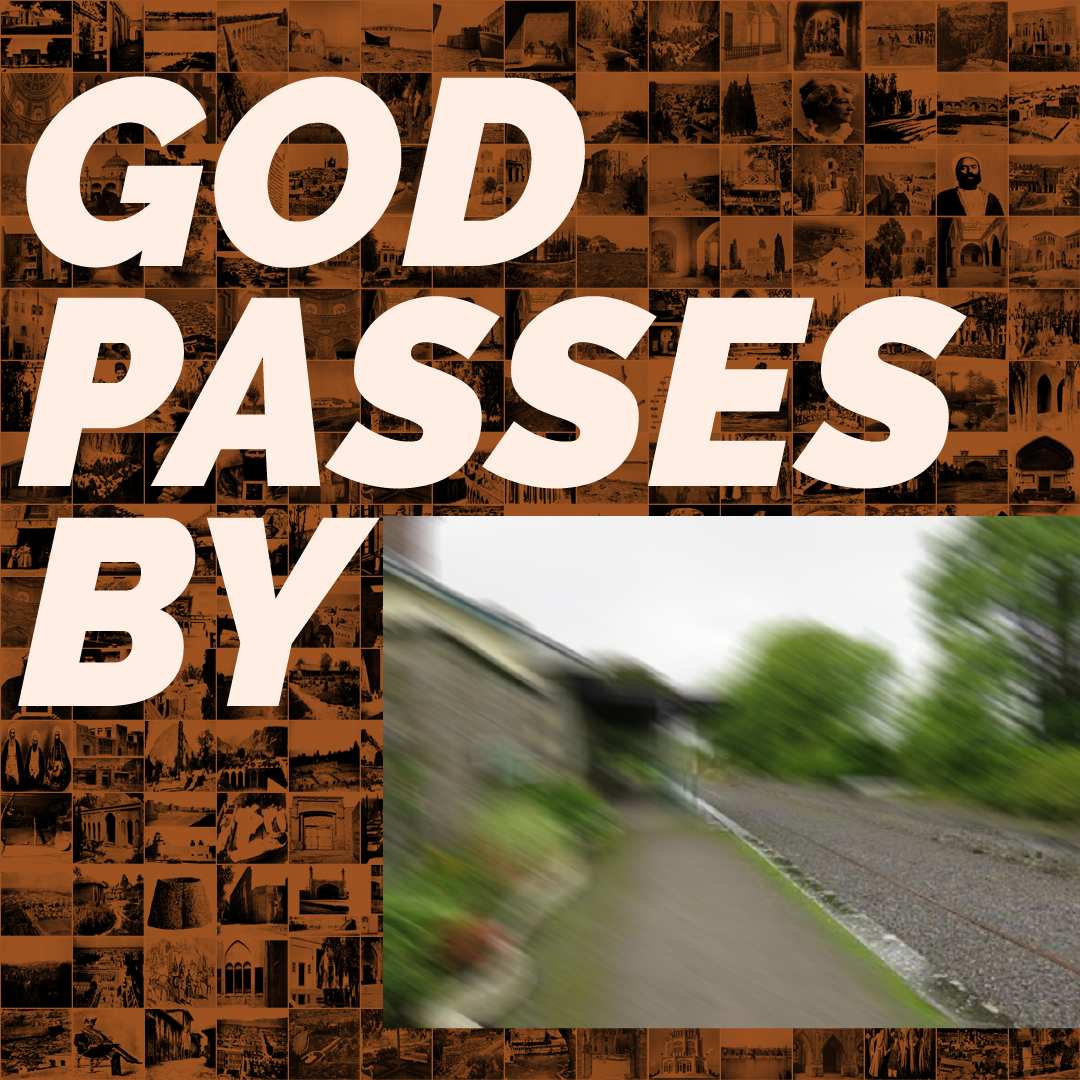
A road passing by Ahascragh, where George Townshend was cycling, seeing the world blur past him when he thought of the title: God Passes By.
George arrived at the post office and cabled the Guardian:
GOD PASSES BY
Shoghi Effendi immediately replied
DELIGHTED TITLE. EAGERLY AWAITING LETTER.
The title God Passes By is an English gem. Its exact meaning cannot be adequately translated into any other language.
What is implied in the words God Passes By is that God moved in close proximity to us, and we didn’t notice. There is a subtlety in the title, of God having been so near to us, but we only realized it later, with the passage of time.
The French translation, Dieu passe près de nous, literally translates in English as God passes close to us.
The Spanish translation, Diós pasa, means God passes.
No translation comes close to the spiritual intimacy of the English, God Passes By.
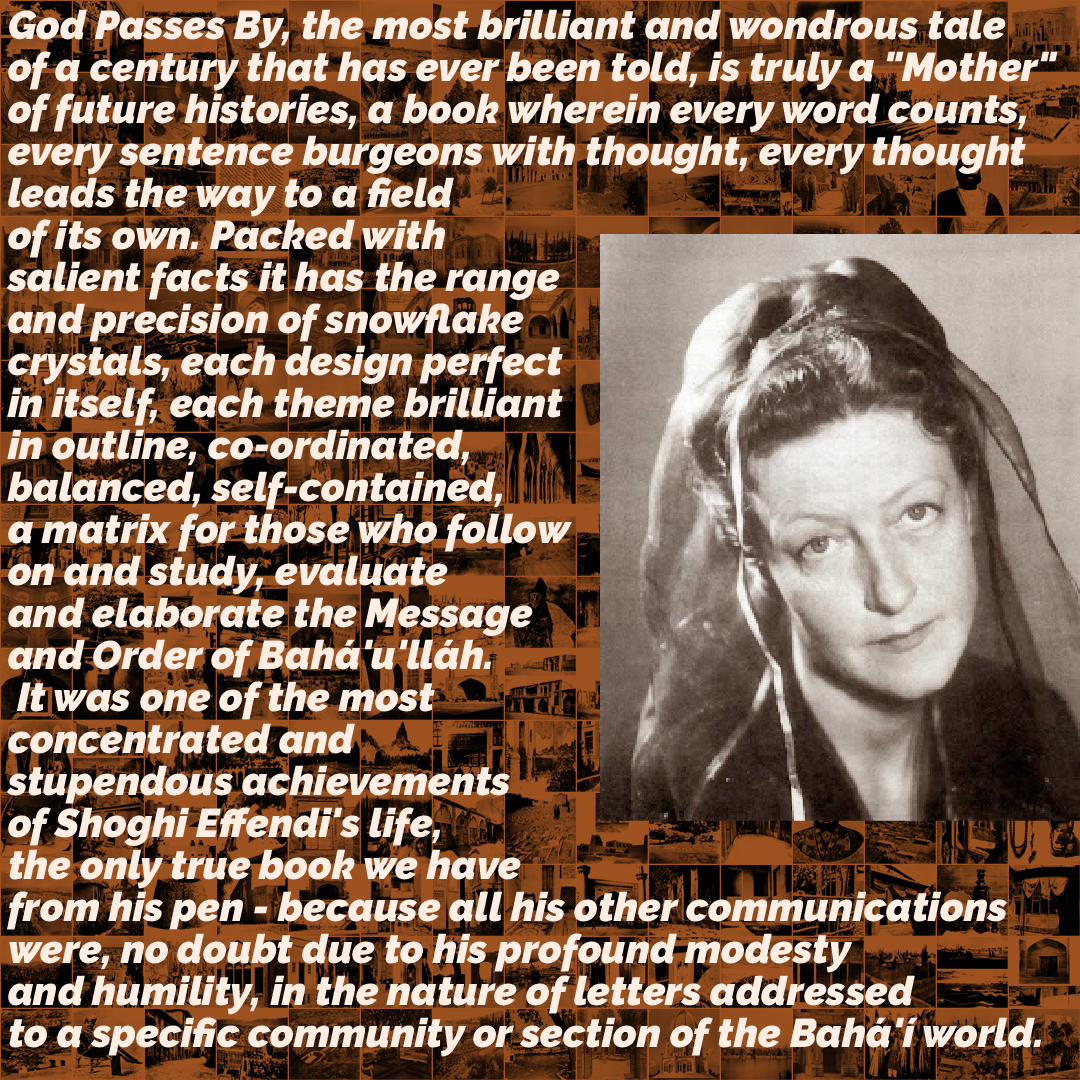
Portrait of Rúḥíyyih Khánum. Source: We are Bahá'ís.
Rúḥíyyih Khánum called God Passes By “a veritable essence of essences,” arguing that Shoghi Effendi’s masterpiece was such an ultra-condensed, super-rich distillation of Bahá'í history that 50 books on Bahá'í history could easily be written from it, every single one of them a profound, rich study of one of the aspects of the Faith.
Shoghi Effendi wrote God Passes By, a spiritual, exceedingly beautiful literary gift, at a time when Nazis were exterminating Jews, Gypsies and other minorities across Europe, at a time when the armies of the world were battling on the western, the Russian and the North African fronts, when both the United States and Japan had already entered the theater of war,
This is Rúḥíyyih Khánum’s phenomenal description of God Passes By:
God Passes By, the most brilliant and wondrous tale of a century that has ever been told, is truly a "Mother" of future histories, a book wherein every word counts, every sentence burgeons with thought, every thought leads the way to a field of its own. Packed with salient facts it has the range and precision of snowflake crystals, each design perfect in itself, each theme brilliant in outline, co-ordinated, balanced, self-contained, a matrix for those who follow on and study, evaluate and elaborate the Message and Order of Bahá'u'lláh. It was one of the most concentrated and stupendous achievements of Shoghi Effendi's life, the only true book we have from his pen - because all his other communications were, no doubt due to his profound modesty and humility, in the nature of letters addressed to a specific community or section of the Bahá'í world.
The current edition of God Passes By is 412 pages long, and Shoghi Effendi included 1,945 quotations in the book, most of them from Bahá'u'lláh and 'Abdu'l-Bahá. Of these 1,945 quotations, 41 of them run a full page or more in length


God Passes By begins with an 11-paragraph Foreword by Shoghi Effendi—George Townshend’s introduction is no longer included in current editions of the book.
In the Foreword to God Passes By, the Guardian lays out what awaits the reader, but first, he emphasizes the importance of the triple centenary of 23 May 1944, the culmination of a universal prophetic cycle:
On the 23rd of May of this auspicious year the Bahá’í world will celebrate the centennial anniversary of the founding of the Faith of Bahá’u’lláh. It will commemorate at once the hundredth anniversary of the inception of the Bábí Dispensation, of the inauguration of the Bahá’í Era, of the commencement of the Bahá’í Cycle, and of the birth of ‘Abdu’l‑Bahá.
Over the next two paragraphs, Shoghi Effendi casts a general glance at the spiritual forces generated by the first 100 years of the Bahá'í and the emergence of Bahá'u'lláh’s embryonic World Order and their effect on the world.
In paragraphs 4, 5, and 6, Shoghi Effendi explains not only his purpose for writing God Passes By, and what the book represents, but he also cautions the readers on what God Passes By is not: Shoghi Effendi did not intend it to be a detailed history of the last hundred years of the Bahá’í Faith, and he did not intend to study in detail the origins of the Faith, the social conditions in which it appeared, its character or to examine in detail its impact on human society.
Paragraphs 7 through 10 are majestic descriptions of the content of God Passes By, the first three epochs of the Heroic Age and the first epoch of the Formative Age and their descriptions, with long descriptions of each of the four parts of the book, culminating in a very long final paragraph in which the Guardian lays out the procession of historic events contained in the remainder of the book.
Shoghi Effendi divided the contents of the first 100 years of Bahá'í history into four periods:
- First Period: The Ministry of the Báb 1844–1853;
- Second Period: The Ministry of Bahá’u’lláh 1853–1892;
- Third Period: The Ministry of ‘Abdu’l‑Bahá 1892–1921;
- Fourth Period: The Inception of the Formative Age of the Bahá’í Faith 1921–1944.
Below are four very short summaries of each of these periods:
 Shoghi Effendi begins his history of the 9 years of the Báb’s ministry with His Declaration, the story of the Letters of the Living, the Báb’s pilgrimage and public declaration in Mecca Medina, his return to Shíráz, his stay in Iṣfahán and his imprisonment in Máh-Kú and Chiríq. He also writes about the Báb’s Revelation of the Qayyúmu'l-Asmá' and the Bayán, His examination in Tabriz, and His martyrdom in that same city. Shoghi Effendi also takes time to set down in history three important things: the role Bahá'u'lláh played during the Báb’s ministry, the stunning parallels between the ministries of Jesus Christ and the Báb, and the names and tragic fates of all of the Báb’s enemies.
Shoghi Effendi begins his history of the 9 years of the Báb’s ministry with His Declaration, the story of the Letters of the Living, the Báb’s pilgrimage and public declaration in Mecca Medina, his return to Shíráz, his stay in Iṣfahán and his imprisonment in Máh-Kú and Chiríq. He also writes about the Báb’s Revelation of the Qayyúmu'l-Asmá' and the Bayán, His examination in Tabriz, and His martyrdom in that same city. Shoghi Effendi also takes time to set down in history three important things: the role Bahá'u'lláh played during the Báb’s ministry, the stunning parallels between the ministries of Jesus Christ and the Báb, and the names and tragic fates of all of the Báb’s enemies.
Shoghi Effendi also looks at the main events in the lives of the Bábí community while the Báb was imprisoned, such as the conference of Badasht and the major role Bahá'u'lláh played as its organizer. Shoghi Effendi lays out the opposition of the Shí’ah clergy to the Báb’s new teachings, describes in details the reprisals against the Bábís in 1849-1850 in Mázindarán, Nayríz, Zanján and the Seven Martyrs of Ṭihrán, and also tells the story of the three misguided Bábís attempt on the life of Naṣiri'd-Dín Sháh, the swift and bloody massacres that followed as repercussions.

Shoghi Effendi begins the second period of the Bahá'í Faith with an event that immediately followed the end of his story in the first period: the imprisonment of Bahá'u'lláh in the Siyáh-Chál as one of the repercussions of the attempt on the life of Naṣiri'd-Dín Sháh. Shoghi Effendi describes the Revelation Bahá'u'lláh received in the Siyáh-Chál, His first exile to Baghdad and how Bahá'u'lláh re-created the Bábí community of Baghdad, and his tremendous influence in Baghdad social circles.
After an extraordinary section describing the first stage of Bahá'u'lláh’s Proclamation of His Mission in the Garden of Riḍván, Shoghi Effendi describes Bahá'u'lláh’s unjustified second and third exiles, to Istanbul and Edirne. He speaks about Mírzá Yaḥyá’s attempt to assassinate Bahá'u'lláh, and describes in detail Bahá'u'lláh’s Tablets to the Kings and Rulers of the World, before speaking about Bahá'u'lláh’s fourth and final exile, in 'Akká.
Shoghi Effendi speaks about the conditions of Bahá'u'lláh’s incarceration in the Most Great Prison, the gradual relaxation of the restrictions imposed upon Him in the years when Bahá'u'lláh lived in 'Akká, until 'Abdu'l-Bahá succeeded in renting for His Father the Mansions of Mazra’ih and Bahjí, where Bahá'u'lláh spent His final years in dignity.
Shoghi Effendi speaks about many of the Holy Writings revealed by Bahá'u'lláh, explaining their importance and their influence, notably the Kitáb-i-Aqdas. Shoghi Effendi explores the influence and effect of Bahá’u’lláh’s behaviour and Writings on the minds and hearts of those around Him, describes the days and weeks preceding and following His Ascension, and ends—as he had with the Báb—with a list of Bahá'u'lláh’s enemies and the divine chastisement that defined their demise and deaths.
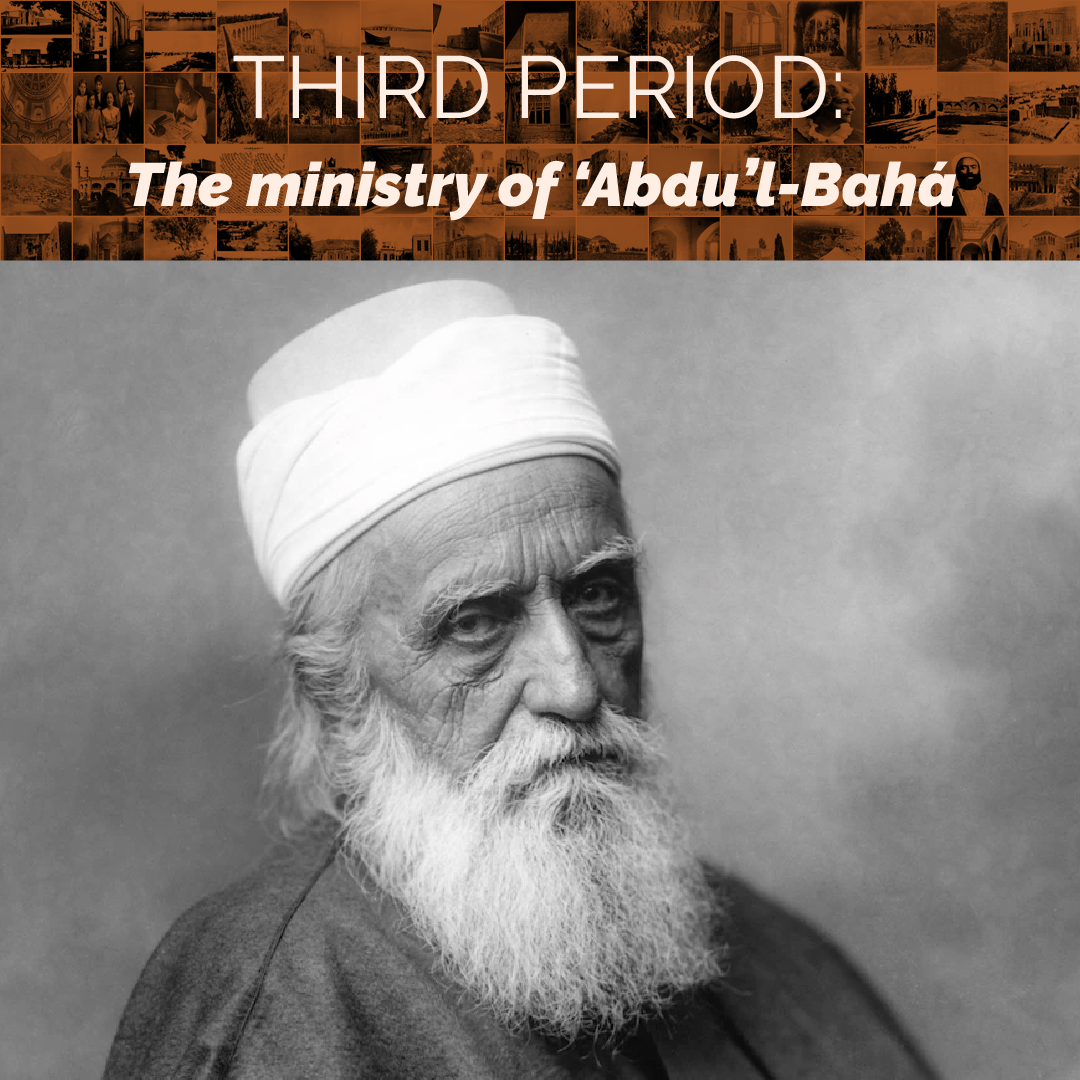
In his outline of the Ministry of ‘Abdu’l-Bahá, Shoghi Effendi mainly focuses on four aspects of the life of 'Abdu'l-Bahá”
- His role and function as Centre of Covenant and Head of the Faith;
- The distinguishing features of His career;
- The revitalizing influence of his infallible guidance on the Bahá'í community
- 'Abdu'l-Bahá’s character and His accomplishments
- The Master’s achievement in establishing the first rudimentary institutions of the Faith.
Shoghi Effendi begins his exploration of the ministry of 'Abdu'l-Bahá with an explanation of the significance of the Kitáb-i-Ahd, the Book of Bahá'u'lláh’s Covenant appointing 'Abdu'l-Bahá the Center of the Covenant. Then, Shoghi Effendi reviews 'Abdu'l-Bahá’s important role during the ministry of Bahá'u'lláh, the arrival of the first western pilgrims to 'Akká, the activities of the most infamous Covenant-breaker of 'Abdu'l-Bahá’s ministry, His half-brother, Mírzá Muḥammad-'Alí. The activities of the Covenant-breakers resulted in 'Abdu'l-Bahá’s re-incarceration in 'Akká, and a Commission of Inquiry was sent from Istanbul to investigate their malicious rumors regarding the Shrine of the Báb which 'Abdu'l-Bahá was building on Mount Carmel.
In this section, Shoghi Effendi relates the persecution of the Bahá’í community in Persia, describes the construction of the first Bahá’í House of Worship in ‘Ishqábád, the erection of the Shrine of the Báb, and the momentous event of 'Abdu'l-Bahá finally laying His remains to rest after 59 years.
Following the Young Turk Revolution, 'Abdu'l-Bahá was finally free and Shoghi Effendi describes in detail His Journeys to the West, underlining their great importance, and the effect 'Abdu'l-Bahá had throughout His travels in Egypt, France, Switzerland, the United States, Canada, England, Scotland, Germany, Hungary and Austria.
Upon 'Abdu'l-Bahá’s return to the Holy Land, Shoghi Effendi recalls His activities during World War I, and His Knighthood for services rendered to the British Crown. The two words that Shoghi Effendi highlights in his section on the Ministry of 'Abdu'l-Bahá are His Will and Testament and the Tablets of the Divine Plan. Finally Lastly, Shoghi Effendi recounts the Ascension of 'Abdu'l-Bahá, and, as in the first two section, he relates the fate of the few remaining enemies of 'Abdu'l-Bahá.
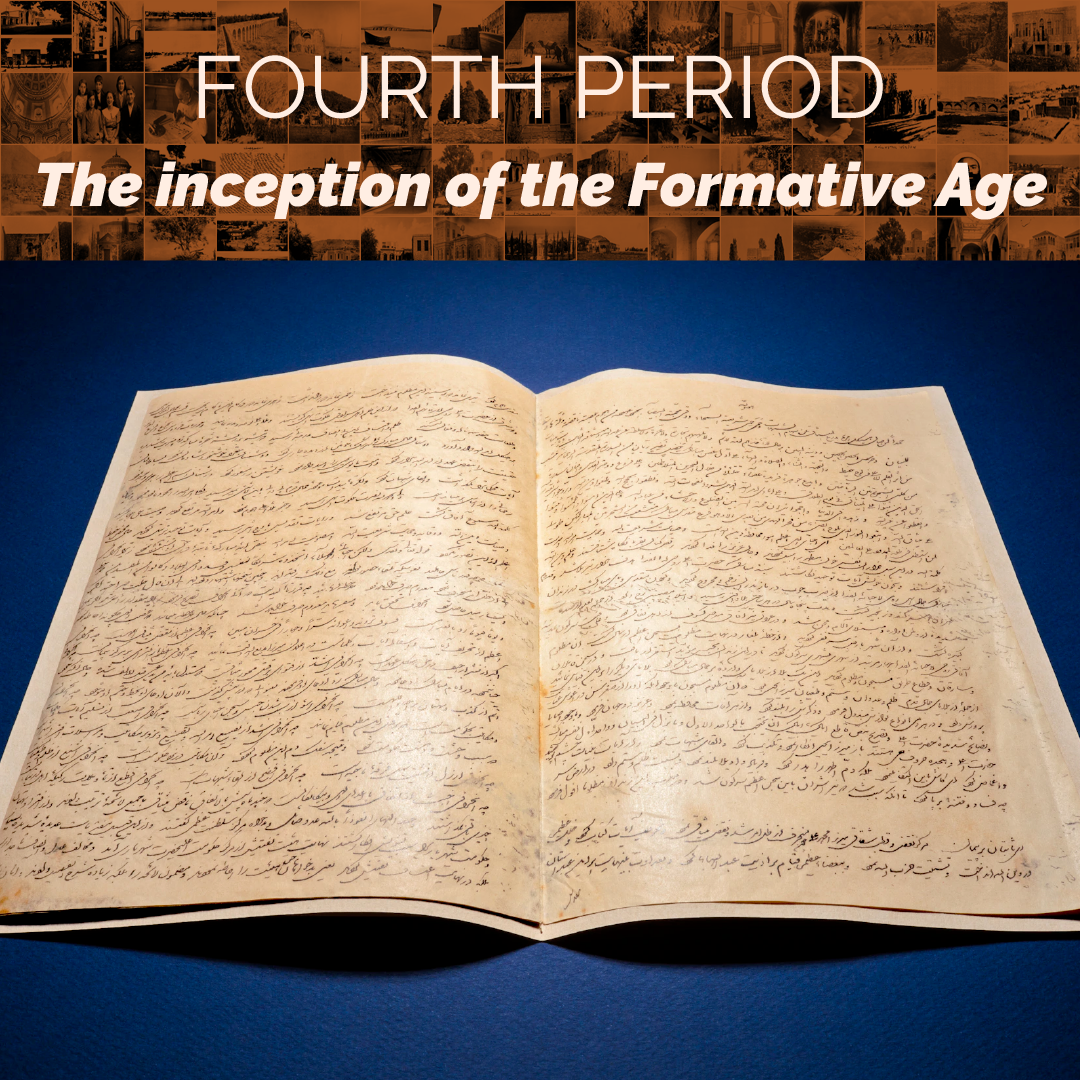
This period addresses the ministry of Shoghi Effendi, but in the Guardian’s characteristic humility, he does not mention his name a single time in the 412 pages of
God Passes By, if you exclude his name on the first page, as author of the book.
The very first subject Shoghi Effendi tackles in his survey of the first epoch of the Formative Age, is the rise and establishment of the Bahá'í Administrative Order, drawing its origins straight from the Will and Testament of 'Abdu'l-Bahá. Shoghi Effendi begins by detailing why the Bahá'í Administrative Order is unique in the annals of religious history, and explains that the Formative Age is a period of gradual development in which the nascent Bahá'í Institutions will grow through a period of alternating crisis and victories, laying the foundation for Bahá'u'lláh’s Golden Age.
Shoghi Effendi amply demonstrates the futility of the Covenant-breakers efforts to destabilize the Faith after the passing of 'Abdu'l-Bahá, and lists their failures.
To show the growth accomplished in just 20 years, Shoghi Effendi lists extraordinary achievements by both Bahá'í institutions and Bahá'í individuals in the field of teaching and administration, in particular, the formation of Assemblies on a sound constitutional and legal basis, and official recognitions of the Bahá'í Faith— in particular the United States and an edict issued by ecclesiastical authorities in Egypt—but also the inauguration of the Mother Temple of the West, publishing houses, summer schools.
Shoghi Effendi is generous and fair in his praise of accomplishments by individuals and national communities in the field of teaching, and he especially singles out the priceless services of Martha Root, as well as the contribution of the American Bahá’ís in spreading the Faith to all corners of the earth.

The Guardian ends God Passes By with a 14-paragraph conclusion called “Retrospect and Prospect” in which he reviews the salient episodes that marked Bahá'í history in the last 100 years (Retrospect), while he looks ahead to the future development of the Bahá'í Faith (Prospect).
Shoghi Effendi has a particularly elegant and apt description for the advancement of the Faith in this section. He not only describes the spiritual nature and characteristics of this process, but he traces it methodically from Persia to Iraq, to the Holy Land to every continent in the world, in a single, achingly beautiful sentence:
A process, God-impelled, endowed with measureless potentialities, mysterious in its workings, awful in the retribution meted out to every one seeking to resist its operation, infinitely rich in its promise for the regeneration and redemption of human kind, had been set in motion in Shíráz, had gained momentum successively in Ṭihrán, Baghdád, Adrianople and ‘Akká, had projected itself across the seas, poured its generative influences into the West, and manifested the initial evidences of its marvelous, world-energizing force in the midst of the North American continent.
Shoghi Effendi’s overarching understanding of the Faith’s history and his far-reaching vision of its future may be glimpsed in the quote provided below:
Whatever may befall this infant Faith of God in future decades or in succeeding centuries, whatever the sorrows, dangers and tribulations which the next stage in its world- wide development may engender, from whatever quarter the assaults to be launched by its present or future adversaries may be unleashed against it, however great the reverses and setbacks it may suffer, we, who have been privileged to apprehend, to the degree our finite minds can fathom, the significance of these marvelous phenomena associated with its rise and establishment, can harbor no doubt that what it has already achieved in the first hundred years of its life provides sufficient guarantee that it will continue to forge ahead, capturing loftier heights, tearing down every obstacle, opening up new horizons and winning still mightier victories until its glorious mission, stretching into the dim ranges of time that lie ahead, is totally fulfilled.
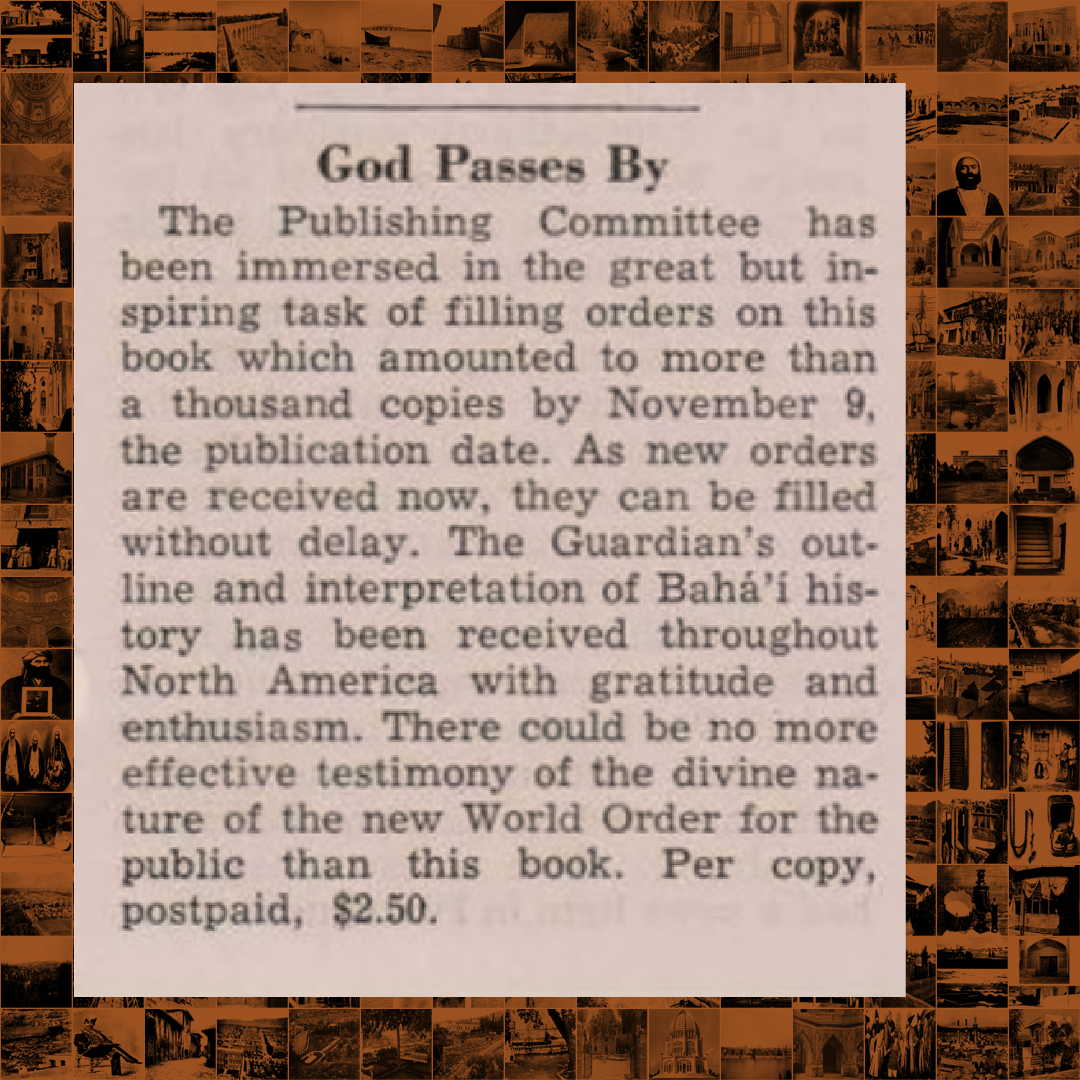
God Passes By is finally published and advertised for sale at $2,50 a copy in Bahá'í News, Issue 172: December 1944 on page 7.
The Guardian had originally intended God Passes By to be published on time for the Centennial celebrations on 23 May 1944, and he had mailed the final manuscript to the United States on time. Although it progressively became obvious to Shoghi Effendi that his intended publication date would not be met, he still urged the book be published as soon as possible.
In a letter dated 28 July 1944, the Guardian’s secretary informed George Townshend about the publication delay citing several reasons, but noting that it was a miracle God Passes By had been completed in the middle of World War II:
Owing to pressure of priority work in the States God Passes By will not be delivered by the printer until after the end of August. The Guardian was sorry the book could not be gotten out in time for the Centenary; but such things cannot be avoided in wartime, and the real miracle is that the manuscript should have gone to you and been returned and gone out again to the USA and been safely received! Proofs have been given, however, for use in special courses of the Bahá’í Summer Schools. He thought you would like to know these things, after all the pains you took with the manuscript.
God Passes By did not make it off the printing press until 15 November 1944.
The first edition of God Passes By cost was $2.50, it was 436 pages and bound in dark red fabrikoid, a synthetic leather made from coated cotton.

There is no more perfect example of Shoghi Effendi’s mastery of dramatic prose than the majestic opening paragraph of God Passes By, comparing the Báb to a meteor, lighting the dark skies of Persia:
May 23, 1844, signalizes the commencement of the most turbulent period of the Heroic Age of the Bahá’í Era, an age which marks the opening of the most glorious epoch in the greatest cycle which the spiritual history of mankind has yet witnessed.
No more than a span of nine short years marks the duration of this most spectacular, this most tragic, this most eventful period of the first Bahá’í century. It was ushered in by the birth of a Revelation whose Bearer posterity will acclaim as the “Point round Whom the realities of the Prophets and Messengers revolve,” and terminated with the first stirrings of a still more potent Revelation, “whose day,” Bahá’u’lláh Himself affirms, “every Prophet hath announced,” for which “the soul of every Divine Messenger hath thirsted,” and through which “God hath proved the hearts of the entire company of His Messengers and Prophets.”
Little wonder that the immortal chronicler of the events associated with the birth and rise of the Bahá’í Revelation has seen fit to devote no less than half of his moving narrative to the description of those happenings that have during such a brief space of time so greatly enriched, through their tragedy and heroism, the religious annals of mankind. In sheer dramatic power, in the rapidity with which events of momentous importance succeeded each other, in the holocaust which baptized its birth, in the miraculous circumstances attending the martyrdom of the One Who had ushered it in, in the potentialities with which it had been from the outset so thoroughly impregnated, in the forces to which it eventually gave birth, this nine-year period may well rank as unique in the whole range of man’s religious experience.
We behold, as we survey the episodes of this first act of a sublime drama, the figure of its Master Hero, the Báb, arise meteor-like above the horizon of Shíráz, traverse the sombre sky of Persia from south to north, decline with tragic swiftness, and perish in a blaze of glory. We see His satellites, a galaxy of God-intoxicated heroes, mount above that same horizon, irradiate that same incandescent light, burn themselves out with that self-same swiftness, and impart in their turn an added impetus to the steadily gathering momentum of God’s nascent Faith.
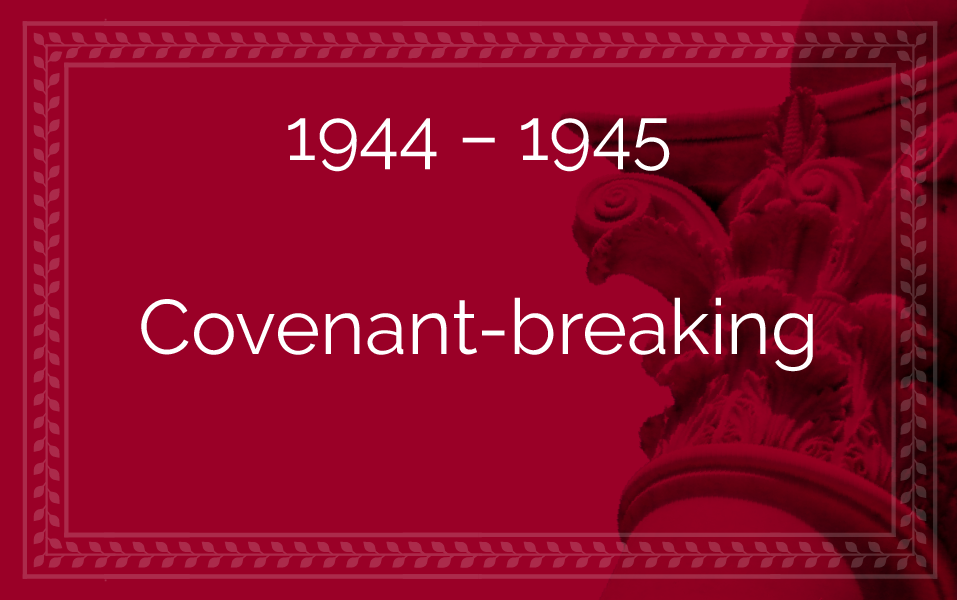
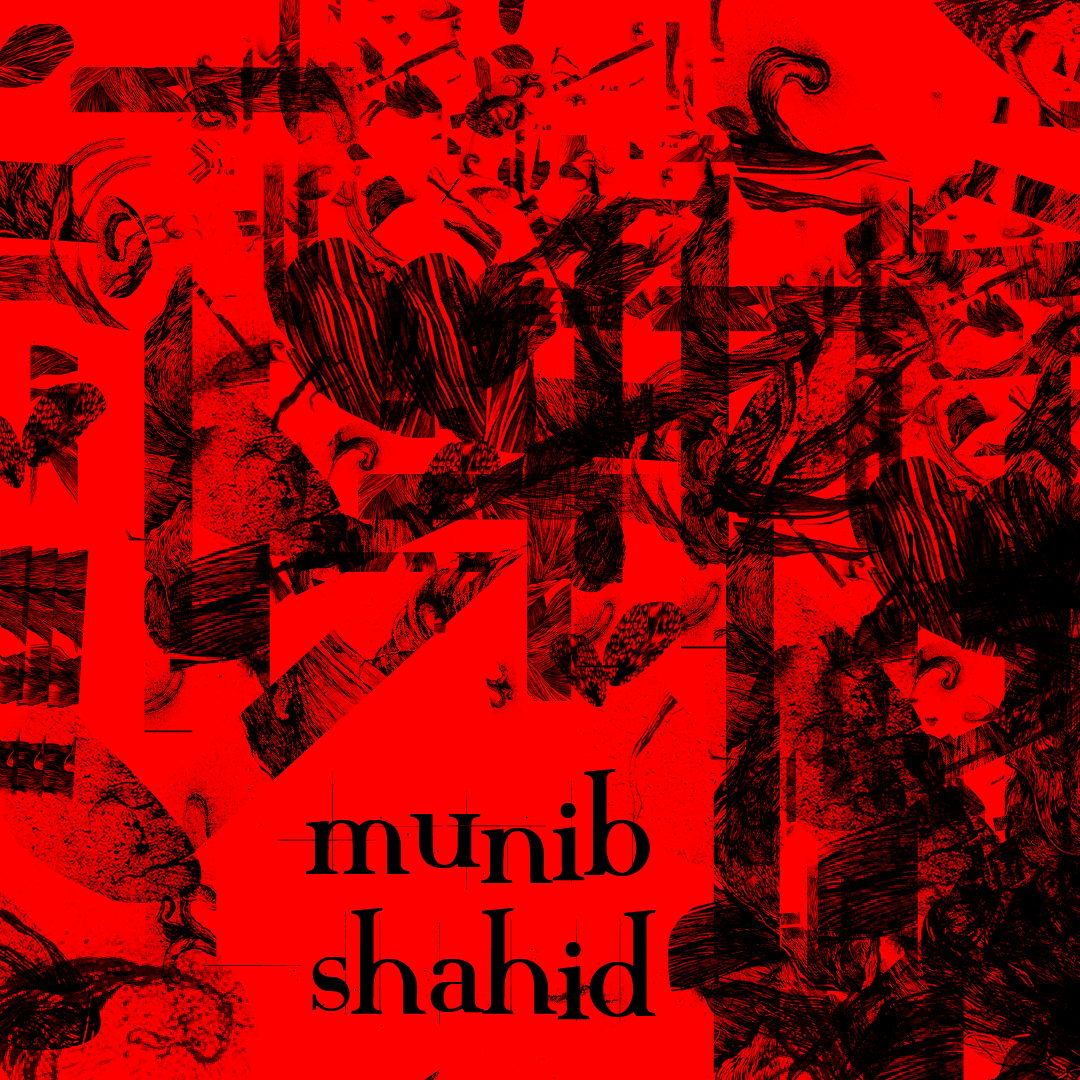
Muníb Shahíd had a Bahá'í pedigree as eminent as it gets.
His grandfather was the King of Martyrs, the most illustrious of the Apostles of Bahá'u'lláh's, who was savagely killed with his brother, the Beloved of Martyrs.
His father was Munírih Khánum’s cousin, who had come to live in the Holy Land at Bahá'u'lláh’s invitation after their father was martyred.
His mother was Rúhá Khánum, the third daughter of 'Abdu'l-Bahá and Munírih Khánum.
He was the grandson of 'Abdu'l-Bahá and the great-grandson of Bahá'u'lláh.
He became an apostate to the Bahá'í Faith when he contracted a Muslim marriage instead of a Bahá'í marriage with a woman who was great-niece of the Grand Mufti of Jerusalem—an enemy of the Faith— and so doing forced Shoghi Effendi to denounce him publicly in a 7 November 1944 cable to the National Spiritual Assembly of the United States and Canada:
Moneeb Shaheed, grandson of both ‘Abdu’l-Bahá and the King of Martyrs, married according to the Moslem rites the daughter of a political exile who is nephew of the Grand Mufti of Jerusalem. This treacherous act of alliance with enemies of the Faith merits condemnation of entire Bahá’í world.
When the National Spiritual Assembly of the United States and Canada offered their loyalty to Shoghi Effendi and expressed sadness at the situation, the Guardian responded very honestly in a cable dated 19 November 1944:
Comforted, strengthened, by assurance of sympathy and loyalty of American believers in the deplorable, delicate situation created by dishonorable alliances made by members of my family, first with Covenant-breakers and now with external enemies of the Faith.
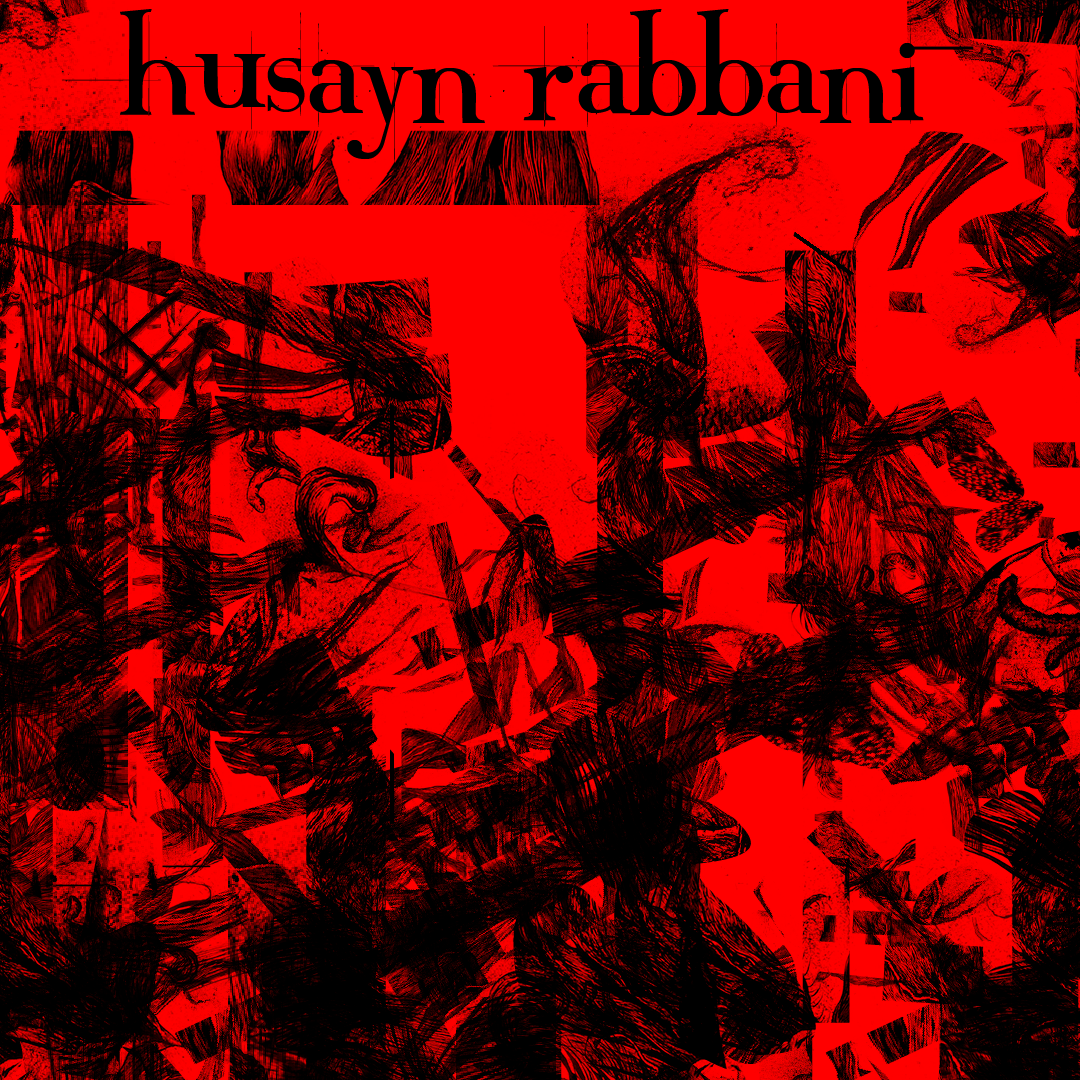
Shoghi Effendi’s brother Ḥusayn Rabbání was born immediately after him, his closest sibling in age. Ḥusayn had been Shoghi Effendi’s secretary for several years.
When his Covenant-breaking became obvious to the Guardian, it was so difficult for Shoghi Effendi that he held off from sending the official cable for eight full months while he tried—in vain—to remedy the situation, showing patience and spiritual endurance in dealing with his brother, hoping against hope he would not have to send the cable.
In the end, the Guardian was forced to inform the world of yet another member of his family had broken the Covenant, and he sent the cable he had held onto for eight months since September 1944.
This is how the Guardian announced his brother’s defection to the Bahá'í world on 16 April 1945:
My faithless brother Husayn, after long period of dishonourable conduct, has abandoned the Master's home to consort with his sister and other Covenant-breakers.

Between 1940 and 1945, while Shoghi Effendi’s family was breaking the covenant and breaking his heart, and while all the other Covenant-breakers in the East and the West were continuing their attacks on the Guardian, the Administrative Order and the Covenant, Rúḥíyyih Khánum kept notes on Shoghi Effendi’s suffering.
These are three separate diary entries from those years, that will put a human face on the suffering of our beloved Guardian, needless suffering, that did not have to happen, but suffering he withstood, and attacks on the Faith that eventually only had a single, overwhelming effect: to strengthen the tree of the Cause of Bahá'u'lláh.
He goes on, but it is like a man in blizzard who cannot sometimes even open his eyes for the blinding snow.
He is like a man whose skin has been burned off...it is a miracle he can keep going.
I feel sure the tide will turn. but oh, never, never to find Shoghi Effendi as he was! I don't think anything in this world will ever be able to efface what these last years have done to him! Time is a great healer but it cannot remove scars." "It seems it is all irretrievably broken.
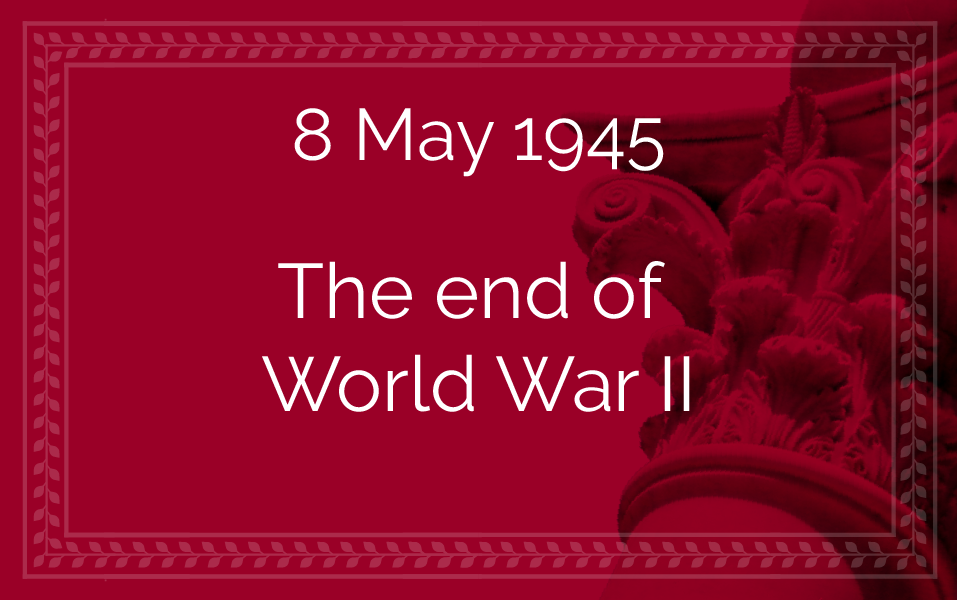

A truck of revelers passing through the Strand, London as joyful celebrations of the end of the war in Europe break out on 8 May 1945. Source: Wikimedia Commons
Adolf Hitler, the Nazi leader, committed suicide on 30 April 1945 during the Battle of Berlin. Hitler’s successor, Karl Dönitz, signed an act of military surrender at 2:41 AM on 7 May 1945 in Reims, France, and the definitive German Instrument of Surrender was signed 24 hours later on Tuesday 8 May 1945 in Berlin at 10:43 PM.
Upon the defeat and surrender of Germany, celebrations erupted throughout the Western world, especially in the United Kingdom and in North America. More than 1 million people celebrated in the streets throughout the United Kingdom, massing in Trafalgar Square and up the Mall to Buckingham Palace, where King George VI, his wife, their daughters and Prime Minister Winston Churchill, appeared on the balcony of the palace before the cheering crowds. Churchill addressed a large crowd at Whitehall with these words:
God bless you all. This is your victory. In our long history, we have never seen a greater day than this. Everyone, man or woman, has done their best.
World War II was officially ended.

In a photo by Ed Westcott, residents of Oak Ridge, TN, fill Jackson Square to celebrate the surrender of Japan. Source: Wikimedia Commons.
The very next day, 9 May 1945, a joyful and relieved Guardian cabled the Bahá'ís in America, with a momentous message entitled “A Single, Organically United World Commonwealth.” The message began with these words:
Followers Bahá’u’lláh throughout five continents unanimously rejoice partial emergence war-torn humanity from titanic upheaval unerringly predicted seventy years ago by pen author their faith. Cessation hostilities European continent signalizes closing yet another chapter tragic tale fiery trials providentially decreed by inscrutable wisdom designed ultimately weld mutually antagonistic elements human society into single organically united unshatterable world commonwealth. Gratefully acclaim signal evidence interposition divine providence which during such perilous years enabled world center faith escape what posterity will recognize as one of gravest dangers ever confronted nerve center its institutions.
In the remainder of the cable, the Guardian expresses his gratitude at the safety of Bahá'í communities worldwide, and outlines the progress made, the victories won, and the accomplishments achieved over the last six years, despite the raging war, a collective enterprise he describes as outshining the sum total of all accomplishments of the Bahá'í community since the inception of the Formative Age.
This was not just a celebration of the end of a war that had torn the world apart. It was also a celebration of the healing and spiritual light that Bahá'ís had managed to shed on an ailing world.
The Guardian urged Bahá'ís to rise up now, in peace-time, and launch the second stage of the Divine Plan.
It is in moments like this that Shoghi Effendi shines brightest.
There is no better example of that particular combination of qualities in the Guardian: His brilliant leadership, his unquenchable enthusiasm, his far-reaching vision, his divinely-guided words of encouragement, his unstoppable determination.
Whatever the state of the world, whatever his own physical health, regardless of what was happening in Palestine, the Guardian forged on, Inexorably, irresistibly, invincibly, indomitably, relentlessly forward. He always looked at the next stage, the stage after that, the stage after the stage after that one. He was like a chess Grand-Master, but seeing infinite moves ahead, how each victory would eventually lead, centuries from now to the Golden Age of the Faith of Bahá'u'lláh.
The world was no longer in the spasms of World War II, but in many ways, it was in a more emotionally devastated place.
With the end of the war, its monstrous, barbaric, planetary costs came to light.
World War II was the most destructive war in history. Its devastation turned much of Europe into rubble: cities laid waste and consumed by firestorms, a charred and blackened countryside with roads pitted with shell holes or bomb craters, annihilated railways, destroyed bridges and harbors filled with sunken ships.

Top: The explosion of the drydocked USS Shaw on 7 December 1941 during the Japanese attack on Pearl Harbor, Hawaii. Source: Wikipedia Commons. Bottom: The retaliation on Japan: The atomic bomb mushroom clouds over Hiroshima (left) and Nagasaki (right). Photo on the left: On 6 August 1945, smoke billowed 6,000 meters (6 kilometers) above Hiroshima while smoke from the burst of the first atomic bomb had spread over 3,000 meters (3 kilometers) on the target at the base of the rising column. Six planes of the 509th Composite Group participated in this mission: one to carry the bomb (Enola Gay), one to take scientific measurements of the blast (The Great Artiste), the third to take photographs (Necessary Evil), while the others flew approximately an hour ahead to act as weather scouts.. Photo on the right: Atomic bombing of Nagasaki on 9 August 1945, taken by Charles Levy. Source: Wikimedia Commons.
The war had ravaged the earth, all the way into the heart of the Pacific. The United States was attacked when Pearl Harbor was bombed in December 1941 by 353 Japanese fighters and bombers. Four years later, the United States dropped the atomic bomb on Hiroshima and Nagasaki, Japan, killing 200,000 civilians and flattening the cities in seconds.
The casualties in the Soviet Union and in China were horrific, both countries losing more than 20,000,000 people each, both soldiers and civilians.
The world discovered with indescribable horror the Holocaust, Nazi Germany’s deliberate, organized, state-sponsored persecution and machinelike murder of approximately 6 million European Jews and at least 5 million Soviet prisoners of war, Romany, Jehovah’s Witnesses, homosexuals, and other victims.
Things were difficult in Palestine under the British Mandate after the war.

“Shoghi Effendi in 1945.” Digital painting.
Six long years of war had exhausted and strained the Guardian.
During that time, he had written two of the most important works of his ministry, The Promised Day is Come in 1941, and God Passes By, between 1942 and 1944.
Shoghi Effendi had spent six years expending a never-ending output of energy, enthusiasm, and encouragement to galvanize the Bahá'í world into action, spurring them on and guiding them towards incredible, amazing victories in the field in the first five years of the first Seven Year Plan.
The Guardian had single-handedly held the Bahá'í world together, comforted and inspired the friends, deepened and expanded the life of national Bahá'í communities worldwide, and had initiated what would be forever known as one of the crowning achievements of his Guardianship, the erection of the superstructure of the Shrine of the Báb.
During this entire time, Shoghi Effendi’s sole support was Rúḥíyyih Khánum. The Guardian’s entire family—'Abdu'l-Bahá’s family—had spiritually died and been severed from him, victims one and all to the soul-devouring disease of Covenant-breaking.
The Guardian was 48 years old. His hair was turning white at the temples, and his shoulders were bent from thousands of hours arched over his desk and the never-ending work. Rúḥíyyih Khánum felt that what he had gone through had not only saddened his heart, but it was slowly, inexorably wearing it out.

The Jacobite steam train crossing Glenfinnan Viaduct in Scotland, a train still in operation when Shoghi Effendi and Rúḥíyyih Khánum traveled by train to Scotland in 1945. Source: Wikimedia Commons.
Rúḥíyyih Khánum stated that she and Shoghi Effendi left for Scotland “right after” the end of World War II, and they traveled around Scotland by train.
This is all the information we have about Shoghi Effendi and Rúḥíyyih Khánum’s first trip to Scotland by train, gleaned from a talk Hand of the Cause Amatu’l-Bahá Ruḥíyyíh Khánum gave in Edinburgh in 1981, and this extremely short story is placed here as a gentle marker that ends the constant pressures of war on our beloved Guardian, as we imagine him and his wife Rúḥíyyih Khánum discovering Scotland—the ancestral land of Rúḥíyyih Khánum’s father William Sutherland Maxwell—together by train.

St. James’ park and its lake, where Shoghi Effendi read Gibbon out loud to Rúḥíyyih Khánum. This photograph, taken east of the Blue Bridge is by © User:Colin. Source: Wikimedia Commons.
Shoghi Effendi loved the style of Edward Gibbon in The Decline and Fall of the Roman Empire so much that he never traveled without it, and Rúḥíyyih Khánum remembered a particular pleasant member on one of their tips to London:
I particularly remember one peaceful hour (so rare, alas) when we sat on a bench facing the lake on a summer afternoon in St James' Park in London and he read me Gibbon out loud.
Rúḥíyyih Khánum described The Decline and Fall of the Roman Empire as Shoghi Effendi’s “own pet bible of the English language,” saying
He often he would read to me excerpts from it, interrupting himself with exclamations such as "Oh what style; what a command of English; what rolling sentences; listen to this." With his beautiful voice and pronunciation - in the direction of what we call an "Oxford accent", but no exaggeratedly so - the words fairly glowed with colour and their value and meaning came out like shining jewels.
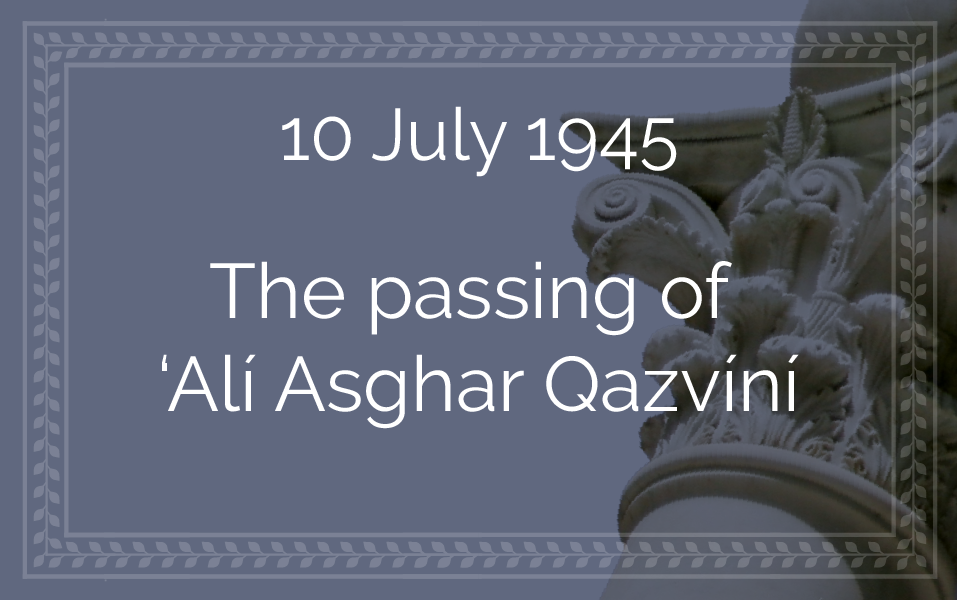
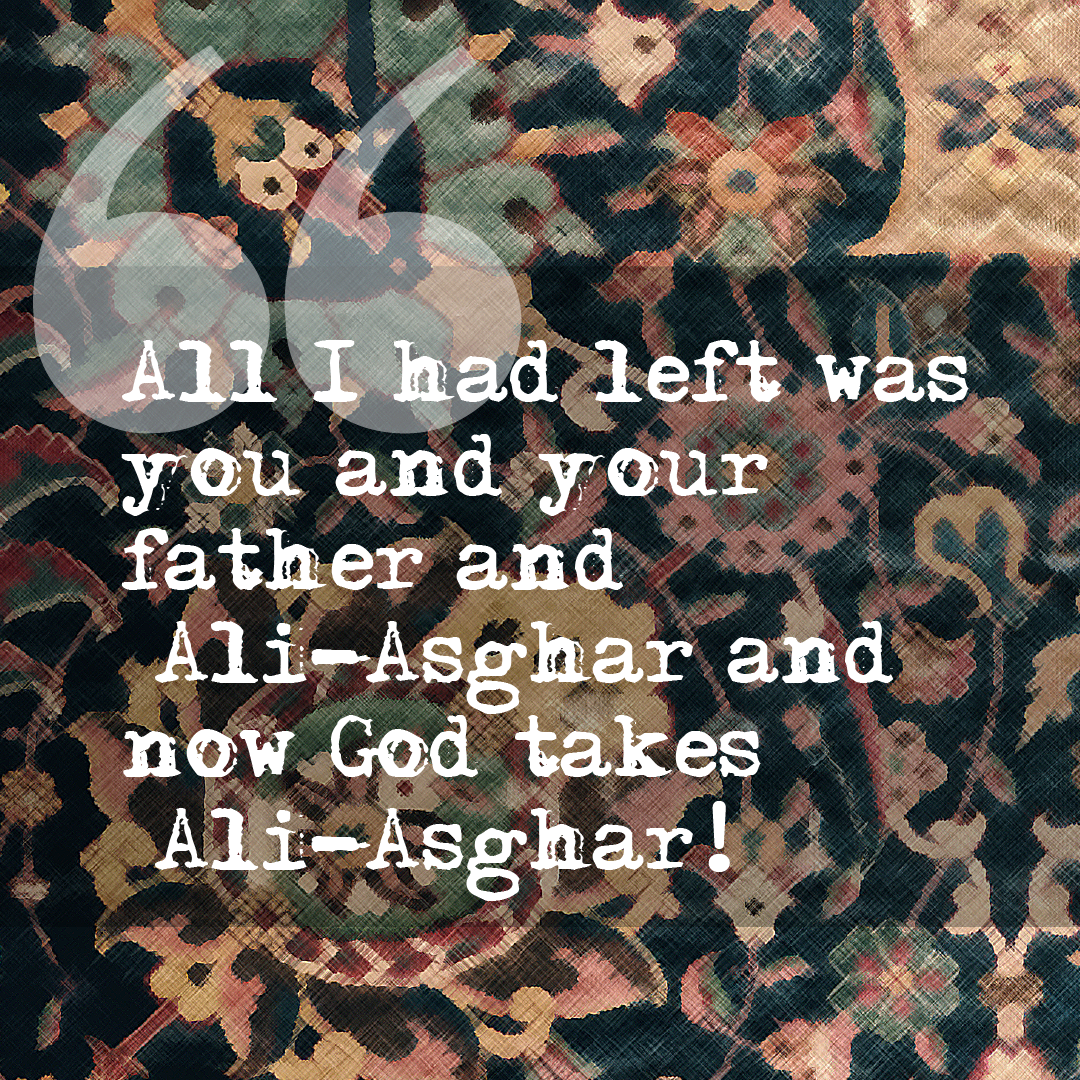
“All I had left.” Background image by Kadir Celep on Unsplash.
‘Alí-Aṣghar Qazvíní had served the Guardian for 25 years with the greatest loyalty, love, and discretion. Among his many duties, perhaps his most illustrious was as postman to the Guardian.
In a quarter century of dedicated, steadfast service to the Guardian, ‘Alí-Aṣghar had become a fixture of the Bahá'í World Centre. Everyone admired him and envied the bond he had with Shoghi Effendi, and by the end of his life, when pilgrims wrote him letters, they signed by calling themselves “the servant of the servant of the House.”
‘Alí-Aṣghar had worked until the very end, until his hair had turned white, until he was stooped with age and almost blind. During the war, he had carried sacks of rationed bread so heavy, he had bent over from the weight.
Despite his already precious services to the Guardian, ‘Alí-Aṣghar loved Shoghi Effendi so much that, even when his health was failing, he hiked up Mount Carmel and labored in the gardens to contribute to the sacred work of beautifying the Shrine of the Báb.
Every thought of ‘Alí-Aṣghar was turned to service and to serving the Guardian.
In the last year of his life, when he was 75, ‘Alí-Aṣghar, strong as an ox, was ravaged by an incurable disease. The Guardian cared for him until his last breath.
On 6 July 1945, ‘Alí Asghar was admitted to the hospital after his health had been declining for 3 or 4 days. This was a great blow to Shoghi Effendi who called him the “most precious” person he had. Shoghi Effendi went to see ‘Alí-Aṣghar in the hospital, and returned home, knowing that ‘Alí Asghar was not long for this world, and told Rúḥíyyih Khánum:
All I had left was you and your father and ‘Alí-Aṣghar and now God takes ‘Alí-Aṣghar!
Shoghi Effendi began planning a wonderful funeral for his beloved friend.

Stunning lion portrait by MARIOLA GROBELSKA on Unsplash. Background image by Kadir Celep on Unsplash.
The next day, 7 July 1945, Rúḥíyyih Khánum stayed with ‘Alí-Aṣghar for four hours from 4 to 8 PM, and conveyed to him a message from the Guardian: he wanted ‘Alí Asghar to know the splendid reward that awaited him in the next world, and so he had cabled the Iranian Bahá'ís about him and that he had called him ”the lion of the forest of the love of God.”
‘Alí Asghar was still fully conscious but extremely weak when Rúḥíyyih Khánum shared this news with him and she said that “the cutest little tickle of a smile of happiness went over his face” and Rúḥíyyih Khánum told him that he had gone to heaven before leaving this world.
‘Alí-Aṣghar was silent for some time, whispering appreciation to the Guardian and asked Rúḥíyyih Khánum to tell Shoghi Effendi that he had copied in beautiful handwriting The Centenary review of the Faith in Persian, and he wished his manuscript to be bound with the money he was leaving behind, and offered as his last gift to Shoghi Effendi.
When Rúḥíyyih Khánum returned home that evening and told Shoghi Effendi, his eyes filled with tears. The Guardian told the women assembled in the drawing room of the house of 'Abdu'l-Bahá that ‘Alí-Aṣghar was like the words in the Tablet of Aḥmad—" a flame of fire to My enemies and a river of life eternal to My loved ones”—and, as he left, he said:
He is in the Supreme Concourse, conversing with its inmates!
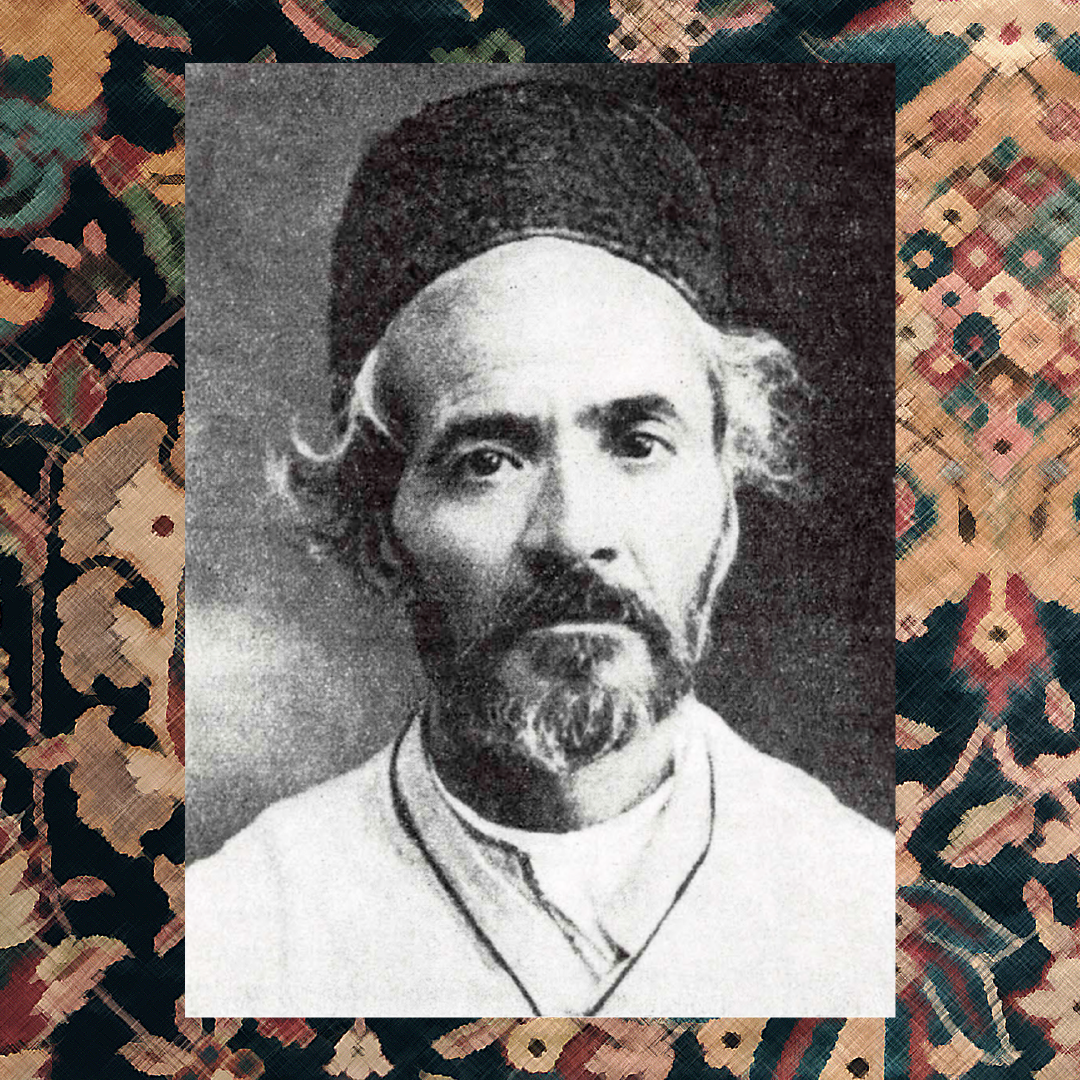
Photo of ‘Alí-Aṣghar Qazvíní. Source: The Bahá'í World Volume 10 page 531.
When he realized his death was approaching, ‘Alí-Aṣghar had written his will and testament, and these were his wishes:
He donated all his books and few personal effects to the men’s library in the Pilgrim House.
All the money he had left in the world were £40 which he offered to Shoghi Effendi.
‘Alí-Aṣghar died on 10 July 1945.
The Guardian himself visited the Shrines of the Báb and 'Abdu'l-Bahá and instructed a believer to bring him all the flowers from both thresholds. Shoghi Effendi went in alone and anointed ‘Alí-Aṣghar—whose body had been prepared for Bahá'í burial—with two bottles of attar of rose, reverently laid out the flowers from the Shrines on his body and wept for his friend.
When he returned home that night, he told his wife Rúḥíyyih Khánum something exceeding touching, that when he was alone with ‘Alí-Aṣghar’s body, his thought had been:
How that man had served me!
He told Rúḥíyyih Khánum that he pulled down the sheet and looked at face he didn’t look dead, he couldn’t be dead, he looked so natural that he wanted to tell his beloved friend:
‘Alí-Aṣghar, wake up, get up!

“Lion-hearted.” Background image by Kadir Celep on Unsplash.
‘Alí Asghar’s funeral was perfect.
Shoghi Effendi gave ‘Alí-Aṣghar’s eulogy, then called for the coffin to be brought up to the upper room of the eastern Pilgrim House.
The Prayer for the Dead was read and Shoghi Effendi sprinkled attar of rose on ‘Alí-Aṣghar’s coffin.
The Guardian’s hand was the first hand to reach out and raise his coffin, which was brought out to a car. ‘Alí-Aṣghar’s was a 25-car funeral procession. The Guardian instructed that all the flowers from the Shrines’ thresholds be brought to ‘Alí-Aṣghar’s grave.
After his funeral, the Guardian a cable to Iran:
Distinguished servant, blessed house, lion-hearted, steadfast, vigilant, indefatigable ‘Ali-Asghar ascended Abhá’. Kingdom. Twenty-five years exemplary, unforgettable service triumphantly ended. His innumerable services rendered Persian pilgrims merit holding memorial gatherings throughout Persia. Inform all believers. ‘Iraq friends should likewise honour his memory.


“Two-year respite.” Background image by Miroslav Trinko on Unsplash.
The two years from 1944 to 1946 were, what Shoghi Effendi called in his cable to the Bahá'í world, a “two-year respite” in his 23 April 1946 cable to the Bahá'í National Convention. On 10 August 1945 in a highly significant letter later titled “A New Phase of Human Evolution,” Shoghi Effendi had already spoken about this two-year break in spiritual terms, as:
…the period of transition intervening between the first and second stages of the greatest crusade ever launched in the history of the Faith of Bahá’u’lláh.
In this same letter, Shoghi Effendi set the stage of a world devastated by World War II, immediately drawing a link with the responsibility of the Bahá'í community:
The cessation of hostilities on the continent of Europe, the prospect of an early termination of the bloody conflict raging in the Far East, invest the members of the world Bahá’í community, and particularly its standard-bearers in the great Republic of the West, with a great, a unique, and inescapable responsibility.
The Guardian announced a new era in human evolution, again calling on the Bahá'ís to be ready for the next world crusade:
As a new phase in the painful evolution of a sorely tried and wayward humanity opens, a new challenge summons the prosecutors of a Divine Plan to gird up their loins, muster their resources, and prepare themselves for the launching of the second stage of an enterprise which, as it reveals its full potentialities, must stretch to embrace the five continents of the globe.
Towards the end of this letter, so majestic and rhythmic, so filled with anticipation, one can almost hear the beat of the Guardian’s sentences like the sound of a drum calling all Bahá'ís to their next spiritual victory:
Time is pressing, the work that still remains to be accomplished in the New World is vast and urgent, the need of the suffering masses the world over, and particularly in Europe, is pitiable, the sustaining grace destined to be vouchsafed from on high to those who will arise to achieve that task and fulfill this need is boundless and assured.
The second Seven Year Plan was about to launch.
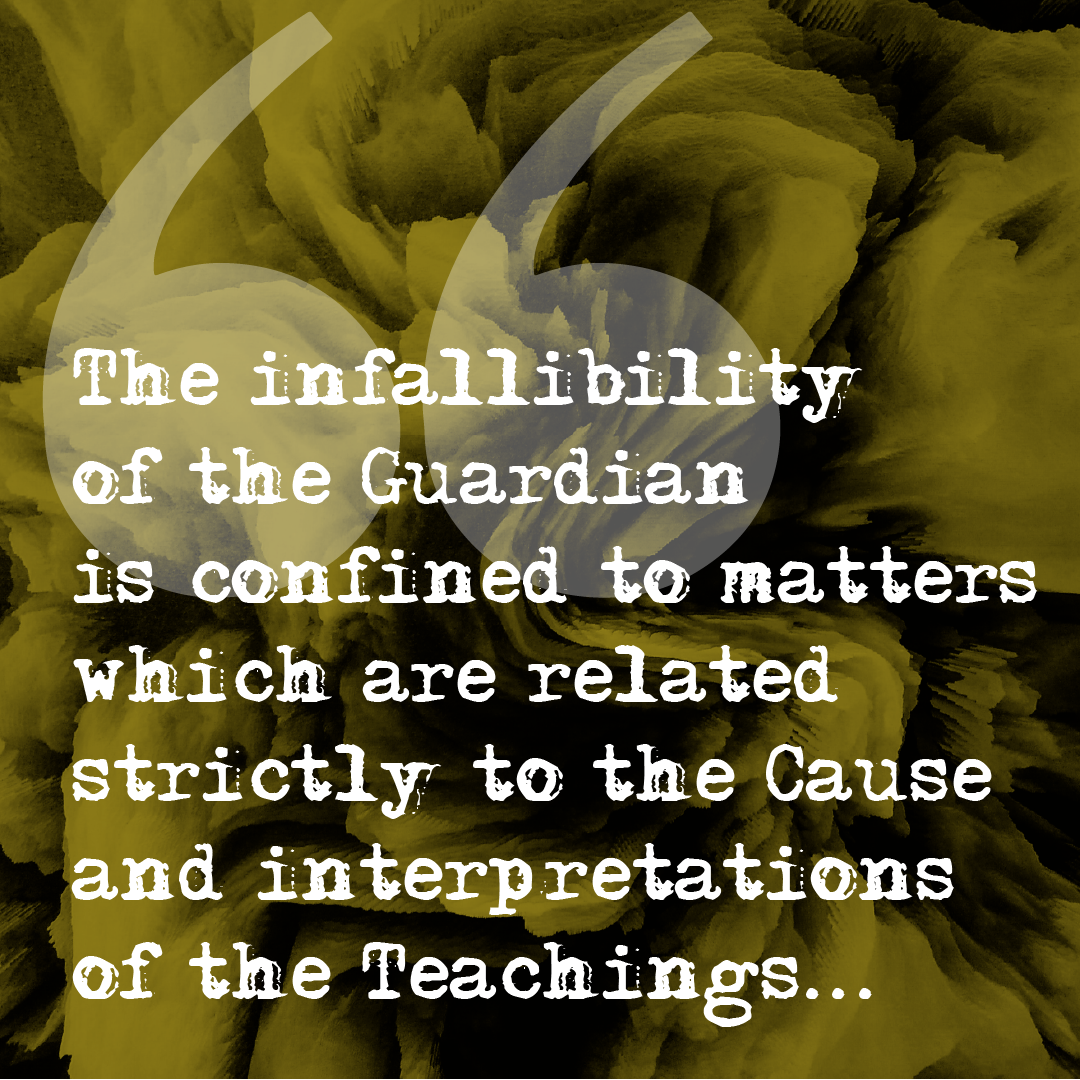
“Infallibility.” Background image by Orfeas Green on Unsplash.
Shoghi Effendi, the grandson of 'Abdu'l-Bahá had been sublimated by the forces released in the Master’s Will and Testament into the Guardian of the Faith, and invested by that same document with the powers of infallible guidance, conferred on him by the operation of Bahá'u'lláh’s Covenant.
This is the passage in which 'Abdu'l-Bahá confirms the Guardian’s infallibility:
The sacred and youthful branch, the Guardian of the Cause of God, as well as the Universal House of Justice, to be universally elected and established, are both under the care and protection of the Abhá Beauty, under the shelter and unerring guidance of the Exalted One (may my life be offered up for them both). Whatsoever they decide is of God.
'Abdu'l-Bahá says three things in these two sentences:
- That the Guardian and the Universal House of Justice—once established in the case of the Guardian or elected in the case of the Universal House of Justice—are both under the care and the protection of Bahá'u'lláh HIMSELF: First emphasis on infallibility.
- That the Guardian and the Universal House of Justice are both under the shelter and UNERRING (exact synonym for infallible) of Bahá'u'lláh: Second clear statement and clearer emphasis on infallibility
- Whatever the Guardian or the Universal House of Justice decide is of God: Third emphasis that they are infallible and should be obeyed by all Bahá'ís.
If this was not enough, the Guardian himself wrote to letters regarding his infallibility. The first in 1944 in which he states his infallibility is categoric but strictly confined to the Bahá'í Faith and its teachings, and not every subject on earth:
The infallibility of the Guardian is confined to matters which are related strictly to the Cause and interpretations of the Teachings; he is not an infallible authority on other subjects, such as economics, science, etc.
And the second in 1956 where the Guardian emphasizes his infallibility in relation to his interpretation of the Teachings as part of his station as Interpreter:
The Guardian’s infallibility covers interpretation of the revealed word, and its application. Likewise, any instructions he may issue having to do with the protection of the Faith, or its wellbeing must be closely obeyed, as he is infallible in the protection of the Faith. He is assured the guidance of both Bahá’u’lláh and the Báb, as the Will and Testament of ‘Abdu’l-Bahá clearly reveals.

From top to bottom and left to right: The National Spiritual Assemblies of the United States and Canada, Iran, the British Isles, the National Spiritual Assembly of Germany, reinstituted on 7 April 1947 in Stuttgart, Egypt and the Sudan, Iraq, India and Burma and Australia and New Zealand. Source: all photos from The Bahá'í World Volume 10.
In building the Administrative Order, the Guardian constantly had to explain and clarify it to the National Spiritual Assemblies, until his passing, until they understood how the various institutions, including the Guardianship, fit together.
As late as 13 May 1945, the Guardian was forced to explain to a National Spiritual Assembly his administrative powers:
Just as the N.S.A. has full jurisdiction over all its Local Assemblies, the Guardian has full jurisdiction over all National Assemblies; he is not required to consul them, if he believes a certain decision is advisable in the interest of the Cause. He is the judge of the wisdom and advisability of the decision made by these bodies, and not they of the wisdom and advisability of his decisions. A perusal of the Will and Testament makes this principle quite clear. He is the Guardian of the Cause in the very fullness of that term, and the appointed interpreter of the Teachings, and is guided in his decisions to do that which protects it and fosters its good and highest interest.
He always has the right to step in and countermand the decisions of an N.S.A.; if he did not possess this right he would be absolutely impotent to protect the Faith, just as the N.S.A., if it were divested of the right to countermand the decisions of a Local Assembly, would be incapable of watching over and guiding the national welfare of the Bahá'í community.
It very seldom happens—but it nevertheless does happen—that he feels impelled to change a major (as you put it) decision of an N.S.A.; but he always unhesitatingly does so when necessary, and the N.S.A. in questions should gladly and unhesitatingly accept this as a measure designed for the good of the Faith which its elected representatives are so devotedly seeking to serve.

Nine sample pages of the A World Survey of the Bahá'í Faith: 1844 - 1944, Shoghi Effendi: the cover page, the first page of the Table of Contents, page 8: Local Spiritual Assemblies in the United States, page 14: Bahá'í literature in Braille, page 17: Estimated value of American Bahá'í properties, page 19: Passages inscribed over the nine doors of the North American House of Worship in Wilmette and Shoghi Effendi’s beloved list of comparative measurements of four of the world’s famous domed structures, page 20: Principal Bahá'í Historic sites in Iran owned by the Bahá'í community, page 21: Cities visited by 'Abdu'l-Bahá in the course of His Three Year Travels (1911-1913), and the last page, page 22: Dates of Historic Significance During the First Bahá'í Century.
The Guardian had a passion for statistics, and an amazing memory for them, keeping in his mind at all times, the most current, exact statistics which he had in his possession, and always quoting them exactly to the Bahá'í pilgrims until the end of his life.
Beginning in 1944, he published a small, 26-page pamphlet on statistical information about the Bahá'í Faith. This pamphlet was expanded in 1950 to 35 pages which included a map, and expanded again in 1952, but at twice the size, and with information on the Ten Year Crusade.
These pamphlets don’t just give numbers, they give a chronological outline of the most important events in Bahá'í history, the best-known Writings of the Báb and Bahá'u'lláh, the Badi Calendar, and a very, very sweet little list that appeared in every edition of the pamphlet, and which was not related to Bahá'í buildings: "Comparative Measurements of Famous Domed Structures." In this little list, that stands all by itself, the Guardian listed the measurements of the domes of St. Peter's in Rome, St Paul's in London, St Sophia in Constantinople, the Pantheon in Rome.
The Guardian collected statistics for 13 years, starting in 1944 until his death in 1957, and his small notebook, with his latest statistics, was in his room when he passed away.
The story of Shoghi Effendi’s statistics is the tale of the Guardian’s superhuman effort to collect the most exact facts he could. He once held up one of his small notebooks, and told Rúḥíyyih Khánum:
Do you realize the whole Bahá'í world is in this?
Facts and statistics are unimpeachable. They tell the story of the victories the Guardian won, the heights the Bahá'í Faith reached, and the heroic efforts the Bahá'í community exerted. Shoghi Effendi’s statistics made the Bahá'í Faith concrete in its scope and reach, by showing the countries and localities it had penetrated, the number of languages its Holy Writings were translated in, the number of indigenous tribes that had been enrolled under the banner of the Cause.
These are just a sample of a few statistics Shoghi Effendi kept track of in his notebooks for 13 years:
- Countries opened to the Faith during the ministries of Bahá'u'lláh, 'Abdu'l-Bahá, and during the Guardianship; In 11 years from 1921 to 1932 only 5 new countries were added. Between 1953 and 1954, 100 countries were opened in just one year.
- Shoghi Effendi had a wonderful term for centers where Bahá’ís lived, he called them "foci of the warming and healing light of an all-conquering Revelation." There were 2,500 such centers in 1953, and 4,500 by 1957.
- Local Spiritual Assemblies: In North America, there were 47 in 1931, and in April 1957, there were 204. Shoghi Effendi had similar statistics for Local Spiritual Assemblies in Latin America, Australia and New Zealand, the United Kingdom, Germany, every country in fact.
- The number of languages in which Bahá'í publications were available: In 1944, there were 41 languages, and by 1957, there were 237.
- The number of indigenous peoples represented in the Bahá'í Faith: The Guardian attached a tremendous amount of importance this statistic, the realization of Bahá'u'lláh’s oneness of humanity in a single Faith: In 1944, there were only 41 ethnic groups, and by 1957, 197.
- Bahá'í properties, institutions, endowments, centers, incorporations.
- The number of countries in which Bahá'í marriage could be performed.
- The number of countries or places in which Bahá'í Holy Days were acknowledged.
- The financial assets of the Faith: from, $1,768,339 in 1944 to $5,000,000 in 1957.
To the Guardian, these numbers were life itself.
They were not data.
They were not statistics.
They told the dual story of the unfolding of the propagation of the Faith of Bahá'u'lláh and of the prosecution of 'Abdu'l-Bahá’s Divine Plan for the Planet, in people’s hearts and on the surface of the planet.
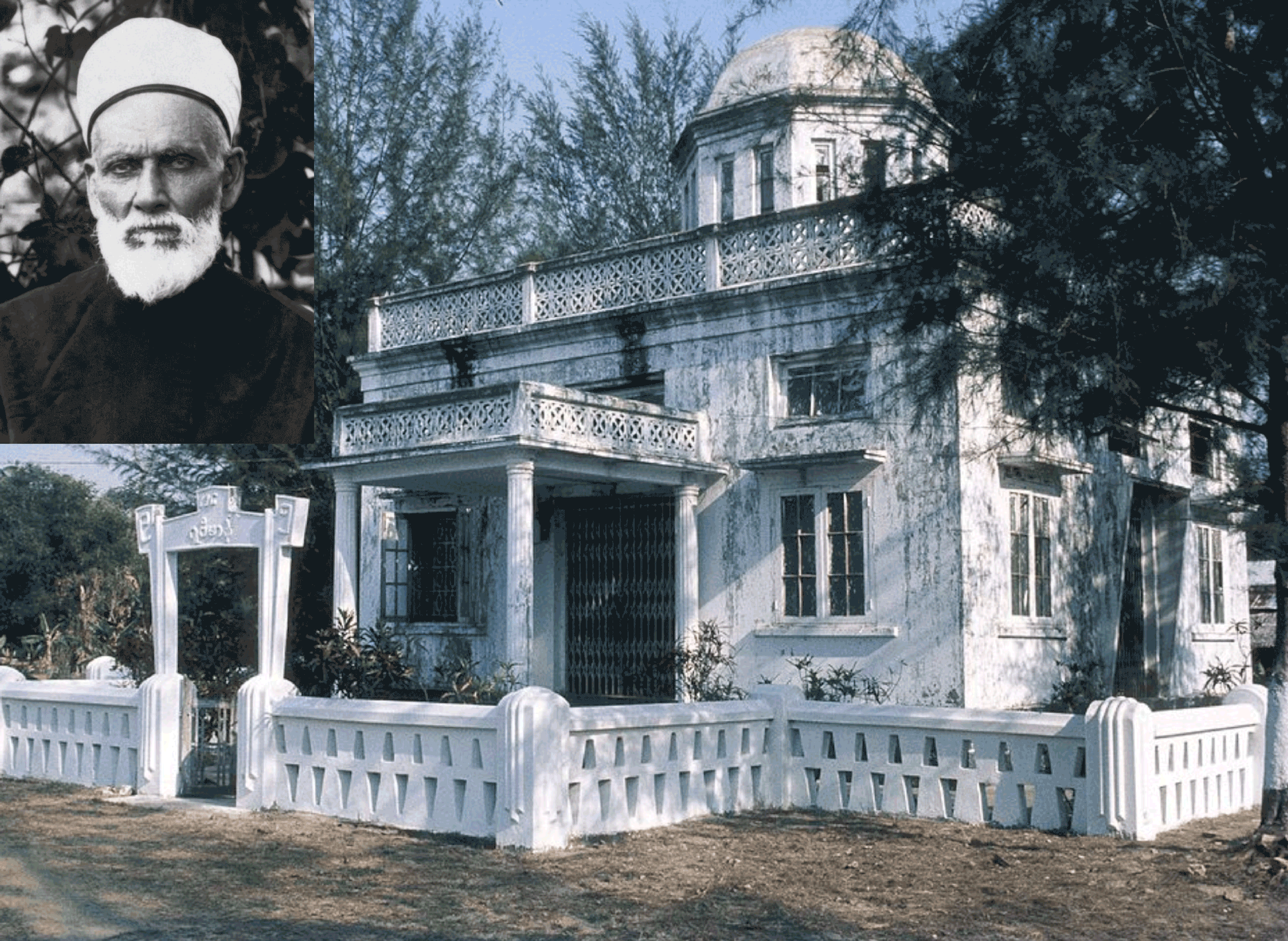
Siyyid Muṣṭafá Rúmí was born in Baghdad in 1846, but his family moved to Madras, India while he was a child. When he was 29, Siyyid Muṣṭafá Rúmí encountered the Bahá’í when he met Jamál Effendi, a Bahá’í travel teacher.
Instead of leaving Madras to return to Iraq, Siyyid Muṣṭafá Rúmí decided to accompany Jamál Effendi through India. Two years after discovering the Faith, Siyyid Muṣṭafá Rúmí became a Bahá'í in Calcutta in late 1877. After India, Siyyid Muṣṭafá Rúmí and Jamál Effendi traveled to Burma—now Myanmar—and despite not speaking Burmese, they widely proclaimed the Faith.
Jamál Effendi and Siyyid Muṣṭafá Rúmí left Rangoon, Burma for Mandalay, India in early 1879 and taught the Faith constantly with the help of two interpreters to a majority Muslim population. Their teachings attracted an influential silk merchant, Abdus Sattar, who built them a center in his home. Thanks to Abdus Sattar and his nephew Abdul Wahid, they were able to grow the local Bahá'í community to 200 people in Mandalay, and later, Abdus Sattar Abdul Wahid would receive many Tablets from Bahá'u'lláh.
It was during his stay in Mandalay that Siyyid Muṣṭafá Rúmí wrote his book The Standard of Truth or Reality, a book of Islamic prophecies on the coming of the Báb and Bahá'u'lláh.
After leaving Mandalay, Siyyid Muṣṭafá Rúmí settled in Burma and a village chief invited him to come and live in his village, Daidanaw. While living in Daidanaw, Siyyid Muṣṭafá Rúmí brought 800 people into the Faith and established a Bahá'í school using with financial support from the Bahá'ís in Rangoon.
In the 1880s, Siyyid Muṣṭafá Rúmí and Jamál Effendi traveled to Indonesia for an incredibly successful teaching trip. They traveled to the Bone sultanate in the south-west peninsula of what is now the island of Sulawesi and converted the tribal King and Queen to the Bahá'í Faith.
Around 1897, 'Abdu'l-Bahá began an extensive correspondence with the Bahá'ís of Burma, giving them a plan and very specific instructions for the construction of a marble sarcophagus. The one-piece sarcophagus should be of the finest marble, and 'Abdu'l-Bahá instructed Mishkín-Qalam, on a visit to Burma, to inscribe ‘Yá Bahá’u’l-Abhá’ (‘O Glory of the All-Glorious’) and ‘Yá ‘Alí’u’l-A‘lá’ (‘O Exalted of the Most Exalted Ones’) on the sides of the sarcophagus.
In 1899, when the sarcophagus was completed, Siyyid Muṣṭafá Rúmí sailed with the precious trust, guarding it all the way to 'Akká where he presented it in person to 'Abdu'l-Bahá.
Ten years later, on 21 March 1909, 'Abdu'l-Bahá was able to finally place the sacred remains of the Báb in the precious wood coffin inside the majestic marble sarcophagus, and lay them to rest forevermore in the vault of the Shrine he had just completed.
In 1910, Siyyid Muṣṭafá Rúmí represented the Bahá’í Faith at the All-India Conference of Religions in Allahabad, India—now Prayagraj—and although he was not able to attend in 1911, he submitted a paper on the Bahá’í Faith which was read at the Conference and distributed to attendees.
In his later years, Siyyid Muṣṭafá Rúmí translated the Kitáb-i-Íqán, The Hidden Words, Bahá’í Prayers and Some Answered Questions into Burmese, and also wrote a book titled Lessons in Religion in Burmese. He also edited a compilation called The True Criterion in Urdu, widely used by Bahá'í teachers in India.
Siyyid Muṣṭafá Rúmí was elected to the National Spiritual Assembly of India and Burma in the late 1930s.
Siyyid Muṣṭafá Rúmí died sometime in early 1945, and on 14 July 1945, Shoghi Effendi sent out a beautiful message eulogizing his priceless contributions to the Faith, and elevating him posthumously to the rank of Hand of the Cause:
Hearts grief-stricken passing Supreme Concourse distinguished pioneer Faith Bahá’u’lláh, dearly beloved staunch high minded noble soul Siyyid Muṣṭafá. Long record his superb services both teaching administrative fields shed lustre on both heroic and formative ages Bahá’í Dispensation. His magnificent achievements fully entitle him join ranks Hands of Cause Bahá’u’lláh. His resting place should be regarded foremost shrine community of Burmese believers Advise holding memorial gatherings throughout India his imperishable memory. Urge Indian Burmese Bahá’ís participate construction tomb. Cabling three hundred pounds my personal contribution so praiseworthy purpose.


The universal symbol for beautiful English: a portrait of Shakespeare by John Taylor (1610). Source: Wikimedia Commons.
Shoghi Effendi’s joy in words and his love of language was one of his strongest personal characteristics, in both his English writings—the language he had given his heart to—and in the mixture of Persian and Arabic that characterized his letters to the friends in Iran.
The Guardian’s personal elevated writing style was a stark contrast in a world filled with people who wrote using words they either didn’t understand, or didn’t use correctly. Once, Shoghi Effendi gave Rúḥíyyih Khánum an article to read from a British newspaper that criticized the emergence of a bureaucratic language in the United States—the ancestor of corporate English, no doubt—where more and more words were using to convey less and less meaning. Shoghi Effendi was in complete agreement with the article.
The Guardian’s personal tastes were impeccable yet simple, deeply ornate and rich in textures and patterns, and this love carried to his use of language and how he chose to combine words.
Shoghi Effendi’s language was precise and luminous. His sentences—particularly his longest ones—are like cathedrals of words, each placed in the exact position, every word playing a specific role to hold the edifice in place. Even in his longest sentences, it is impossible to remove a single word of Shoghi Effendi’s without the cathedral falling to pieces, losing its meaning, so precisely is it constructed. These long sentences are not verbose. They are pithy and concise, they just contain many moving parts, condensed together for the greatest possible meaning and effect.
The Guardian had a deep uncompromising integrity in his love of language. He used the exact perfect word for what he wanted to express, and it was irrelevant to him what popular opinion might think of his vocabulary, whether it was archaic or rare, or whether most people reading it would have to turn to a dictionary.
This is the reason why Shoghi Effendi’s language educates us as we read it. He teaches us not only words we don’t know, but when he places them in the right context, he teaches us the proper way to speak and think about these complex historical and spiritual topics. Shoghi Effendi’s English is a university education, it is a Master’s degree in English, and it helps us overcome ignorance in our thirst for knowledge, and it feeds our minds and soul with eloquently-worded truths.

Frontispiece to the 1611 First Edition of the King James' Bible, showing the Twelve Apostles at the top. Moses and Aaron flank the central text. In the four corners sit Matthew, Mark, Luke, and John, authors of the four gospels, with their symbolic animals. At the top, over the Holy Spirit in a form of a dove, is the Tetragrammaton "יהוה" ("YHWH"). Source: Wikimedia Commons.
Shoghi Effendi loved few things, and the few things he loved, he loved with all his heart.
This went for his tastes in design and architecture, in gardens, in interior decoration of Holy Places and Shrines, in flowers, in color, in the quality of light, and it also applied to books.
One of Shoghi Effendi’s lifelong loves were the King James Bible and The History of the Decline and Fall of the Roman Empire, a six-volume masterpiece of ancient history, written by the 18th century English historian, Edward Gibbon. The volumes were published from 1776 to 1789, and cover 15 centuries of history from 98 to 1590, and take the reader on a dizzying tour from the peak of the Roman Empire, the history of early Christianity, the emergence of the Roman State Church, the rise of Genghis Khan and Tamerlane, the decline of the Roman Empire and the fall of Byzantium, as well as discussions on the ruins of Ancient Rome.
Gibbon had a way with words and a style that enchanted Shoghi Effendi, and he returned, again and again to the English historian’s majestic sentences, with joy, often reading particularly beautiful excerpts out loud to Rúḥíyyih Khánum and interrupting himself with joyful appreciations of Gibbon’s mastery, telling his wife:
Oh what style; what a command of English; what rolling sentences; listen to this.
Shoghi Effendi carried small pocket-sized copies of the book with him so he could take his beloved Gibbon with him when he traveled. Rúḥíyyih Khánum said she could never remember Shoghi Effendi not having a copy of The History of the Decline and Fall of the Roman Empire near him at all times. A small copy of the book was next to his bed when he died.
Rúḥíyyih Khánum remembered one exceedingly rare, pleasant and peaceful hour with her beloved Shoghi Effendi on a summer afternoon in London’s St. James’ Park while he read her Gibbon aloud.
There is no doubt that Shoghi Effendi’s love for the classic English of Gibbon and the majestic, even kingly English of the King James Bible were inspirations for his own, even more elevated style of English.
There are no records of Shoghi Effendi quoting a specific sentence from “The History of the Decline and Fall of the Roman Empire,” but this particularly beautiful sentence is perhaps a beautiful example of Gibbon’s elegant prose, in the way it deconstructs the concept of worship by strata of society:
The various modes of worship which prevailed in the Roman world were all considered by the people as equally true; by the philosopher as equally false; and by the magistrate as equally useful.

Photo from Wikimedia Commons.
Shoghi Effendi’s distinctively eloquent and powerful style was present from the beginning of his Guardianship, and continued to grow more masterful as the three decades of his ministry unfolded.
In 1923, Shoghi Effendi was already asking challenging and incisive questions:
Are we to be carried away by the flood of hollow and conflicting ideas, or are we to stand, unsubdued and unblemished, upon the everlasting rock of God's Divine Instructions?
…are we to believe that whatever befalls us is divinely ordained, and in no wise the result of our faint-heartedness and negligence?
One year into his Guardianship, Shoghi Effendi had already mastered a specific enthralling, momentous, majestic style of writing that made Bahá'ís want to arise and rush out in the world in service to the Cause:
The time has come for the friends...to think not as to how they should serve the Cause, but how the Cause should be served
In these early writings of the Guardian, we already see the romantic, delightful turns of phrases that will characterize his recasting of Nabíl’s Narrative into the Dawn-Breakers in less than ten years’ time in a January 1924 letter to the believers in Australia, New Zealand and the Pacific:
A fresh breeze laden with the perfume of your love and devotion to our beloved Cause was wafted again from your distant southern shores to the Holy Land and has served to remind us one and all of that unquenchable spirit of service and self-sacrifice which the passing of our Beloved has in these days kindled in almost every corner of the world.
And already in December 1923, Shoghi Effendi had mastered the historic, elevated, vital tones permeating intricately-constructed and complex sentences that would make God Passes By, written in 1944, such a work of literary genius:
The inscrutable wisdom of God has so decreed that we, who are the chosen bearers of the world's greatest Message to suffering humanity, should toil and promote our work under the most trying conditions of life, amidst unhelpful surroundings, and in the face of unprecedented trials, and without means, influence or support, achieve, steadily and surely, the conquest and regeneration of human hearts.

The Guardian’s three literary animating sources. Photo by George Bakos on Unsplash.
Ugo Giachery outlines—according to his own analysis—three animating forces which permeated Shoghi Effendi’s extraordinary literary output:
The first animating force permeating the Guardian’s literary work was his great vision, his ability—with passion and zeal—to project himself into the far, far, distant future and describe for the Bahá'ís of the present the World Order of Bahá'u'lláh in its Golden Age. This was the ability of the Guardian to gently narrate in terms Bahá'ís of his day could understand, how Bahá'u'lláh’s 5,000-century Cycle would culminate.
The second animating force permeating the Guardian’s literary work was his unfaltering conviction of the ultimate triumph of the Faith of Bahá'u'lláh. He—like 'Abdu'l-Bahá before him, planting flowers as the Commission of Inquiry in 1905 was plotting to exile Him a fourth time—this supreme confidence in the ultimate trial of the Faith of Bahá'u'lláh made the Guardian a tower of strength for the Bahá'ís, a haven, a refuge, a balm, a remedy, and it provided him with the superhuman power to accomplish things which would otherwise have been impossible.
The third animating force permeating the Guardian’s literary work was the Guardian’s faith in the accomplishments of the Bahá'ís worldwide. This, Ugo Giachery said, was so powerful, it was almost like a protective talisman for the Guardian, something unique to the Bahá'í Faith, and Shoghi Effendi considered himself a part of the body of the believers in Bahá'u'lláh.

Seven of the published writings of Shoghi Effendi.
Ugo Giachery said it best:
To know Shoghi Effendi’s literary work is to know and love him, to penetrate deeply into the discovery of his personality and the world of reality in which he lived.
Almost every single Bahá'í in the world—except for a small handful who were present in Haifa between the end of December 1921 and the spring of 1922—met the Guardian first through his letters, the most important early letter being Bahá'í Administration in 1928.
The Guardian’s letters were literary, momentous, majestic, filled with the highest aspirations, the most sublime intentions, the worthiest Cause, and they elicited in Bahá'ís intense emotions, educated them, and inspired them.
With his letters, Shoghi Effendi organized the affairs the Faith, built up its Administrative Order, shared news of victories won in the teaching field or properties purchased or restored in the Holy Land, he guided the lost, confirmed the skeptics, wrote to individuals, to institutions or to the entire Bahá'í world, encouraged the pioneers, and praised the heroines and heroes.
Shoghi Effendi was the most brilliant of writers, not to be equaled, and he dealt with his main subject-matter—the unfoldment of the Cause of Bahá'u'lláh—with so much majesty that it will leave countless generations in awe, marveling at his every chapter, amazed by every paragraph, astounded by every word.
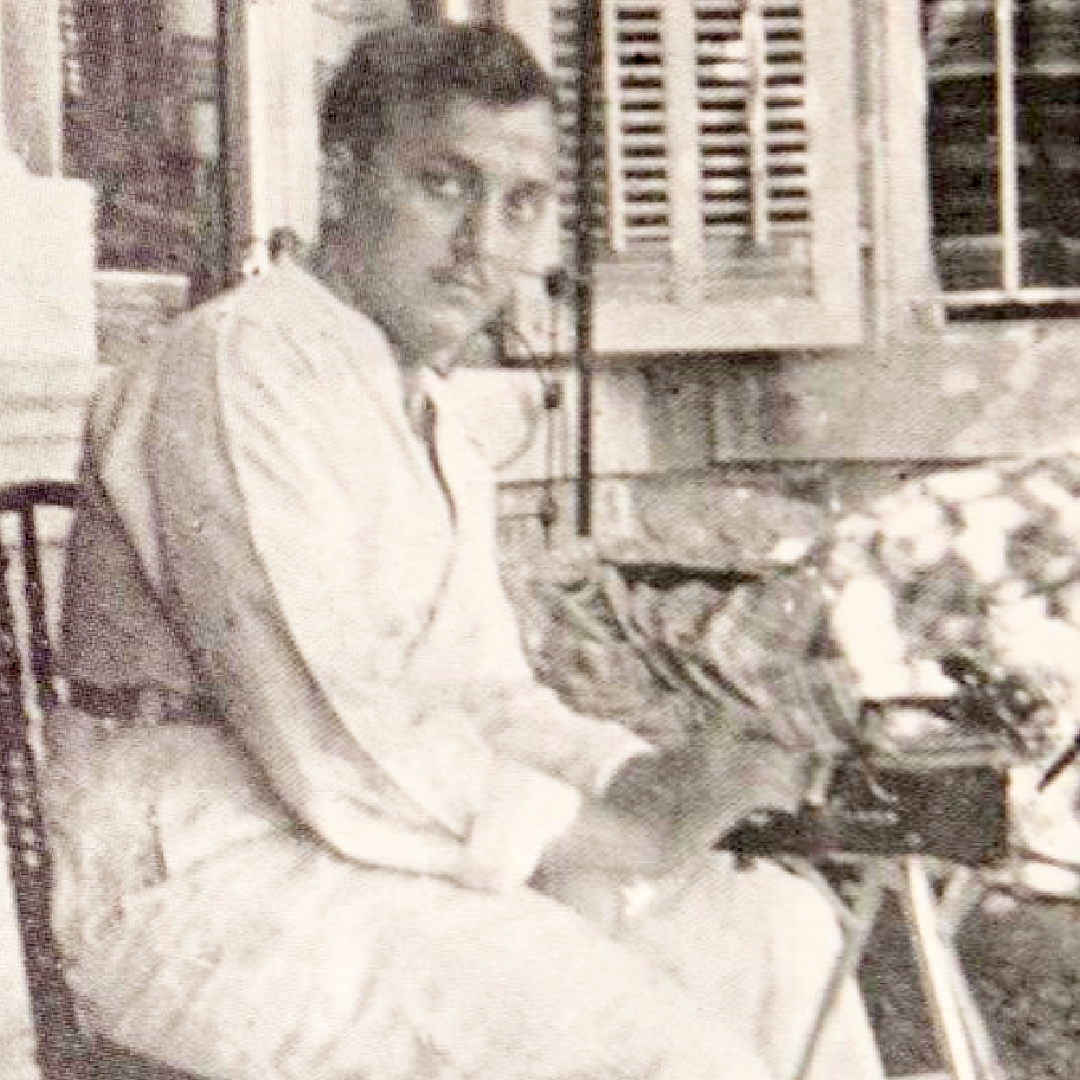
Closeup of Shoghi Effendi in the service of 'Abdu'l-Bahá, hard at work typing on his trusty Corona typewriter. Source: The Priceless Pearl, between pages 104 and 105.
When Shoghi Effendi was composing something, he first wrote everything out by hand in small, lined pads, never large pieces of paper. Once the first draft was completed, he would go over it, and if it was too illegible, he would sit down, patiently, and re-write it in his strong, well-rounded, legible handwriting that had a slight back-hand tilt to it, perhaps because, although he was naturally left-handed in everything, he had been forced to write right-handed in Jesuit school, and it stayed his lifelong habit.
Every manuscript he ever wrote, he typed himself on a small, portable Corona typewriter, with two fingers, editing and making changes as he typed. In essence, the Guardian wrote everything three times: a first draft, a revised draft and a typed version. This methodic, careful way of composing probably goes a long way in explaining why the Guardian’s works are so polished.
This was his technique in English. For his Persian writings, Shoghi Effendi handed a clean original in his exquisite Shikastih Nasta'liq handwriting to his secretary to copy in fine penmanship and send to Iran. Rúḥíyyih Khánum noted a change in the Shoghi Effendi’s handwriting after he became the Guardian:
It has always interested me to note how after he became Guardian his writing in English developed into a slight back-hand; it was always strong, well rounded and legible.
When Shoghi Effendi was editing the sometimes-long letters that Rúḥíyyih Khánum wrote to National Spiritual Assemblies, he was not fussy about sending letters that had corrections on them. He cared that the main idea in the letter was clear and simply indicated missing words of thoughts with a series of X’s.
After the letter was corrected and ready to send, Shoghi Effendi would add his usual post-script, which, in purely Persian style, sometimes climbed up the page, curling around the margins, from page to page.
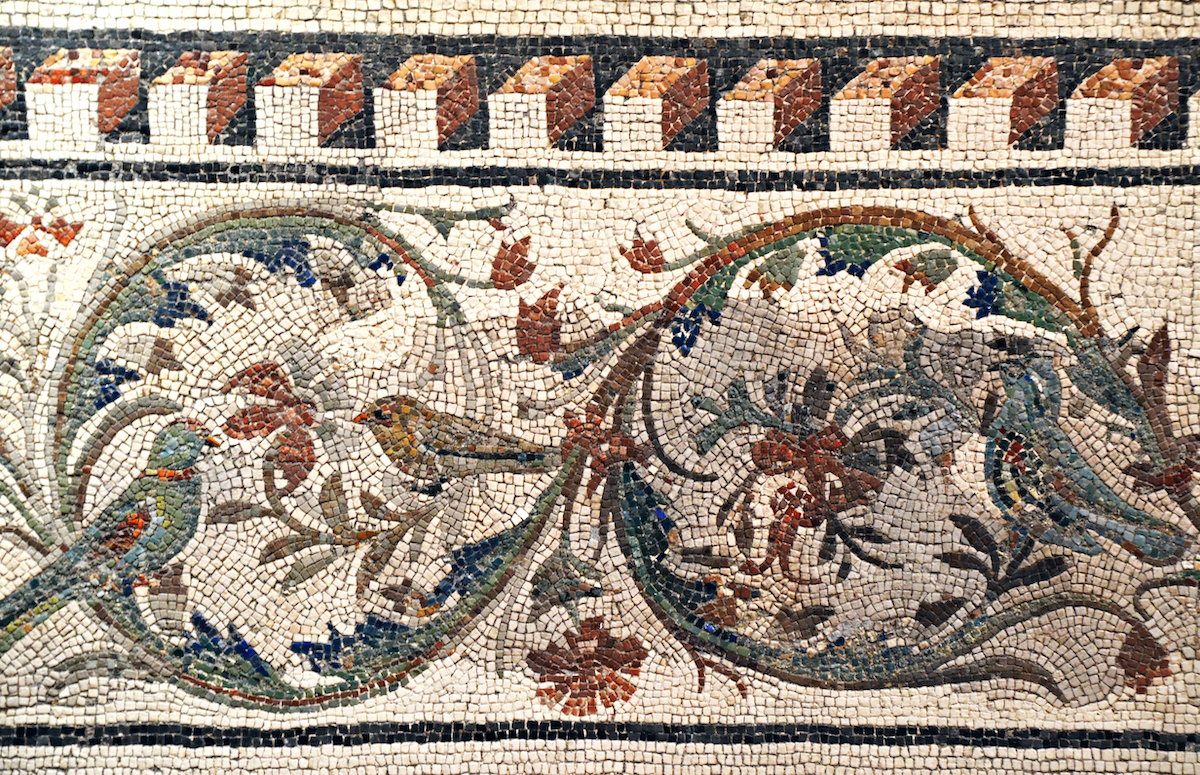
Detail of an ornate mosaic border of acanthus spirals and animals, from the Via Panisperna in Rome, late 2nd – early 1st century B.C. which once decorated the pool of a Roman bath, Centrale Montemartini, which was found in 1888. Source: Wikimedia Commons.
Rúḥíyyih Khánum suggests it is useful to regard Shoghi Effendi’s writings like mosaics, with Shoghi Effendi as the master artist, creating his literary picture with clearly defined, separate pieces. In mosaics, these pieces are called tesserae, and Shoghi Effendi used words in the same, precise way.
For Shoghi Effendi, each word had a place. He built his sentences with a very specific effect in mind, placing words in exactly the right place to create the atmosphere and convey the meaning he wanted.
At times, he would encounter a difficult sentence whose structure seemed, at first, not to be able to accommodate his thought. Instead of changing or rewriting the sentence, Shoghi Effendi, like a mosaicist, would work for hours on this one sentence, speaking it out loud over and over again, never giving up, battling with the sentence and the words, putting one piece of the mosaic in after another until his problem was solved. He was not only determined, but tenacious, resilient, unshakeable, resolute. Rúḥíyyih Khánum stated she never once saw him give up on a difficult sentence.
One of the most admirable qualities of Shoghi Effendi’s writing is fearlessness. He never avoided using a word that had developed a negative connotation in popular culture—often a connotation that wasn’t even related with the word’s original meaning. He used what he considered was the perfect word, and was unapologetic about using proper English.
This means that the Guardian used words in the original proper and exact meaning, regardless of how it sounded to people who didn’t know its original use. The Guardian used the word "conversion" to describe people become Bahá'ís, later referring to them as "converts," and he was not shy of applauding the "missionary zeal" of pioneers in "foreign mission fields," but he was always crystal clear that Bahá'ís had no priests, no missionaries and did not proselytize.

Photo by carole smile on Unsplash.
The Guardian was extremely careful in how he used words, and how others used words. If someone submitted to him another person’s English translation, Shoghi Effendi would never comment or explain before he had the chance to consult the original Persian or Arabic.
Shoghi Effendi was also very careful about the power of words. In the Bahá'í Faith, martyrdom is a station, and Shoghi Effendi did not bestow it lightly. If a Bahá'í was murdered, he would not use the word martyr, unless the person had attained that station. At times during his ministry, Shoghi Effendi elevated a believer to the station of martyr because of the sacrificial spiritual nature of their passing, such as May Maxwell, for example.
When Lidia Zamenhof died, the Guardian cabled:
Heartily approve nationwide observance for dauntless Lidia Zamenhof. Her notable services tenacity modesty unwavering devotion fully merit high tribute American believers. Do not advise however designate her martyr.
But when May Maxwell—Rúḥíyyih Khánum’s mother—died of a heart attack three days after arriving at her pioneering post in Buenos Aires, Argentina, the Guardian elevated her to the rank of martyr immediately:
‘Abdu’l‑Bahá’s beloved handmaid distinguished disciple May Maxwell gathered glory Abhá Kingdom. Her earthly life so rich eventful incomparably blessed worthily ended. To sacred tie her signal services had forged priceless honor martyr’s death. Double crown deservedly won.
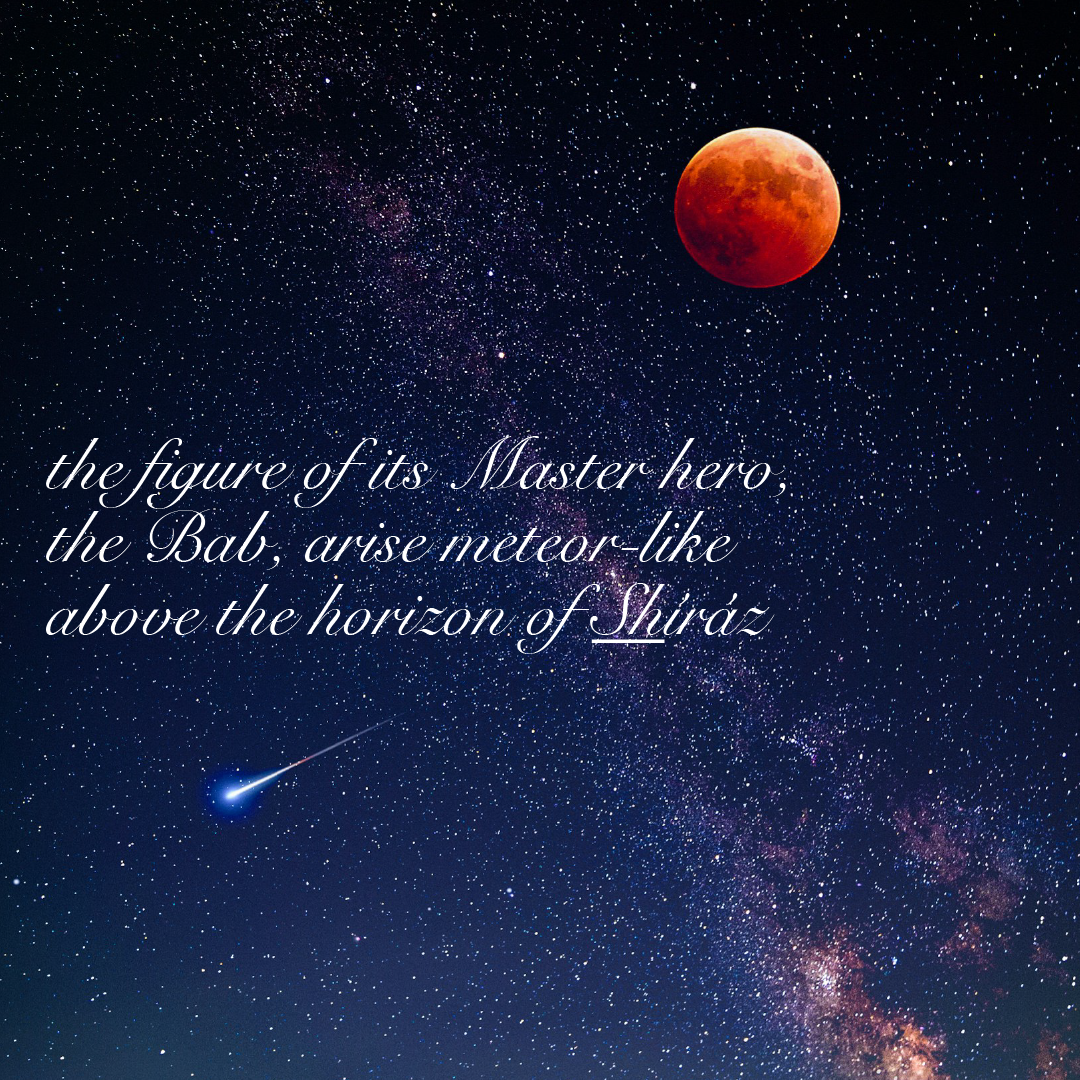
Photo by Nick Owuor (astro.nic.portraits) on Unsplash.
The Guardian had a gift for lyricism, and he was deeply eloquent. This sentence is one of the most beautiful pieces of writing, rich with imagery, filled with spiritual feeling, and expressing a singular moment in religious history, it can be found halfway through the opening paragraph of God Passes By, Chapter I:
We behold, as we survey the episodes of this first act of a sublime drama, the figure of its Master hero, the Bab, arise meteor-like above the horizon of Shiraz, traverse the sombre sky of Persia from south to north, decline with tragic swiftness, and perish in a blaze of glory. We see His satellites, a galaxy of God-intoxicated heroes, mount above that same horizon, irradiate that same incandescent light, burn themselves out with that self-same swiftness, and impart in their turn an added impetus to the steadily gathering momentum of God's nascent Faith.
It is difficult to withhold tears when reading Shoghi Effendi’s description in God Passes By Chapter I of the interment of the remains of the Báb on Mount Carmel. A deeply emotional moment for 'Abdu'l-Bahá, who had waited for this moment for 59 years. The way Shoghi Effendi describes it brings so much feeling, emotion, and sensitivity and it elevates the experience, putting us in the Shrine with our beloved Master:
…when all was finished, and the earthly remains of the Martyr-Prophet of Shiraz were, at long last, safely deposited for their everlasting rest in the bosom of God's holy mountain, 'Abdu'l-Bahá, Who had cast aside His turban, removed His shoes and thrown off His cloak, bent low over the still open sarcophagus, His silver hair waving about His head and His face transfigured and luminous, rested His forehead on the border of the wooden casket, and, sobbing aloud, wept with such a weeping that all those who were present wept with Him.
From the beginning of her marriage with Shoghi Effendi in 1937 until his passing in 1957, Rúḥíyyih Khánum was always present in the room with the Guardian when he wrote his books and long letters and cables.
Shoghi Effendi had always liked to have someone present in the room when he wrote because he wrote out loud, and he liked that someone was there to listen to what he was writing.
This is the main reason why it is always better to read Shoghi Effendi’s letters and books out loud, especially his longer, involved sentences that may not always be clear when read silently. They were written to be read out loud, and often, speaking these sentences out loud gives them their rhythm, and clarifies their meaning.
The way Shoghi Effendi wrote out loud was that he spoke the words as he laid them on the paper. There is little doubt that this particular method in writing comes from Persian and Arabic, where great composition is often chanted as it is written down. We have examples of this from the Báb, Bahá'u'lláh, and 'Abdu'l-Bahá, but it is not common in English, which is traditionally composed silently, and this is perhaps why the Guardian’s writings are so peerless and so exceptional: the way they came into the world is also unique exceptional.
Rúḥíyyih Khánum sometimes commented on the length of Shoghi Effendi’s sentences—there is one sentence in God Passes By which is one and a half pages long. She said that Shoghi Effendi would simply raise his head and look at her with an ever-so-slight look of defiance and rebelliousness in his wonderful ever-changing eyes…and not change the sentence.
There was only one instance that Rúḥíyyih Khánum could ever recall where the Guardian reluctantly admitted it was a long sentence.
But he did not shorten it.
Because this is the most important thing to remember about Shoghi Effendi’s long sentences: they express, from beginning to end, the thought that the Guardian wanted to express. The Guardian almost used sentences like musical instruments. He would make very short, pithy, punchy sentences to mark a dramatic event, like this one in Chapter II of God Passes By:
To allay the rising excitement the Báb was summoned to Tabríz.
On the other hand, if the Guardian was writing to build up excitement, the sentence would not be so much like a drum as a full orchestra with dozens of instruments, working towards a climax, listing achievements, he would use semicolons, and build, and build, and create suspense. A wonderful example of this is a 575-word sentence in Chapter XIX of God Passes By, listing 'Abdu'l-Bahá’s achievements, and beginning with these words—the whole sentence is more than a page long:
The remarkable interview at which ‘Abdu’l‑Bahá, while placing lovingly His hand on the head of Archdeacon Wilberforce, answered his many questions, whilst that distinguished churchman sat on a low chair by His side; the still more remarkable scene when that same Archdeacon, after having knelt with his entire congregation to receive His benediction at St. John’s the Divine, passed down the aisle to the vestry hand in hand with his Guest, whilst a hymn was being sung by the entire assembly standing…
Shoghi Effendi explained to Rúḥíyyih Khánum that he used different techniques. He also loved to build rhythm within paragraphs with very short sentences, one after the other, that cracked like a whip, and pointed out that each technique was effective, but that, when they were combined, they enriched and played against each other extremely effectively. This is a wonderful example of the rhythm imparted by Shoghi Effendi to a series of events with several very short sentences, one after the other, in Chapter I of God Passes By:
The time was the hour before sunset, on the 22nd day of May, 1844. The participants were the Báb, a twenty-five year old Siyyid, of pure and holy lineage, and the young Mullá Ḥusayn, the first to believe in Him. Their meeting immediately before that interview seemed to be purely fortuitous. The interview itself was protracted till the hour of dawn. The Host remained closeted alone with His guest, nor was the sleeping city remotely aware of the import of the conversation they held with each other.
Another technique Shoghi Effendi loved to use, a carryover from Persian and Arabic, and seldom used in English was alliteration. This could even elevate the Guardian’s cables, adding energy from the morphonology of the words to complement the inherent energy of the cables, such as this one from 26 December 1939 with 6 “p’s” in just nine words, in the very last sentence of the cable announcing the interment of the remains of Ásíyih Khánum and Mírzá Mihdí on Mount Carmel.
Listen to how energetic and vigorous this sentence sounds! And listen to the six alliterations of the sound “p”, and how they make the cable pop as you read it out loud, making you feel the urgency in your very being:
Time pressing opportunity priceless potent aid providentially promised unfailing.
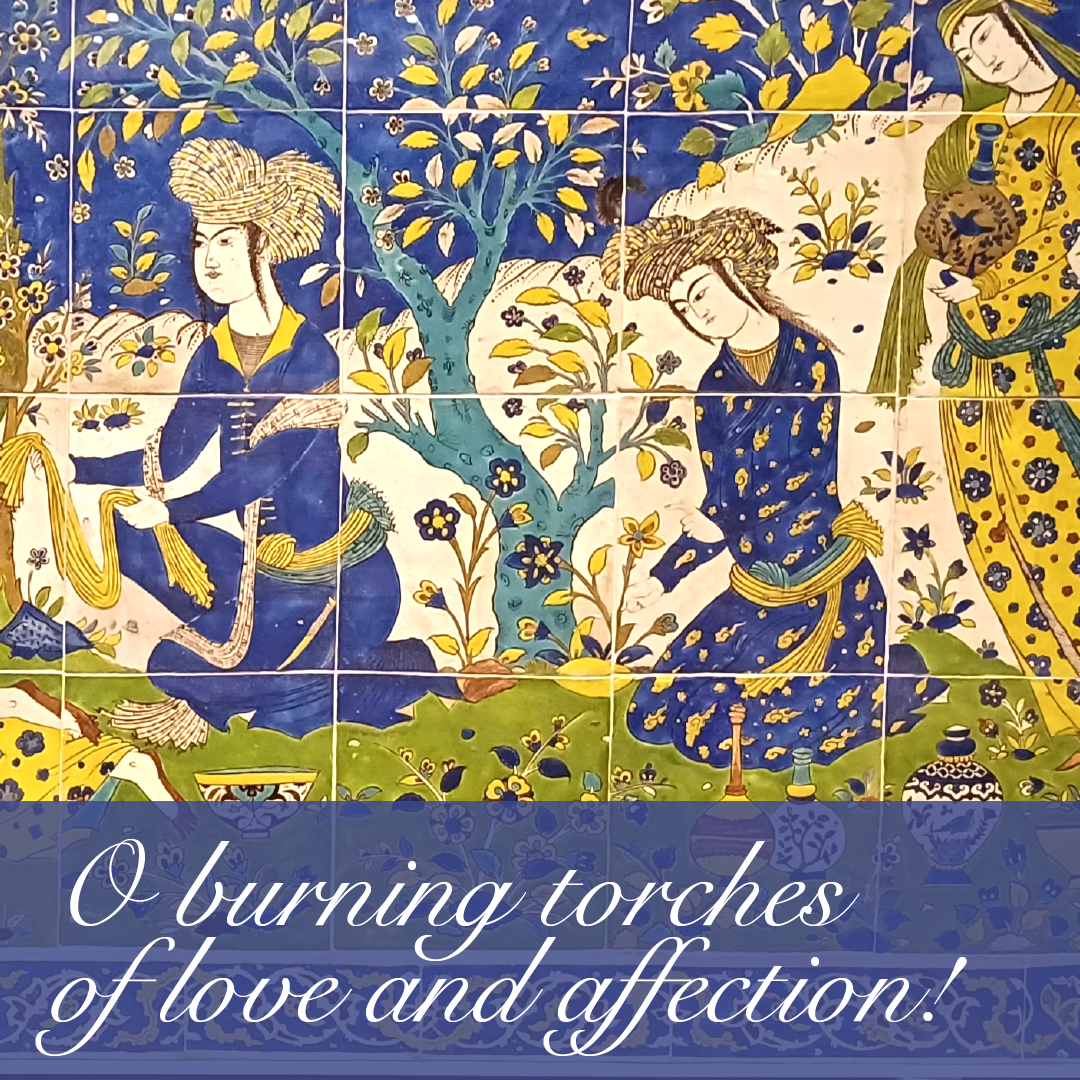
Persian miniature painting on a tile, earthenware under coloured glazes, probably from Isfahan, 17th century CE. Source: World History.
Shoghi Effendi’s writing style in Persian is as extraordinary and luminous to Persian speakers as his English style is to anglophones. What the Guardian’s writings in English and Persian have in common is their uncommon beauty, their surgical precision, with not a single word in excess, their sublime, elevated tone, their distinctive, inimitable, hallmark “Shoghi Effendi” flourish, their systematic structure with a passionate message their heightened, spiritual rhetoric.
In English or in Persian, whatever Shoghi Effendi wrote became a monument to literature because no one but him could wield words and sentences to not only convey a spiritual message, but have a spiritual effect on the readers.
The Guardian wrote his first letter to the friends in Iran on 19 January 1922, the first of 12,038 letters and cables he would write in Arabic and Persian over the 36 years of his ministry. Several years ago, the National Spiritual Assembly of Iran published a compilation of Shoghi Effendi’s letters that ran 3,336 pages long.
Shoghi Effendi’s style in Persian is, as befits his hallowed dual descendance from the families of both the Báb and Bahá'u'lláh, exquisite, dignified and elegant. According to Mr. ‘Alí Nakhjávání, Persian scholars unacquainted with Shoghi Effendi examined his writing style and classified it on the level of great classics of Persian literature, such as Sa’dí.
There were only 5 occasions during his entire ministry that Shoghi Effendi wrote dual English/Persian messages to the Bahá'ís of the West and the East:
- The Passing of the Greatest Holy Leaf;
- The Centenary of the Declaration of the Báb
- The launch of the Ten Year Crusade;
- The Centenary of the Bahá'í Revelation;
- The completion of the superstructure of the Shrine of the Báb.
Shoghi Effendi revealed around 20 prayers in his life, some in English, some in Arabic. A wide variety of provisional and authoritative translations of his writings in Persian is available in Shoghi Effendi: The Range and Power of His Pen, by ‘Alí Nakhjávání, an extraordinary masterclass in the Writings of Shoghi Effendi, first offered in Acuto, Italy in 2006.
Beyond the language difference, the way Shoghi Effendi wrote to the friends in Iran was different. First, in the way that he addressed them. This is an example of an opening line to one of Shoghi Effendi’s letters to the friends in Iran:
O burning torches of love and affection! I send you my salutations from this sacred, luminous and radiant Spot. Your loving memory is always on my mind, filled as I am with joy as I receive your glad tidings. I rejoice at the vastness of your services, remember you in my prayers, and seek for every one of you perpetual confirmations from the Kingdom of Lights.
An important thing to remember is that Persian is such a poetic language that this sentence is not heavy—as it is in English—it is light and musical, and flows off the tongue, otherwise Shoghi Effendi would not have written it.
One of Shoghi Effendi’s concerns was educating the friends in Iran in the Administrative Order, as they were traditionally focused on teaching, and obedience to laws.
A major difference between the nature of the Guardian’s communications with the Bahá'ís of the West and the friends in Iran, was of course, persecution. The Guardian’s heart was repeatedly broken during his ministry with martyrdoms in Iran, and he had to counsel the aggrieved, battered, patient community to continue to be firm and steadfast in the face of imprisonments, dispossession, and death.
The Bahá'ís in the West had so many freedoms that Shoghi Effendi could easily speak to them about the New World Order. Meanwhile, he could not unveil this vision in full to the friends in Iran, and had to introduce this concept slowly, for the first time in 1944, with his Persian abridged version of God Passes By.
There were several instances when the Guardian opened a letter to the friends in Iran invoking the Voice of Bahá'u'lláh or 'Abdu'l-Bahá, as if They were addressing the sorely-oppressed friends while Shoghi Effendi was writing them this letter.
Here is one example, a free rendition published by Mr. ‘Alí Nakhjávání of a letter from Shoghi Effendi dated 19 December 1923:
[‘Abdu’l-Bahá’s] eyes are now directed towards His grieved and afflicted ones. From His exalted station, He is addressing the people of Bahá in this world of dust, and conveying to them these exhortations:
“O my loved ones. Be not grieved and disturbed. Be not listless, nor lose hope and feel distressed. I am with you. I am guarding you in the stronghold of My protection, and at every moment I send you a fresh measure of assistance and confirmation. Be ye faithful to His Cause, and like unto this Servant, be constant till your very last breath, in service to this Faith and in thralldom at His Threshold. Exert your utmost and vie ye with each other. Be not saddened by My passing, nor afraid and unsettled by reason of the changes and chances of this world and its ever-checkered conditions. Do not waver in the Cause of God. Ye are His hosts. Ye are the people of Bahá who are to face the storm of this ordeal, to evince meekness and tenacity, and be adorned with goodly deeds and the ornaments of purity and rectitude of conduct before the eyes of all men.”
Mr. ‘Alí Nakhjávání includes 15 English translations of excerpts from the Guardian’s letters to the friends in Iran in the previously-cited Shoghi Effendi: The Range and Power of His Pen, pages 262 to 275, ranging from authorized translations and authorized provisional translations to free renditions.
These are exquisitely beautiful, intimate letters that would be inconceivable in English, and thanks to Mr. ‘Alí Nakhjávání, we have the bounty of being able to see a side of Shoghi Effendi that English-speakers never would have fully appreciated. We owe him a very great debt.
SOURCES FOR PART XIII
1942: Shoghi Effendi’s idea for the Centennial
The Guardian interprets history
REFERENCES FOR THE PREVIOUS TWO SECTIONS:
The Priceless Pearl, Rúḥíyyih Rabbání, Bahá’í Publishing Trust, London, 1969, page 223.
God Passes By, Shoghi Effendi, Foreword.
George Townshend. David Hofman, George Ronald, Oxford, 1983, Chapter 6: Relationship with the Guardian.
1942: Shoghi Effendi’s research for God Passes By
The Priceless Pearl, Rúḥíyyih Rabbání, Bahá’í Publishing Trust, London, 1969, pages 161 and 223-224.
1942 – 1944: The circumstances under which Shoghi Effendi wrote God Passes By
The Priceless Pearl, Rúḥíyyih Rabbání, Bahá’í Publishing Trust, London, 1969, pages 161 and 223-224.
20 March 1942: Shoghi Effendi is almost killed
The Priceless Pearl, Rúḥíyyih Rabbání, Bahá’í Publishing Trust, London, 1969, pages 163-164 and 222-225.
George Townshend. David Hofman, George Ronald, Oxford, 1983, Chapter 6: Relationship with the Guardian.
The National Archives: AIR 81/12823 (20 March 1942 Haifa plane crash).
Wikipedia: Hawker Hurricane.
Royal Air Force Commands: Flying Officer John Lewis WARD (84018) of the Royal Air Force Volunteer Reserve.
Royal Air Force Commands: Second Lieutenant Charles Henry GIELINK (102104) of the South African Air Force.
During the writing of God Passes By: Shoghi Effendi’s despair
Transcript: The Guardian of the Bahá’í Faith, 21 June 1970, Amatul’Bahá Rúḥíyyih Khánum, transcript from a cassette tape published by the Bahá’í Publishing Trust, Timestamp: 1:11:13.
Transcript of: Amatul’Bahá Rúḥíyyih Khánum’s Address to the Sixth Annual Association for Bahá’í Studies Conference, Canada, 1981, Timestamp: 01:04:31.
1942 – 1943: Writing God Passes By
The Priceless Pearl, Rúḥíyyih Rabbání, Bahá’í Publishing Trust, London, 1969, pages 163-164 and 222-225.
George Townshend. David Hofman, George Ronald, Oxford, 1983, Chapter 6: Relationship with the Guardian.
27 February 1943 – February 1944: Collaborating with George Townshend on God Passes By
The introduction to God Passes By
REFERENCES FOR THE PREVIOUS TWO SECTIONS:
George Townshend. David Hofman, George Ronald, Oxford, 1983, Chapter 6: Relationship with the Guardian.
George Townshend’s original introduction to God Passes By Shoghi Effendi.
End of December 1943: Typing out God Passes By
The Priceless Pearl, Rúḥíyyih Rabbání, Bahá’í Publishing Trust, London, 1969, page 128-129, 163-164, 201, 222-225.
Reflections on the Bahá’í Faith, Brent Poirier: an encouraging letter from Shoghi Effendi to the Bahá’ís of California (4 September 2010).
Shoghi Effendi Through the Pilgrim’s Eye, Volume 2 The Ten Year Crusade, 1953-1963. Earl Redman, George Ronald, Oxford, 2016, Kindle Edition, Locations 2387-2632.
Touch-type Read and Spell: The touch typing method vs. two-finger typing
George Townshend. David Hofman, George Ronald, Oxford, 1983, Chapter 6: Relationship with the Guardian.
Transcript of: Talk with pioneers in Petionville, Haiti, 3 November 1981, Timestamp: 00:09:55.
Summer 1942: Lydia Zamenhof murdered in a Nazi concentration camp
Wikipedia: Lydia Zamenhof.
Citadel of Faith, Shoghi Effendi, 23 January 1946.
Around December 1942: The monument for May Maxwell
The Priceless Pearl, Rúḥíyyih Rabbání, Bahá’í Publishing Trust, London, 1969, pages 149-150 and 154-155.
Wikipedia: May Maxwell.
This Decisive Hour, Shoghi Effendi, Beloved Handmaid, 3 March 1940.
Maxwells of Montreal, The: Middle Years 1923-1937 Late Years 1937-1952. Violette Nakhjavani, George Ronald, Oxford (2011), Kindle Edition, Locations 7156-7748.
A Tribute to Amatul’Bahá Ruḥíyyíh Khánum, Violette Nakhjávání.
1943: Shoghi Effendi’s charitable contributions and generosity to local causes
The Priceless Pearl, Rúḥíyyih Rabbání, Bahá’í Publishing Trust, London, 1969, pages 294-297
Riḍván 1944: The Achievements of the first Seven Year Plan (1937 – 1944)
The Priceless Pearl, Rúḥíyyih Rabbání, Bahá’í Publishing Trust, London, 1969, pages 386-367.
Unfolding Destiny, Shoghi Effendi, Unconquerable Power: Letter dated 12 August 1941.
How the Guardian composed the Tablet of the Centennial
The Priceless Pearl, Rúḥíyyih Rabbání, Bahá’í Publishing Trust, London, 1969, pages 224-225.
21 March 1944 (Naw-Rúz 101 B.E.): Lawḥ-i-Qarn (The Tablet of the Centennial)
Naw-Rúz 1944 Persian message to the Bahá’ís in Iran, Shoghi Effendi.
Dr. ‘Alí Muḥammad Varqá’s Introduction to the Tablet of the Centennial found in Dr. Khazeh Fananapazir’s translation.
Tablet of the Centennial, Shoghi Effendi, provisional translation by Dr. Khazeh Fananapazir (1998).
Email communication with Fuad and Faruq Izadinia, 8 November 2023 containing conformation by “Persian version of God Passes By” is meant the Lawḥ-i-Qarn or Qarn-i-Badí’ (The Tablet of the Centennial).
Email communication with Adel Shafipour, 10 November 2023 confirming Jinab Foroutan was ʻAlí-Akbar Furútan and providing two non-Bahá’í Persian academic sources who expressed their admiration for the Tablet of the Centennial: Ostad Saied Nafisi and Badi’ Zaman Froozanfar.
Wikipedia: ʻAlí-Akbar Furútan.
Wikipedia: Saeed Nafisi.
Wikipedia: Badiozzaman Forouzanfar.
The structure of the Tablet of the Centennial
The content of the Tablet of the Centennial
The closing prayer of the Tablet of the Centennial
REFERENCES FOR THE PREVIOUS THREE SECTIONS:
Naw-Rúz 1944 Persian message to the Bahá’ís in Iran, Shoghi Effendi.
Dr. ‘Alí Muḥammad Varqá’s Introduction to the Tablet of the Centennial found in Dr. Khazeh Fananapazir’s translation.
Tablet of the Centennial, Shoghi Effendi, provisional translation by Dr. Khazeh Fananapazir (1998).
Excerpt from the provisional translation of the Tablet of the Centennial
Tablet of the Centennial, Shoghi Effendi, provisional translation by Dr. Khazeh Fananapazir (1998).
23 May 1944: A triple Centennial
The Priceless Pearl, Rúḥíyyih Rabbání, Bahá’í Publishing Trust, London, 1969, pages 388-390.
The National World War II Museum New Orleans: Explore WWII History.
23 May 1944: The Centennial in the Holy Land
The Bahá’í World Volume 10 (1944-1946): Centenary Celebrations in the Holy Land, pages 150-157.
22 and 23 May 1944: The Centennial in Shíráz
The Priceless Pearl, Rúḥíyyih Rabbání, Bahá’í Publishing Trust, London, 1969, pages 388-390.
The Bahá’í World Volume 10 (1944-1946): Persia Celebrates the First Hundred Years, pages 181-188.
23 May 1844: The All-American Centennial in Chicago and Wilmette
The Bahá’í World Volume 10 (1944-1946): Bahá’í Centenary Celebrations in the United States of America, pages 158-181.Violetta Zein, The Extraordinary Life of ‘Abdu’l-Bahá Part VI: Journeys to the West II: The United States and Canada (1912): 18 June 1912 – BROOKLYN – The filming and recording of ‘Abdu’l-Bahá: A beautiful story of perspective.
23 May 1944: The Centennial in the United Kingdom
The Bahá’í World Volume 10 (1944-1946): Bahá’í Centenary Celebrations in the British Isles, pages 188-201.
Unfolding Destiny, Shoghi Effendi, Cable dated 21 April 1943, pages 157-158.
Wikipedia: Ronald Storrs.
Wikipedia: Herbert Kitchener, 1st Earl Kitchener.
23 May 1944: The Centennial in Australia
Messages to the Antipodes, Shoghi Effendi, 29 July 1943.
The Bahá’í World Volume 10 (1944-1946): Bahá’í Centenary Celebrations in Australia, pages 222-228.
Bahaipedia: Clara Dunn.
Bahaipedia: Hyde Dunn.
23 May 1944: The Centennial in Egypt
The Bahá’í World Volume 10 (1944-1946): Bahá’í Centenary Celebrations in Egypt pages 208-217.
23 May 1944: The Centennial in India
The Bahá’í World Volume 10 (1944-1946): Bahá’í Centenary Celebrations in India, pages 202-208.
Messages of Shoghi Effendi to the Indian subcontinent, Shoghi Effendi, Letter dated 22 June 1943, page 238.
The World Religion: A summary of Its Aims, Teachings and History, Shoghi Effendi, (From a letter written by Shoghi Effendi to the High Commissioner for Palestine, June 1933)
23 May 1944: The Centennial in Iraq
The Bahá’í World Volume 10 (1944-1946): Bahá’í Centenary Celebrations in ‘Iráq, pages 217-222.
The Dawn-Breakers, Nabíl, Chapter III: The Declaration of the Báb, page 61.
23 May 1944: The Centennial in Latin America
The Bahá’í World Volume 10 (1944-1946): Latin-America Celebrates the Bahá’í Centenary, pages 228-233.
Preparing God Passes By for publication
The Priceless Pearl, Rúḥíyyih Rabbání, Bahá’í Publishing Trust, London, 1969, pages 163-164 and 222-225.
George Townshend. David Hofman, George Ronald, Oxford, 1983, Chapter 6: Relationship with the Guardian.
George Townshend’s search for a title
George Townshend cables the title of God Passes By to the Guardian
REFERENCES FOR THE PREVIOUS TWO SECTIONS:
George Townshend. David Hofman, George Ronald, Oxford, 1983, Chapter 6: Relationship with the Guardian.
YouTube Talk: Talk About the Life of the Hand of The Cause of God George Townshend, Timestamp: 33:49, Adib Taherzadeh.
God Passes By: The “essence of essences”
The Priceless Pearl, Rúḥíyyih Rabbání, Bahá’í Publishing Trust, London, 1969, pages 196 and 222-223.
First period: The ministry of the Báb (1844 – 1853)
Third period: The Ministry of ‘Abdu’l‑Bahá (1892 – 1921)
Fourth period: The Inception of the Formative Age of the Bahá’í Faith (1921 – 1944)
REFERENCES FOR THE PREVIOUS FIVE STORIES:
The Priceless Pearl, Rúḥíyyih Rabbání, Bahá’í Publishing Trust, London, 1969, pages 196 and 222-223.
Shoghi Effendi: The Range and Power of His Pen, ‘Alí Nakhjávání, Acuto 2006, Casa Editrice Bahá’í, pages 118-128.
God Passes By, Shoghi Effendi, Foreword.
God Passes By, Shoghi Effendi, Retrospect and Prospect.
15 November 1944: At long last, the publication
The Priceless Pearl, Rúḥíyyih Rabbání, Bahá’í Publishing Trust, London, 1969, page 224.
George Townshend. David Hofman, George Ronald, Oxford, 1983, Chapter 6: Relationship with the Guardian.
Bahá’í News, Issue 168: March 1944.
Bahá’í News, Issue 169: July 1944.
Bahá’í News, Issue 170: September 1944.
Bahá’í News, Issue 171: November 1944.
Bahá’í News, Issue 172: December 1944.
Bahá’í News, Issue 173: February 1945.
God Passes By, Shoghi Effendi.
The Covenant of Bahá’u’lláh, Adib Taherzadeh, George Ronald, Oxford, 1992: Chapter 32: The Faithless Relatives of Shoghi Effendi.
Bahá’í News, Issue 172 (December 1944).
Messages to America, Shoghi Effendi, Cablegram dated 19 November 1944, pages 75-76.
The Covenant of Bahá’u’lláh, Adib Taherzadeh, George Ronald, Oxford, 1992: Chapter 32: The Faithless Relatives of Shoghi Effendi.
The Priceless Pearl, Rúḥíyyih Rabbání, Bahá’í Publishing Trust, London, 1969, page 124.
Bahá’í News, Issue 174 (April-May 1945).
The Priceless Pearl, Rúḥíyyih Rabbání, Bahá’í Publishing Trust, London, 1969, page 124.
8 May 1945: The end of the War
Wikipedia: Victory in Europe Day.
9 May 1945: A joyful cable from the Guardian
REFERENCES FOR THE PREVIOUS TWO STORIES:
The Priceless Pearl, Rúḥíyyih Rabbání, Bahá’í Publishing Trust, London, 1969, pages 185-186.
Wikipedia: Victory in Europe Day.
This Decisive Hour, Shoghi Effendi, Letter of 9 May 1945: A Single, Organically United World Commonwealth.
National WWII Museum New Orleans: The Holocaust.
National WWII Museum New Orleans: Research Starters: Worldwide Deaths in World War II.
Encyclopedia Britannica: The blast of World War II.
Wikipedia: Attack on Pearl Harbor.
1945: The effect of the war on Shoghi Effendi
The Priceless Pearl, Rúḥíyyih Rabbání, Bahá’í Publishing Trust, London, 1969, page 186.
“Right after” the end of World War II: Shoghi Effendi and Rúḥíyyih Khánum in Scotland
The Priceless Pearl, Rúḥíyyih Rabbání, Bahá’í Publishing Trust, London, 1969, page 186.
Transcript of Amatul’Bahá Rúḥíyyih Khánum’s talk in Edinburgh, (1981) Timestamp: 00:01:35.
Undated: Shoghi Effendi and Rúḥíyyih Khánum in London
The Priceless Pearl, Rúḥíyyih Rabbání, Bahá’í Publishing Trust, London, 1969, pages 37-38.
6 July 1945: Shoghi Effendi’s “most precious” ‘Alí-Aṣghar Qazvíní
7 July 1945: ‘Alí-Aṣghar’s last gift to his Guardian
10 July 1945: “The Lion of the Forest of God”: The passing of ‘Alí Asghar
11 July 1945: The funeral of ‘Alí-Aṣghar Qazviní
REFERENCES FOR THE PREVIOUS FOUR STORIES:
The Priceless Pearl, Rúḥíyyih Rabbání, Bahá’í Publishing Trust, London, 1969, pages 165-166.
The Bahá’í World, Volume X, pages 532−533.
The Priceless Pearl, Rúḥíyyih Rabbání, Bahá’í Publishing Trust, London, 1969, pages 401-402.
This Decisive Hour, Shoghi Effendi, 23 April 1946 cable, “Inauguration of Second Seven Year Plan.”
This Decisive Hour, Shoghi Effendi, 10 August 1945 letter, “A New Phase of Human Evolution.”
1944: The Guardian’s infallibility
Bahá’í Library Online: Letter from the Universal House of Justice dated 25 July 1974, addressed to an individual.
The Priceless Pearl, Rúḥíyyih Rabbání, Bahá’í Publishing Trust, London, 1969, pages 436-437.
A Basic Bahá’í Dictionary, A, Wendi Momen, George Ronald, Oxford, 1989: Infallibility.
13 May 1945: The Guardian’s full jurisdiction over all National Spiritual Assemblies
The Priceless Pearl, Rúḥíyyih Rabbání, Bahá’í Publishing Trust, London, 1969, page 299.
Letters to Australia and New Zealand, by Shoghi Effendi, Australia: Australian Bahá’í Publishing (1971). Letter on behalf of Shoghi Effendi, 13 May 1945, pages 54-57.
1944: A World Survey of the Bahá’í Faith: 1844 – 1944
The Priceless Pearl, Rúḥíyyih Rabbání, Bahá’í Publishing Trust, London, 1969, pages 390-397.
Bahá’í Library Online: Notes on Pilgrimage to Haifa, 15 – 23 April 1957, Alice Dudley.
A World Survey of the Bahá’í Faith: 1844 – 1944, Shoghi Effendi.
1945: Distinguished Pioneer of the Faith: The passing of Hand of the Cause Siyyid Muṣṭafá Rúmí
Bahaipedia: Siyyid Muṣṭafá Rúmí.
Violetta Zein, The Extraordinary Life of ‘Abdu’l-Bahá Part IV: The Center of the Covenant: Around 1897 – ‘Abdu’l-Bahá orders the construction of a sarcophagus and a coffin for the Remains of the Báb.
Shoghi Effendi’s love of words
The Priceless Pearl, Rúḥíyyih Rabbání, Bahá’í Publishing Trust, London, 1969, pages 196-198.
Shoghi Effendi’s love for Gibbon’s style
The Priceless Pearl, Rúḥíyyih Rabbání, Bahá’í Publishing Trust, London, 1969, pages 37-38 and 200-201.
Wikipedia: The History of the Decline and Fall of the Roman Empire
The unfolding of Shoghi Effendi’s writing style
The Priceless Pearl, Rúḥíyyih Rabbání, Bahá’í Publishing Trust, London, 1969, pages 73-75.
Shoghi Effendi’s three literary animating forces
Shoghi Effendi: Recollections, Ugo Giachery, George Ronald, 1973, pages 31-32.
Shoghi Effendi’s literary gifts
Shoghi Effendi: Recollections, Ugo Giachery, George Ronald, 1973, pages 31-32.
Shoghi Effendi’s method of writing
The Priceless Pearl, Rúḥíyyih Rabbání, Bahá’í Publishing Trust, London, 1969, pages 201-202.
‘Alí Nakhjávání answering questions at the House of Worship in Wilmette, 2012. Question 3: Was the Guardian left-handed?
Shoghi Effendi the word mosaicist
The Priceless Pearl, Rúḥíyyih Rabbání, Bahá’í Publishing Trust, London, 1969, page 198.
Transcript of: On Shoghi Effendi: Guardian of the Bahá’í Faith, 21 June 1970, Rúhíyyih Khánum, Speaking at the National Bahá’í Youth Conference in Evanston, Illinois (from a cassette tape published by the Bahá’í Publishing Trust), Timestamp on transcript and audio: 21:29.
The Guardian’s care for words and Writings
The Priceless Pearl, Rúḥíyyih Rabbání, Bahá’í Publishing Trust, London, 1969, page 204.
This Decisive Hour, Shoghi Effendi, [circa 23 January 1946]: Lidia Zamenhof.
This Decisive Hour, Shoghi Effendi, 3 March 1940: Beloved Handmaid.
Wikipedia: May Maxwell.
The literary poetry of Shoghi Effendi
The Priceless Pearl, Rúḥíyyih Rabbání, Bahá’í Publishing Trust, London, 1969, pages 198-200.
God Passes By, Shoghi Effendi, Chapter I (first paragraph).
God Passes By, Shoghi Effendi, Chapter I (interment of the Báb’s remains).
The musical quality of Shoghi Effendi’s sentences
The Priceless Pearl, Rúḥíyyih Rabbání, Bahá’í Publishing Trust, London, 1969, pages 197-198.
God Passes By, Shoghi Effendi, Chapter II.
God Passes By, Shoghi Effendi, Chapter XIX.
God Passes By, Shoghi Effendi, Chapter I.
This Decisive Hour, Shoghi Effendi, 26 December 1939: Interment Beloved Remains.
Shoghi Effendi’s writings in Persian and Arabic
Shoghi Effendi: The Range and Power of His Pen, ‘Alí Nakhjávání, Acuto 2006, Casa Editrice Bahá’í, pages 262-278 and 294-295 and 296-299.
![]()
 The Guardian interprets history
The Guardian interprets history
